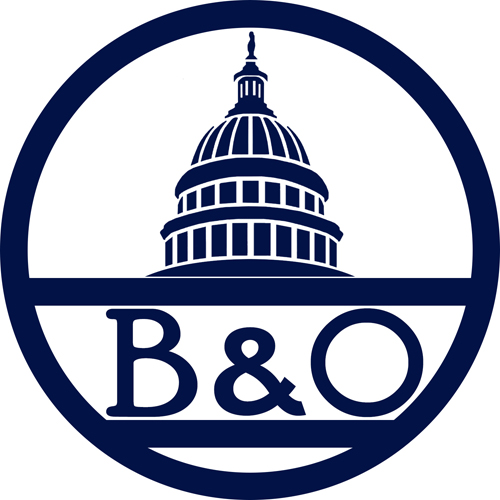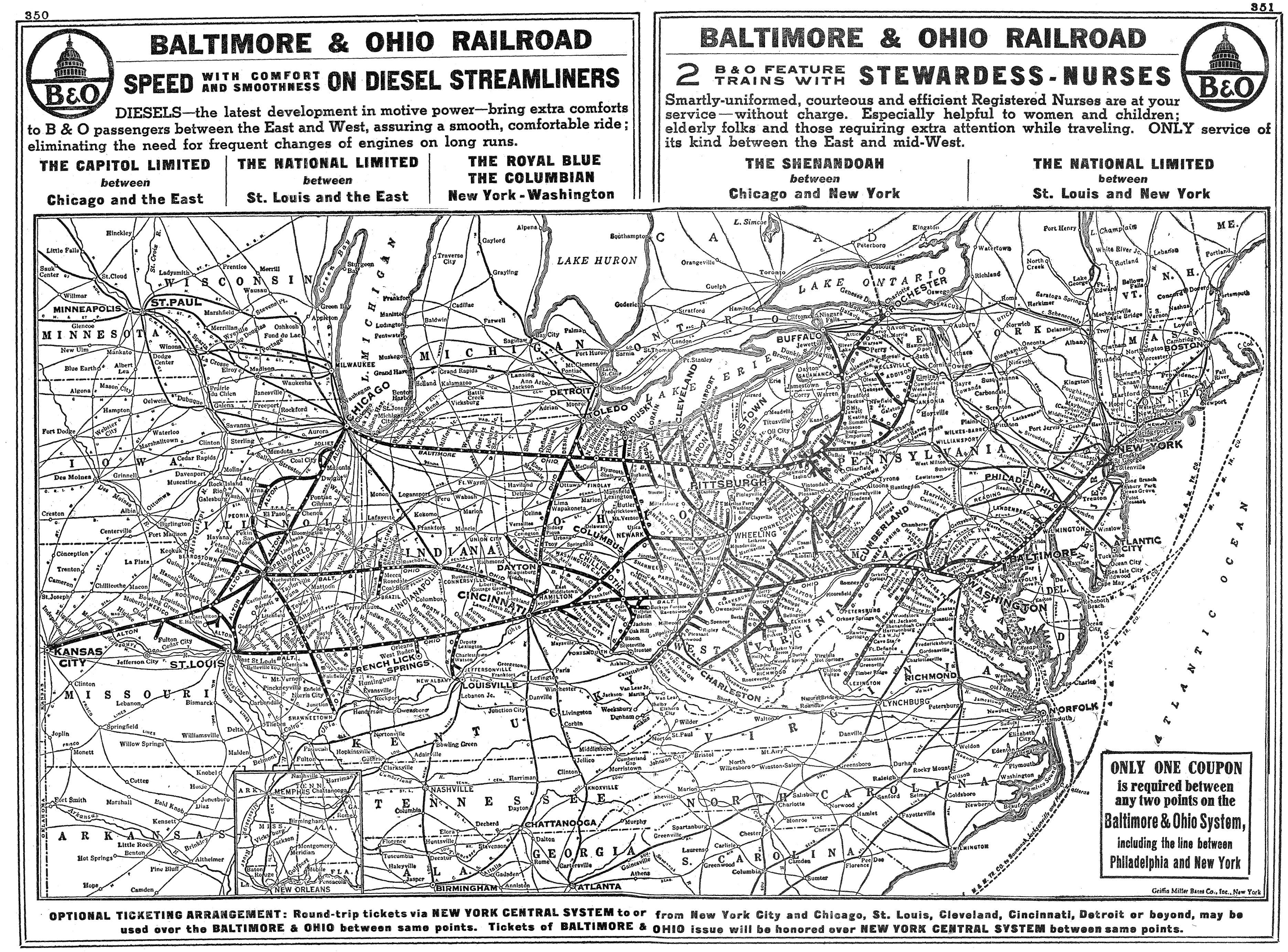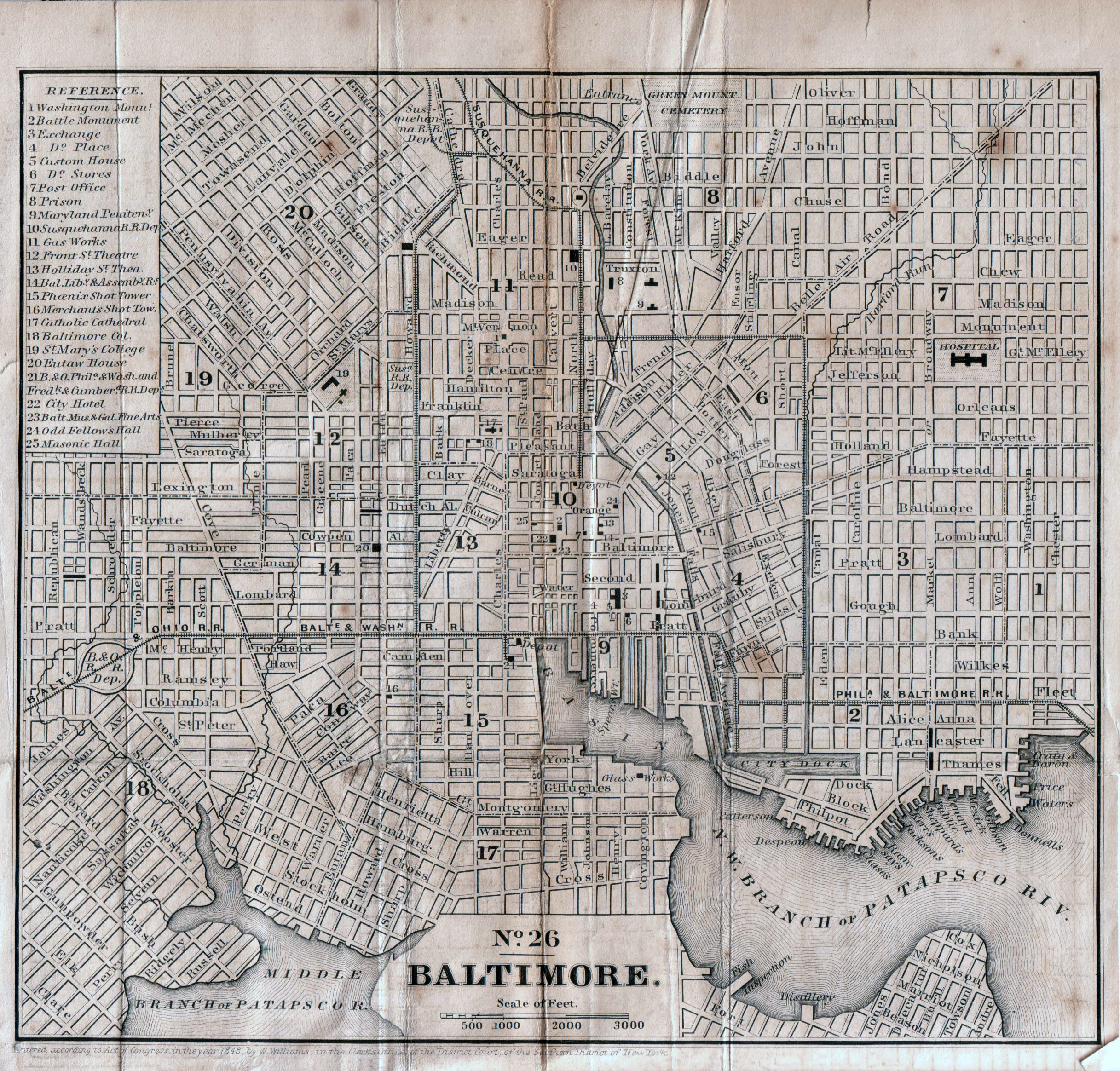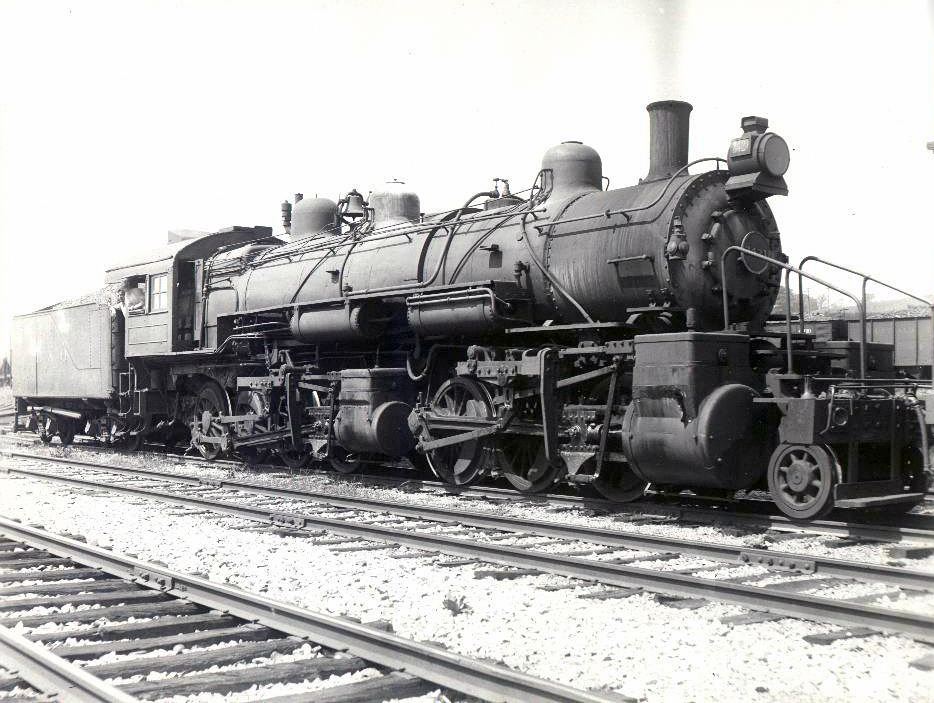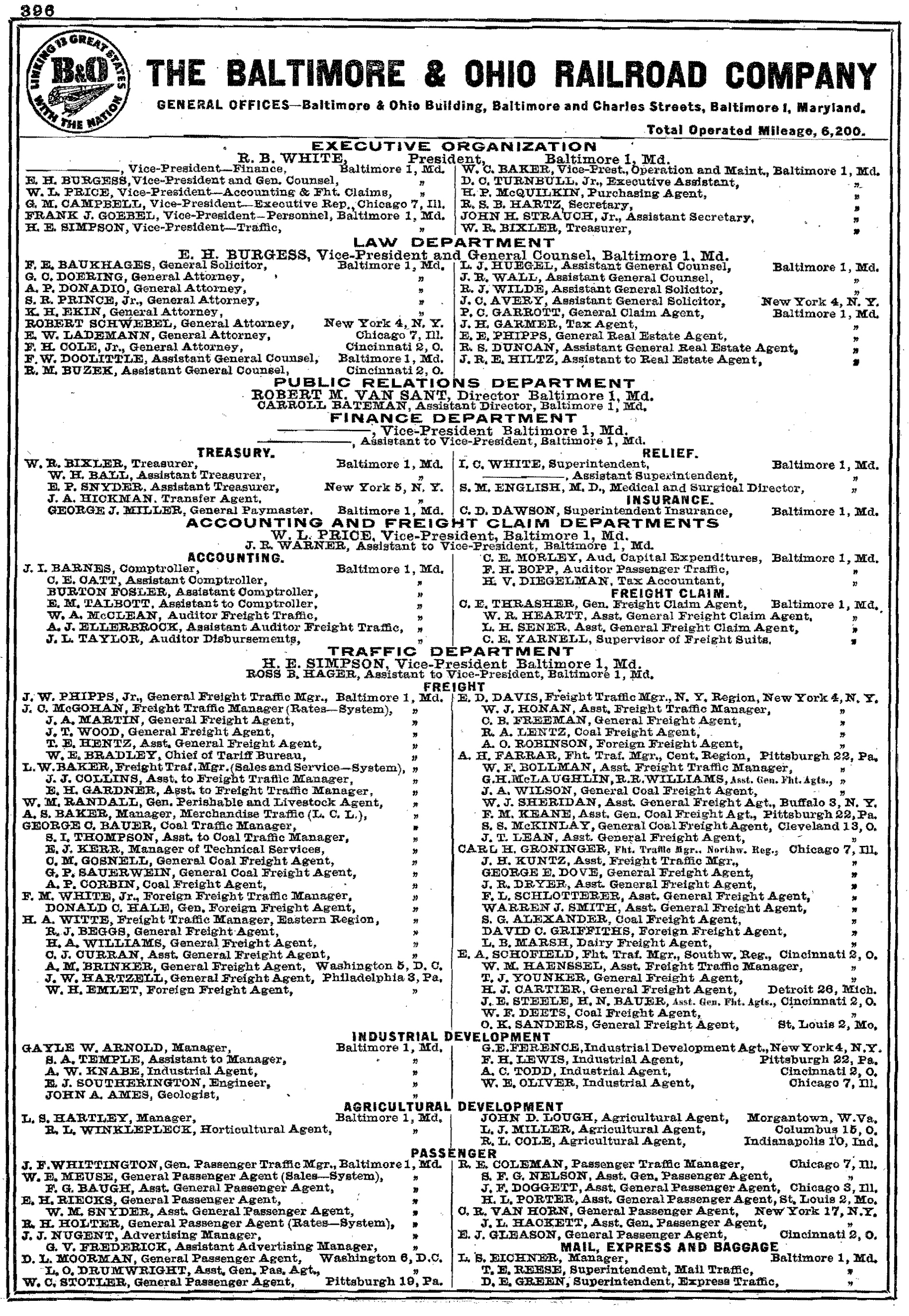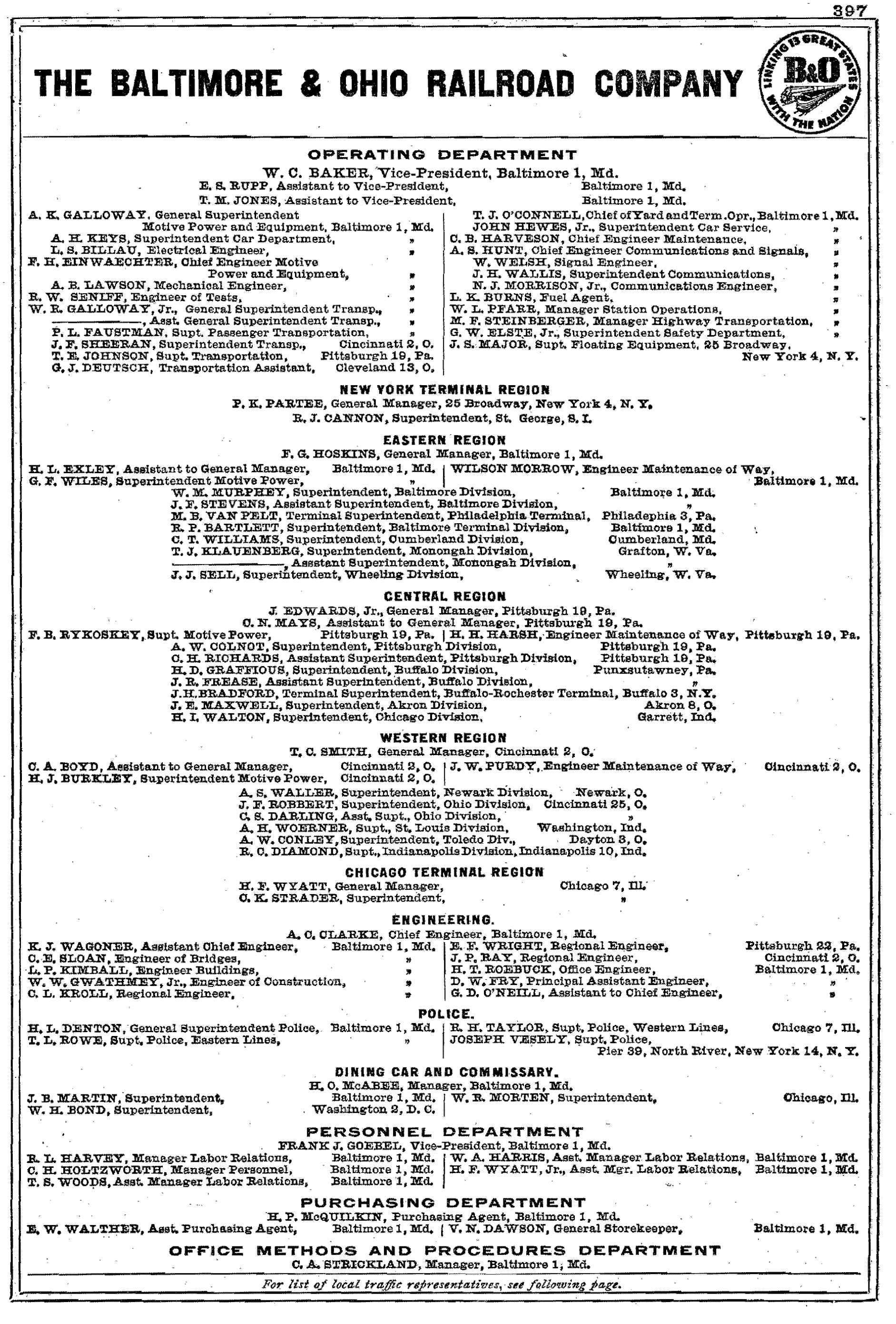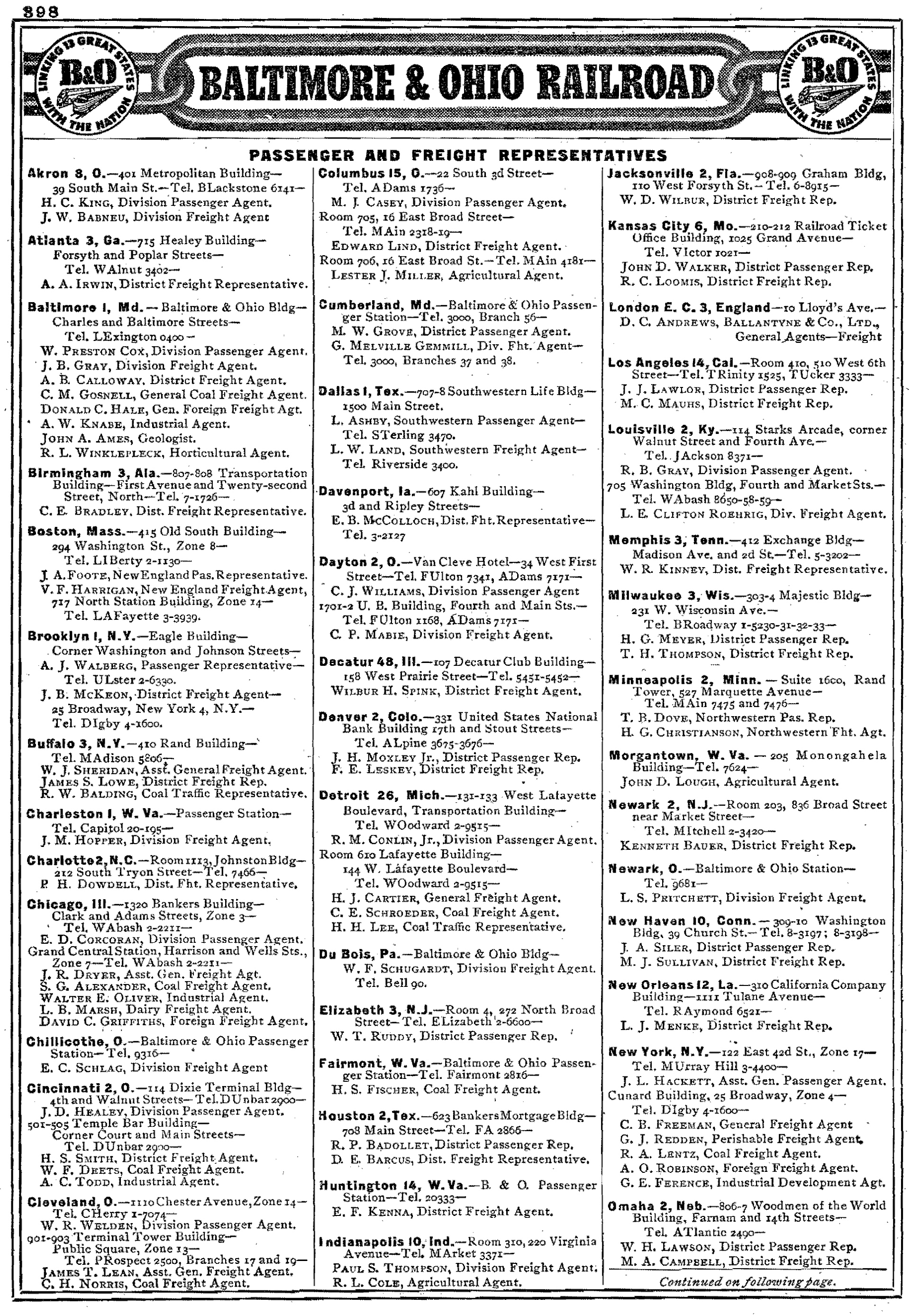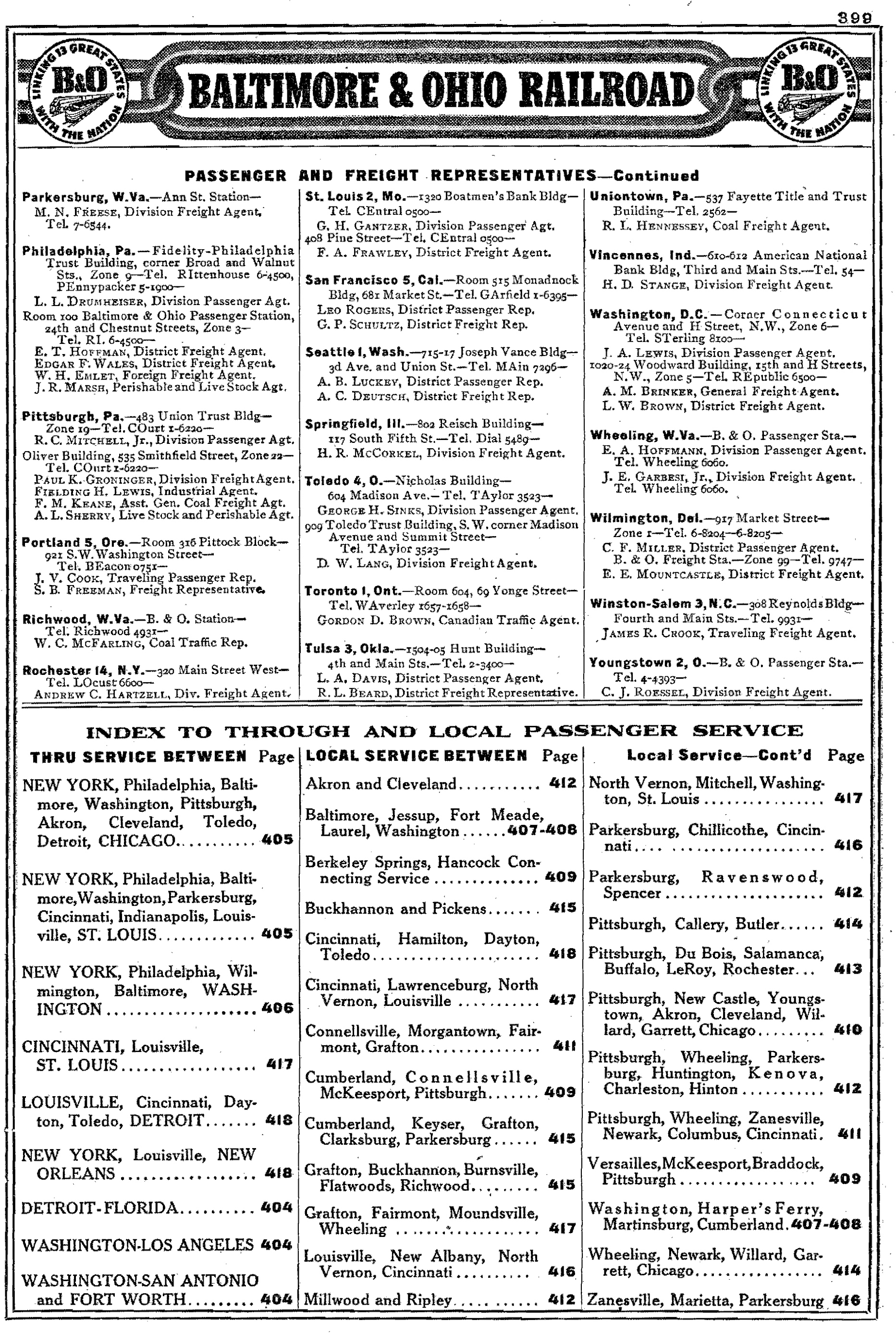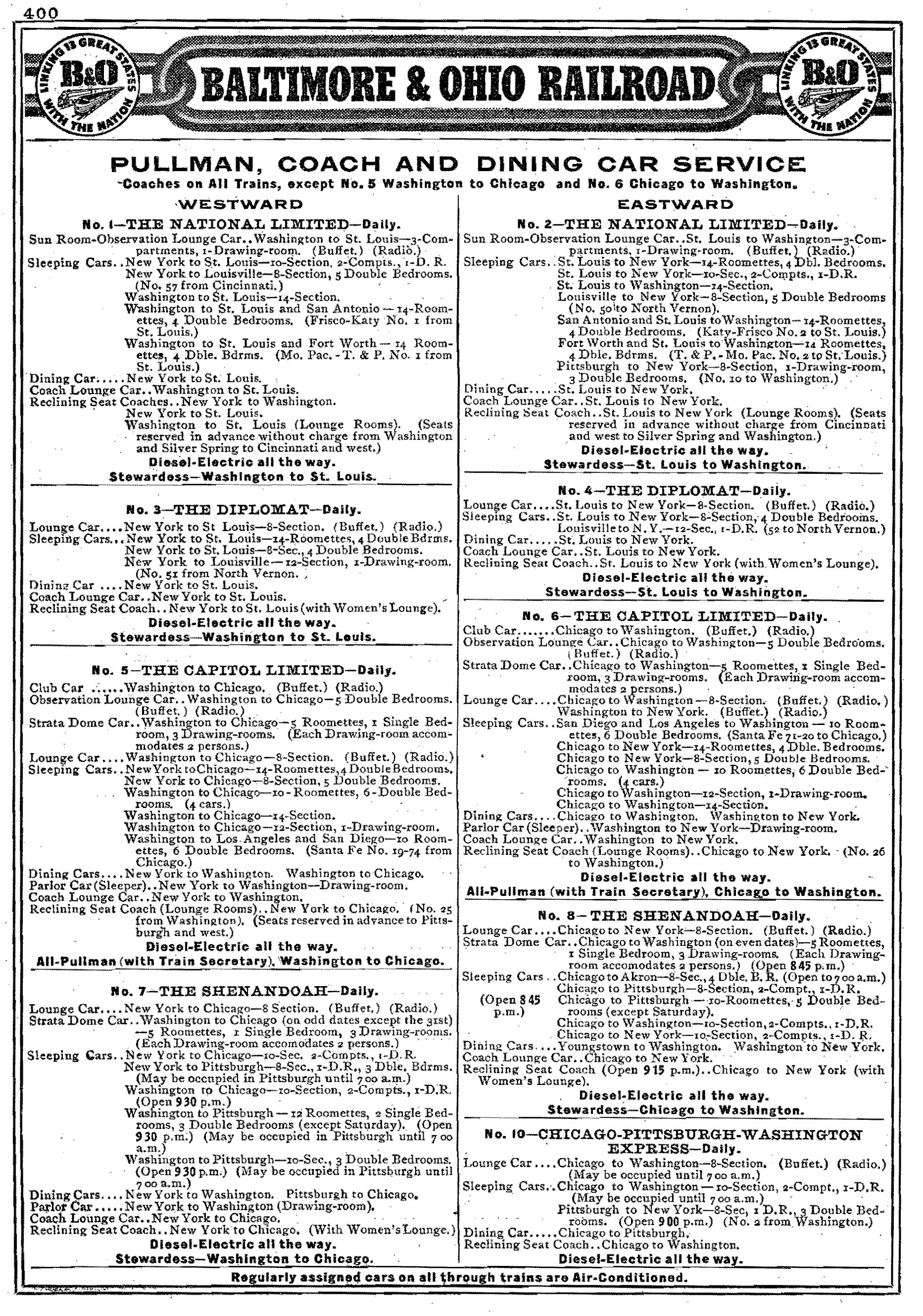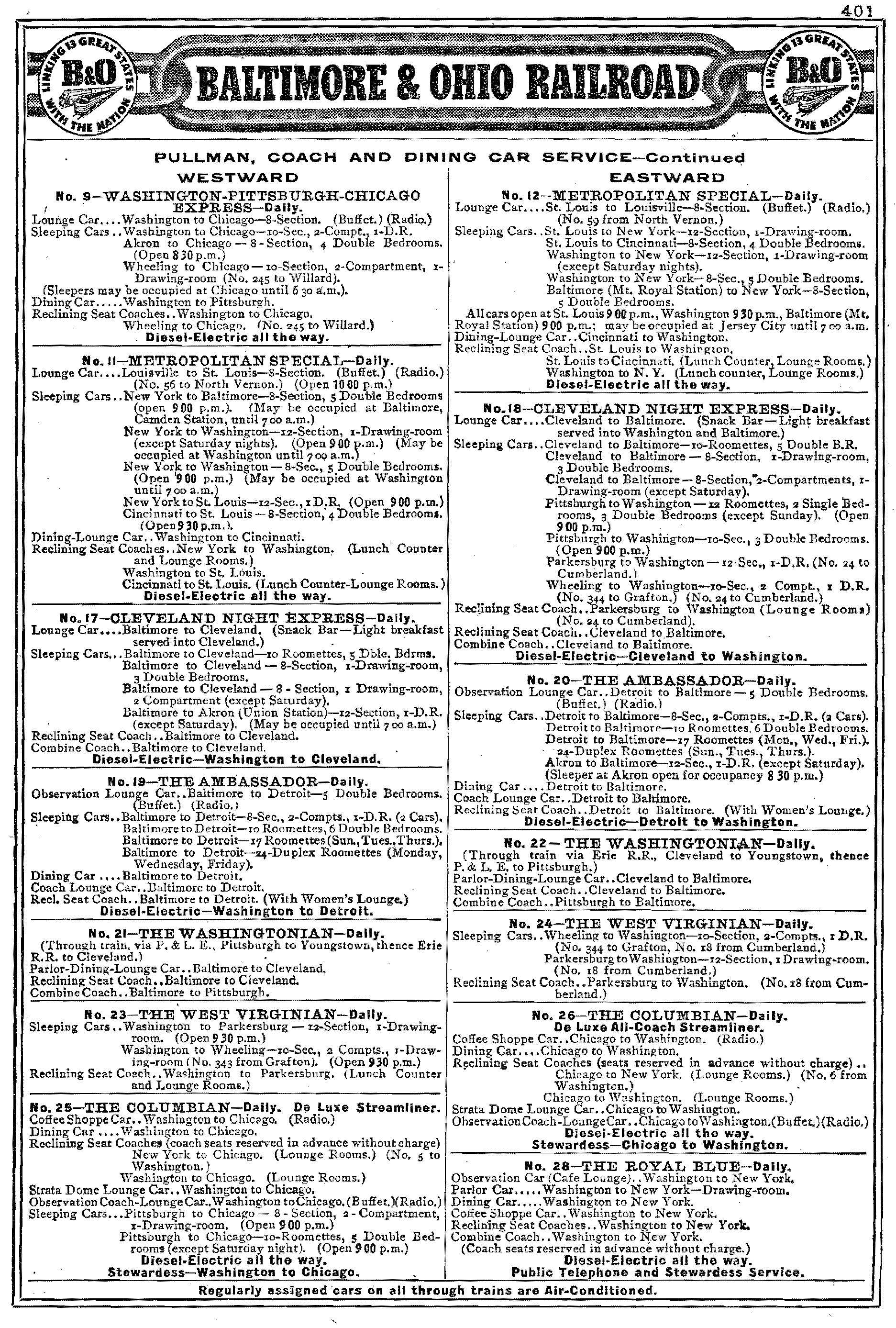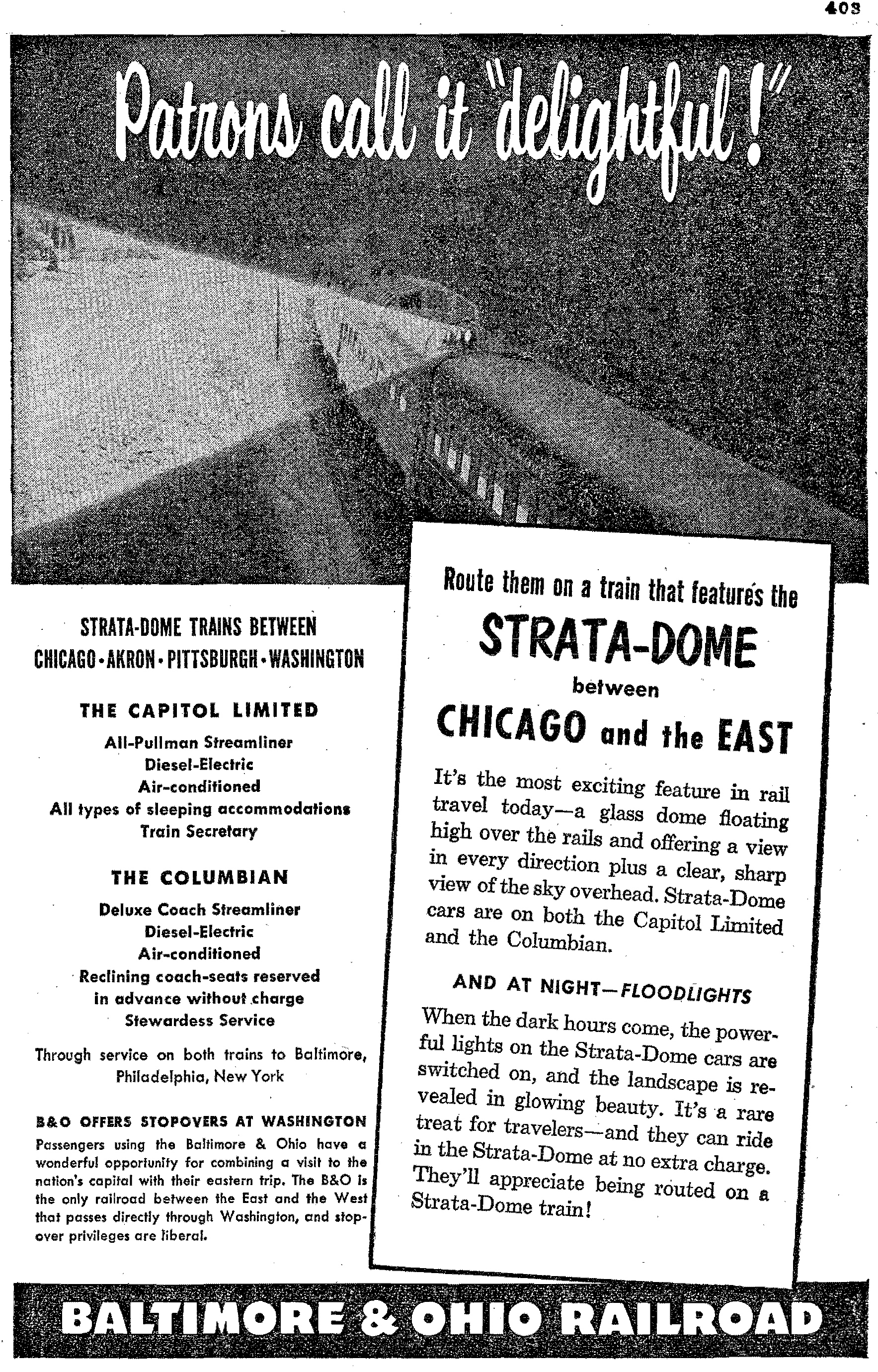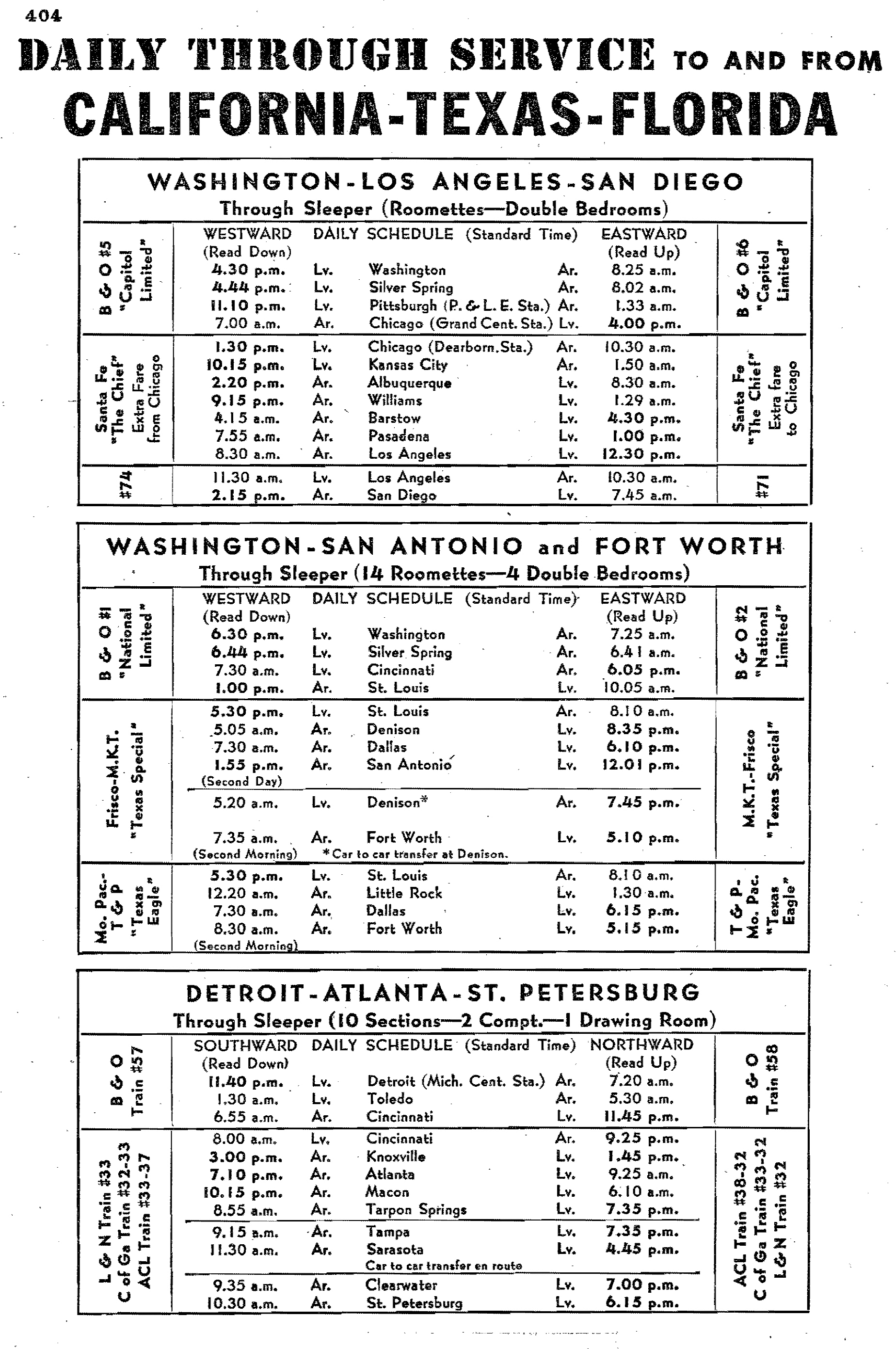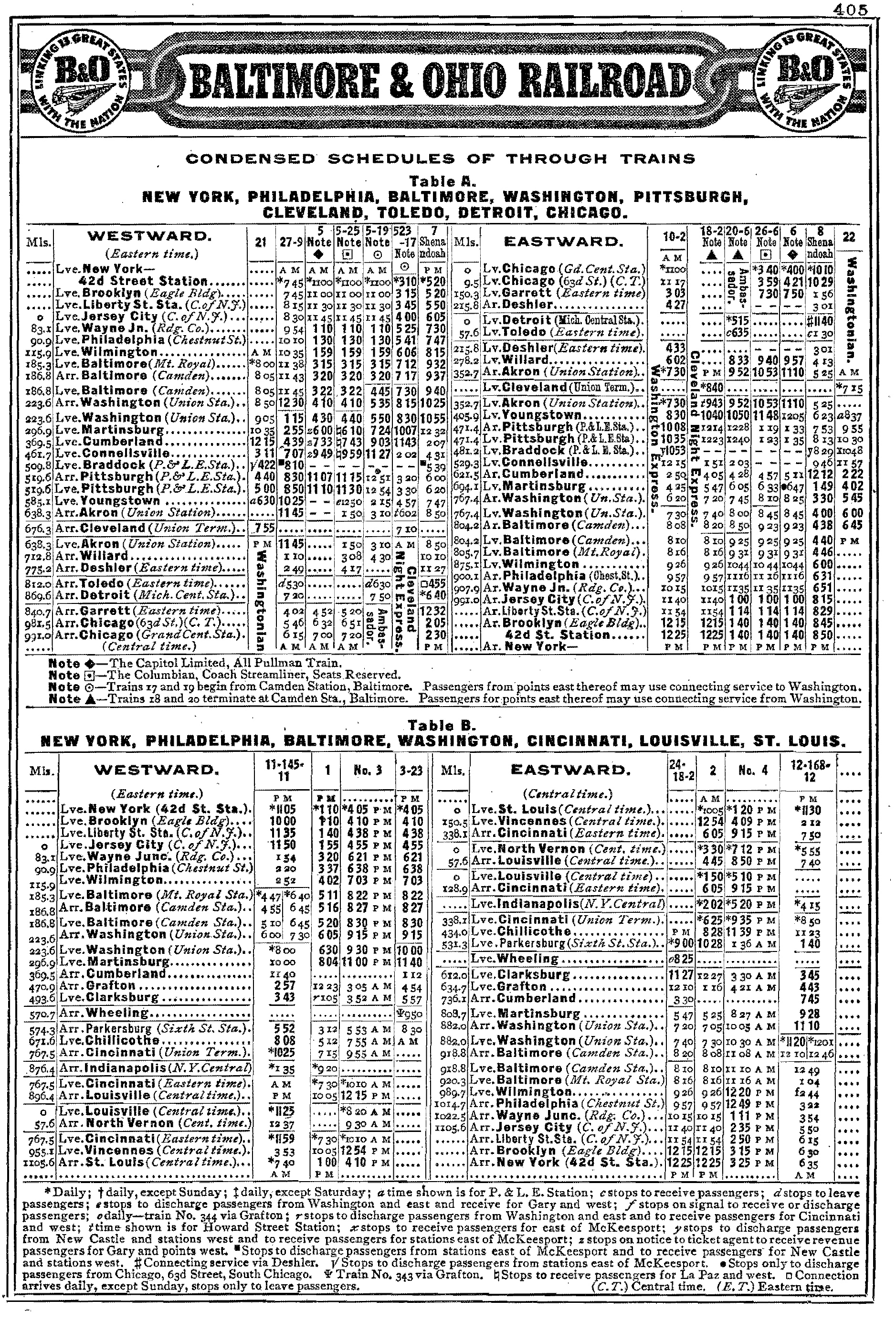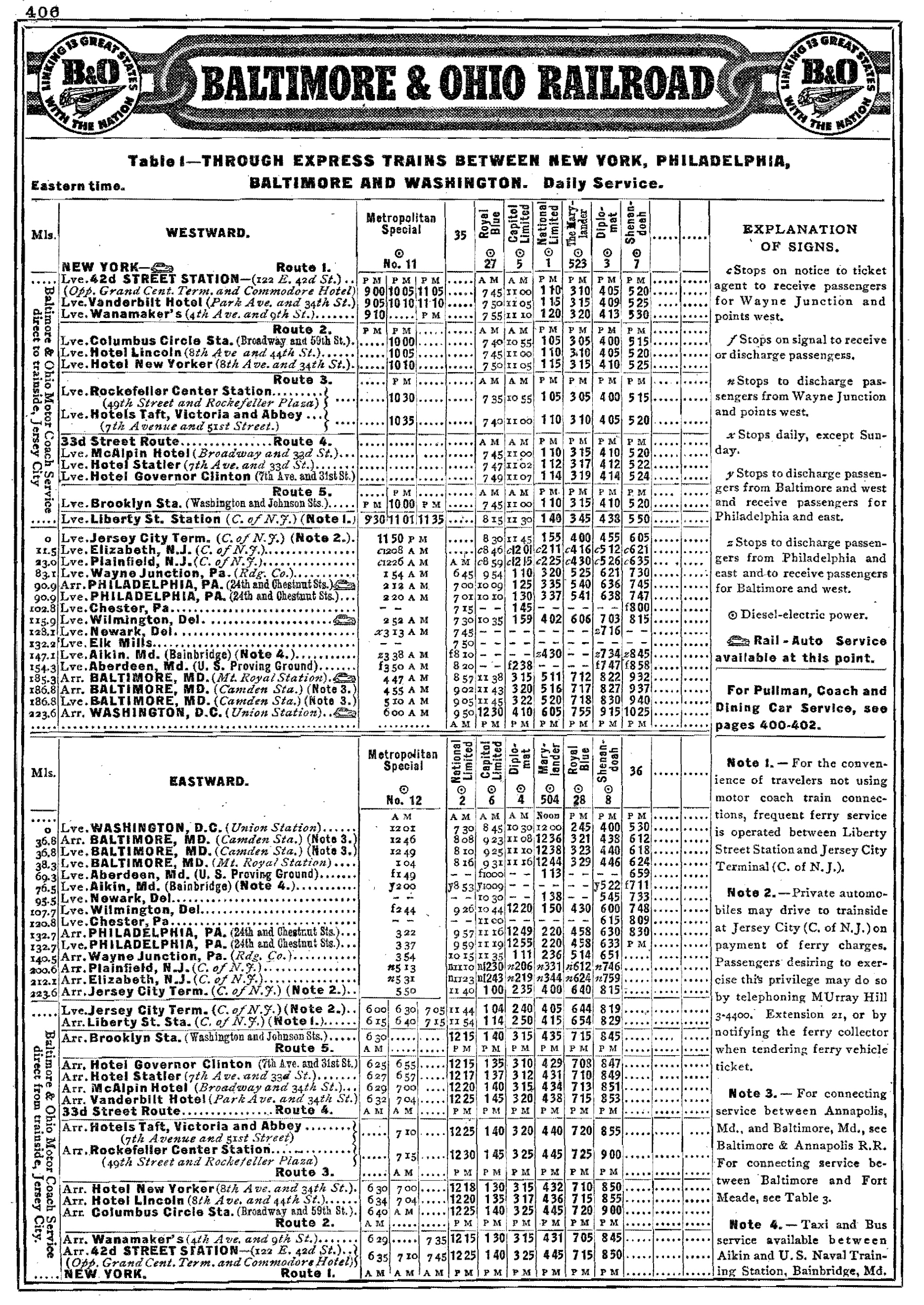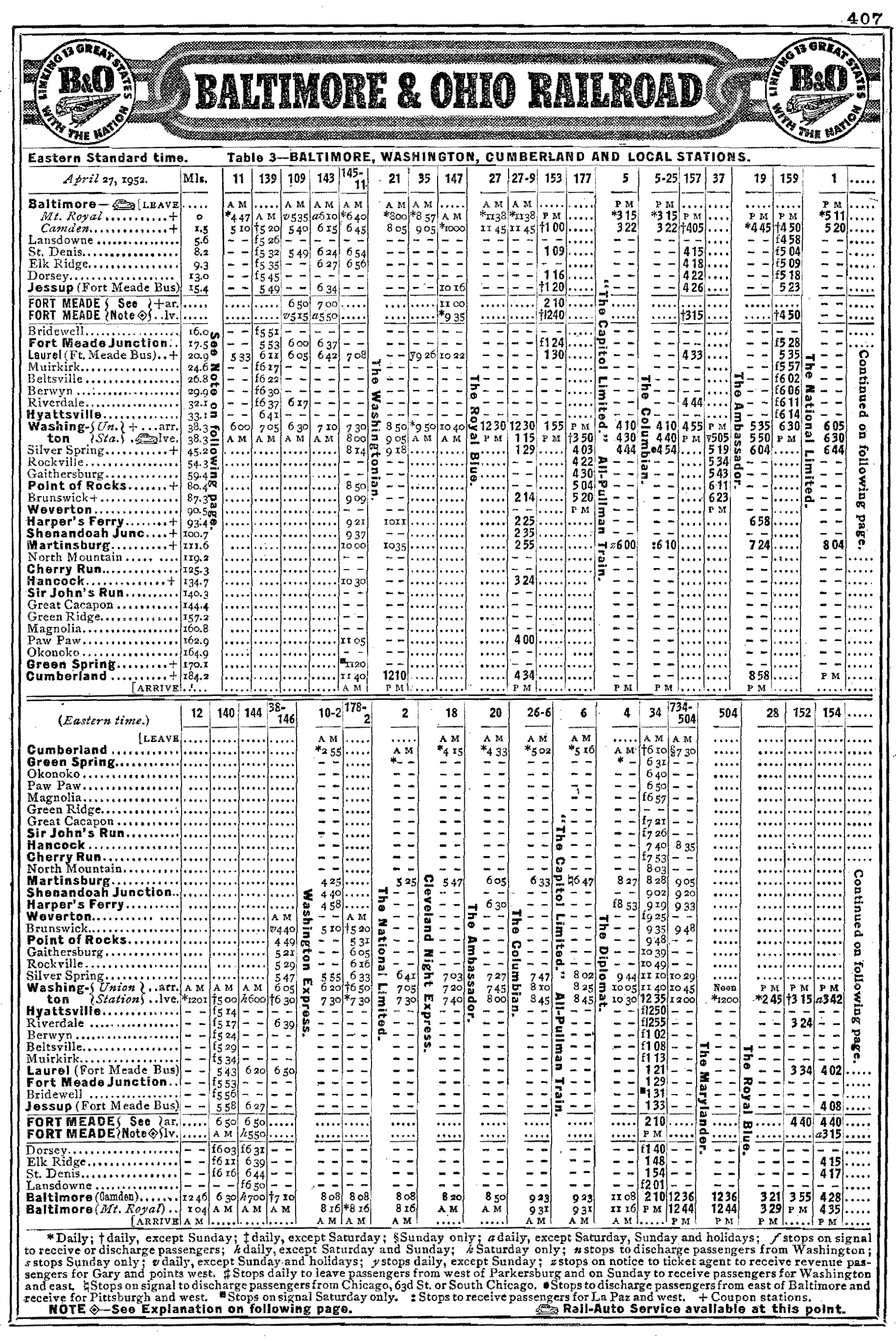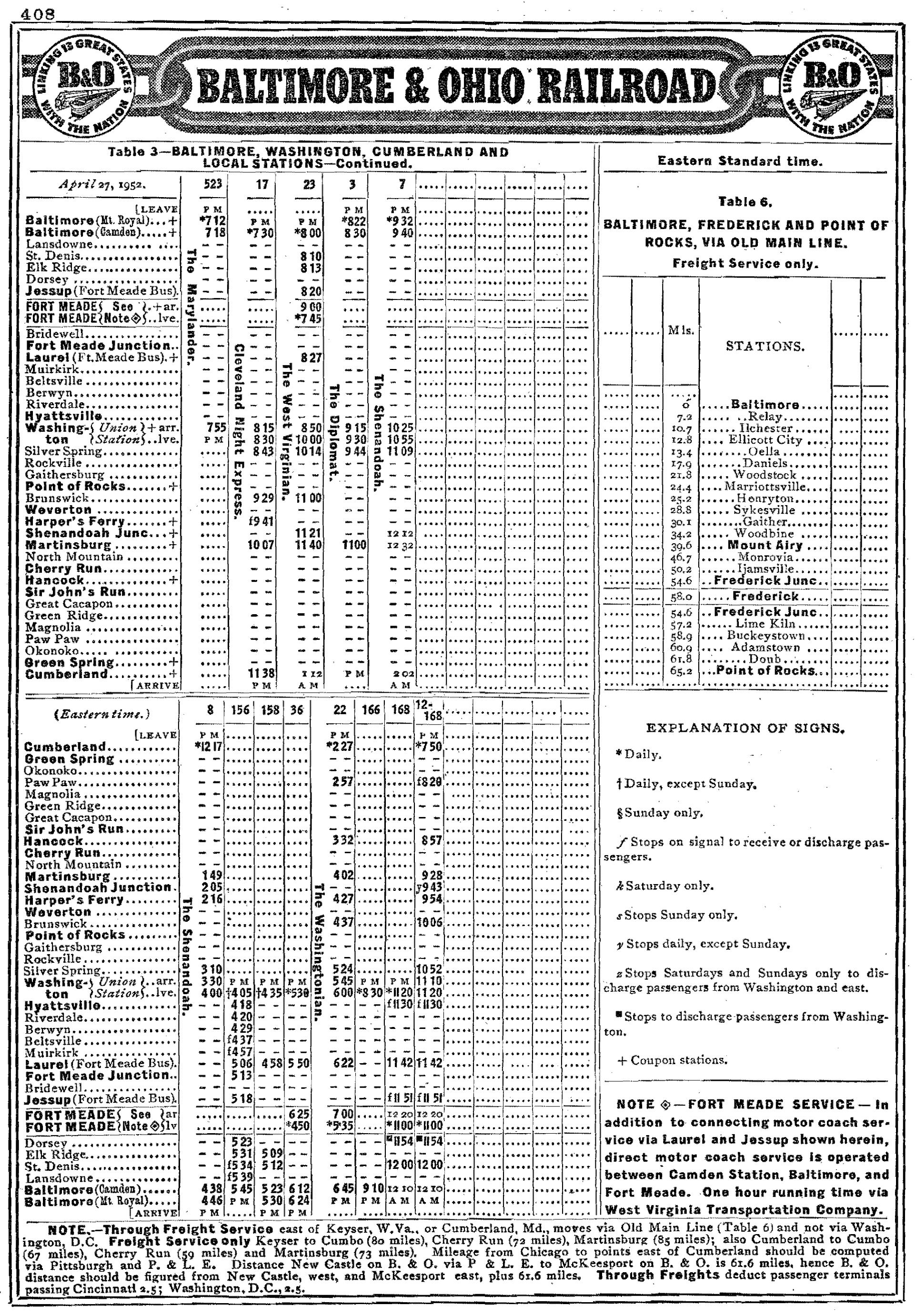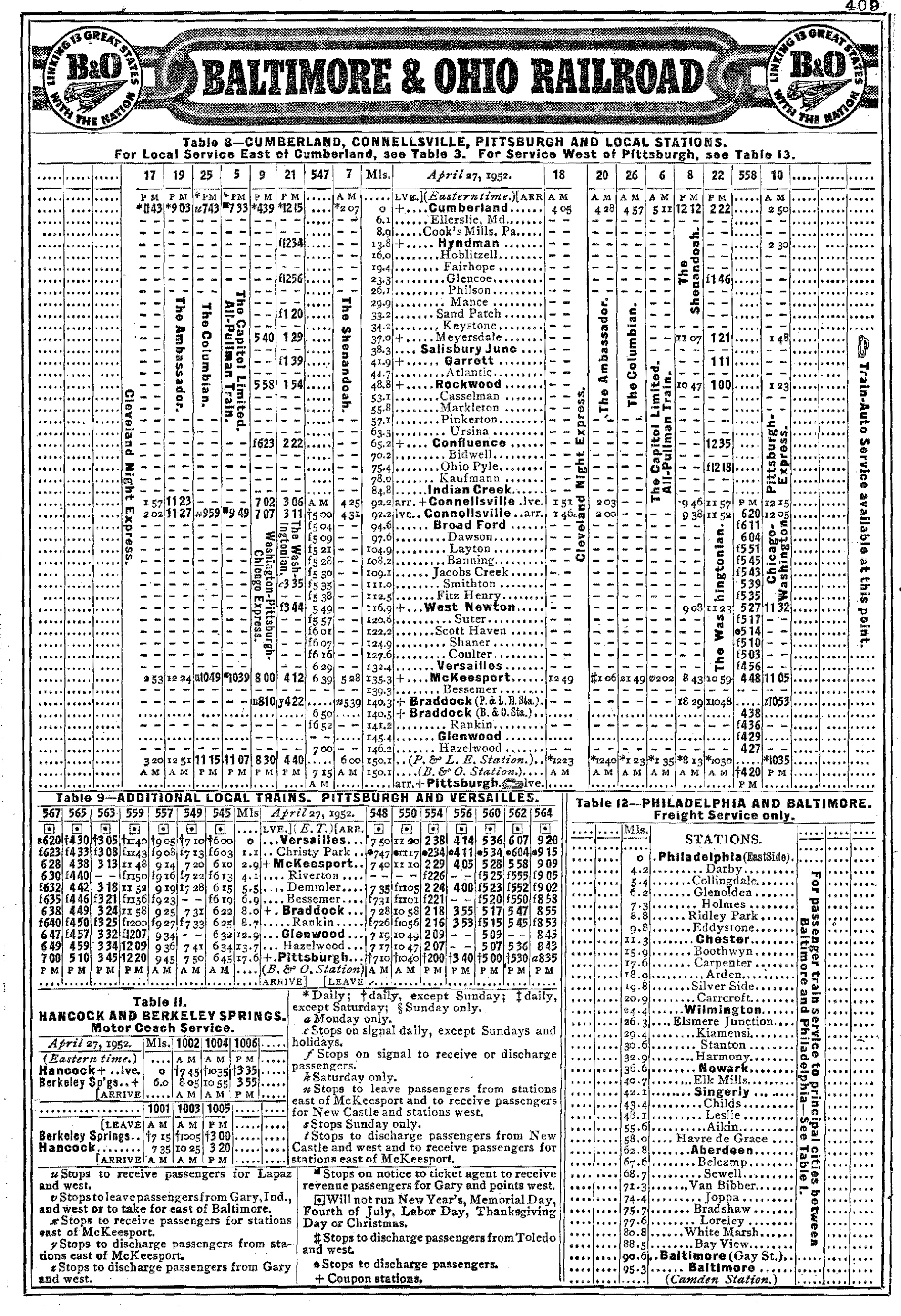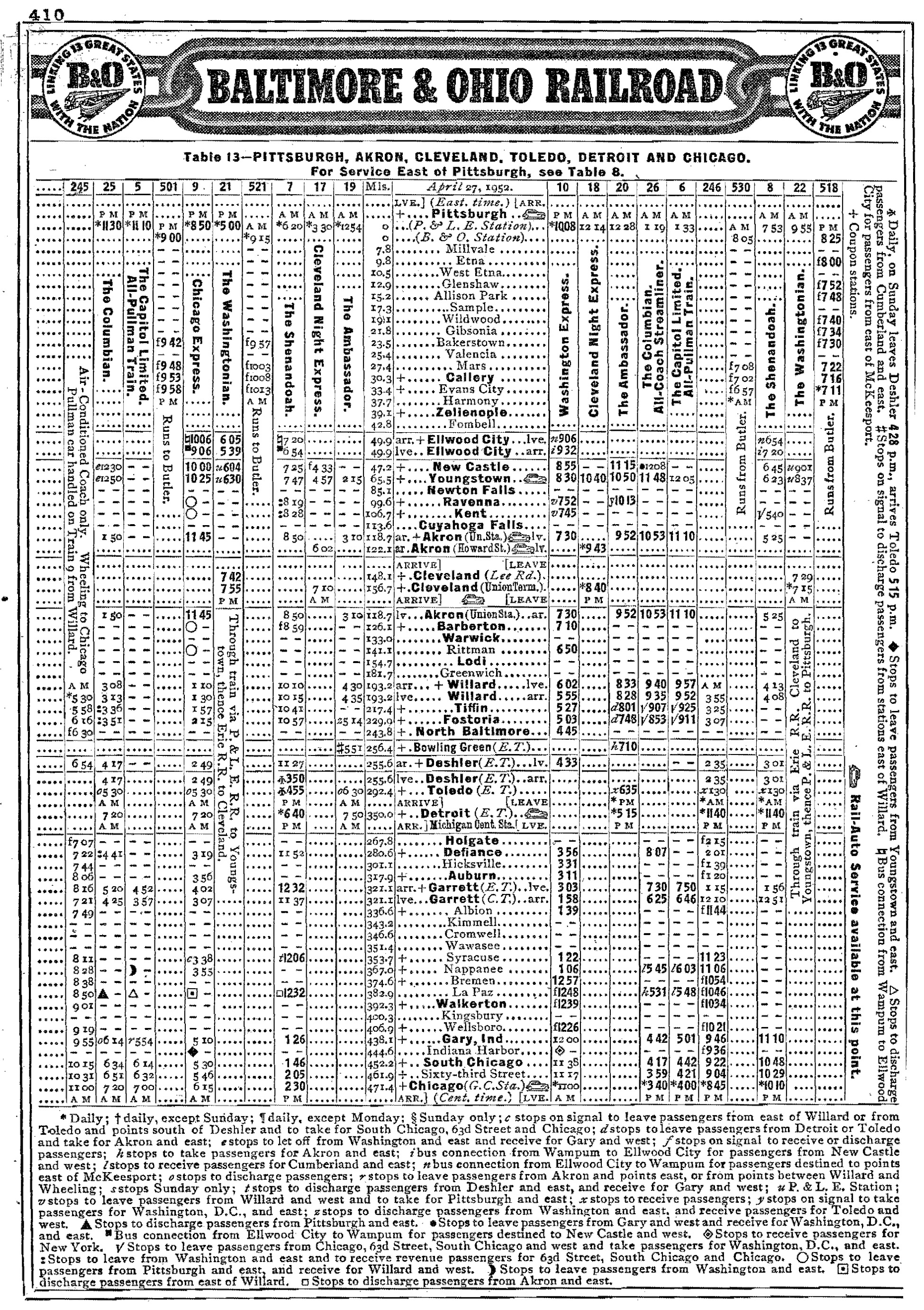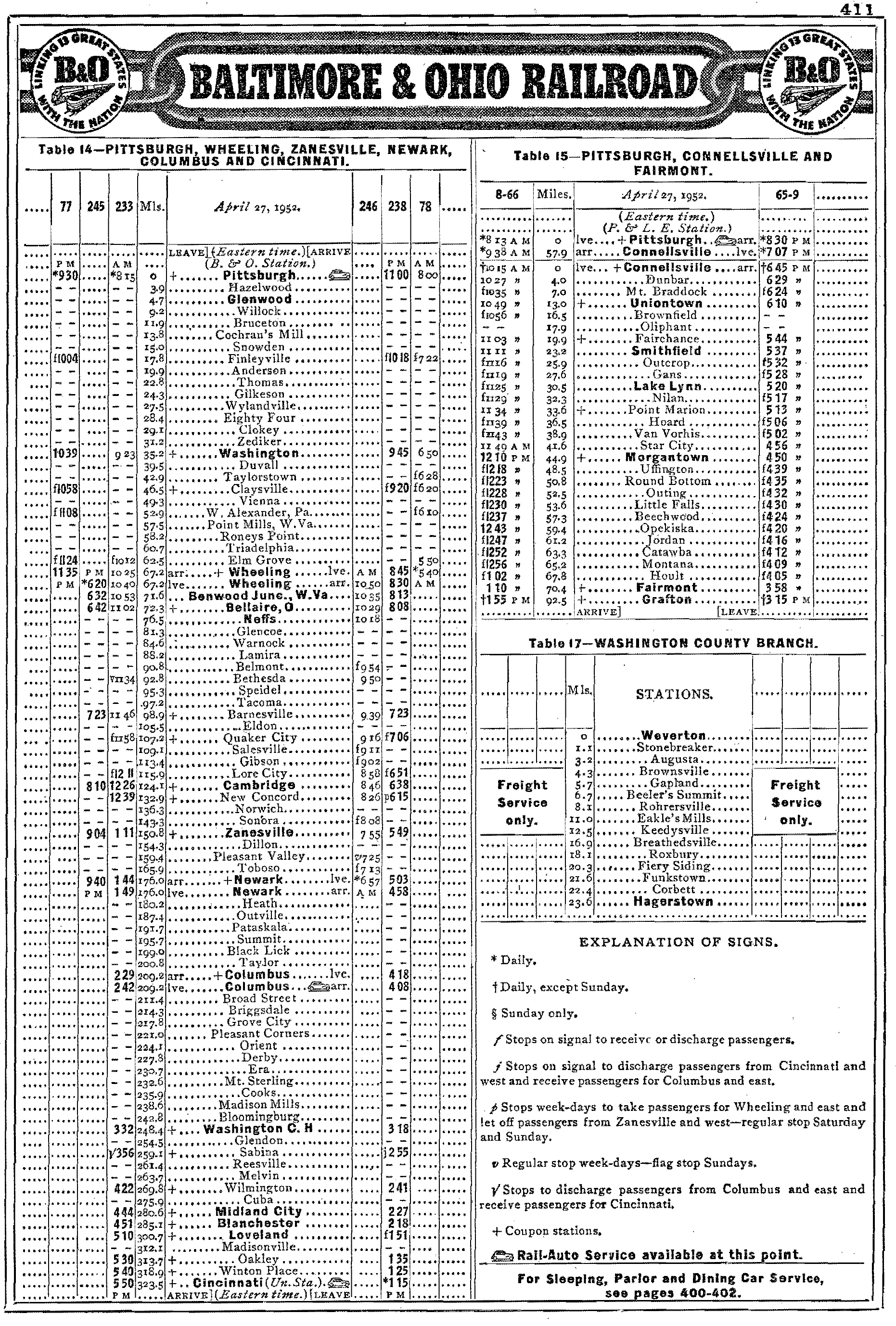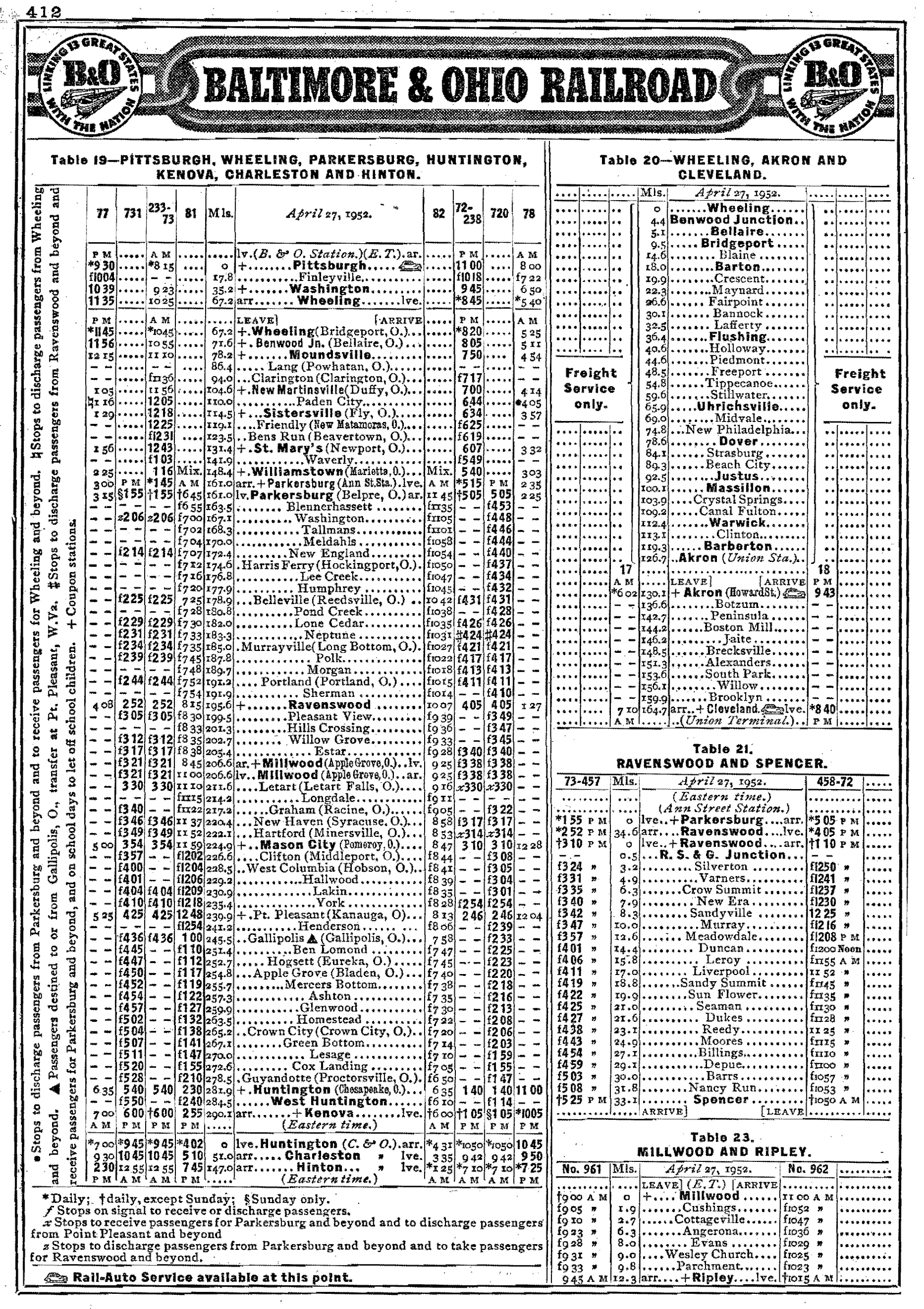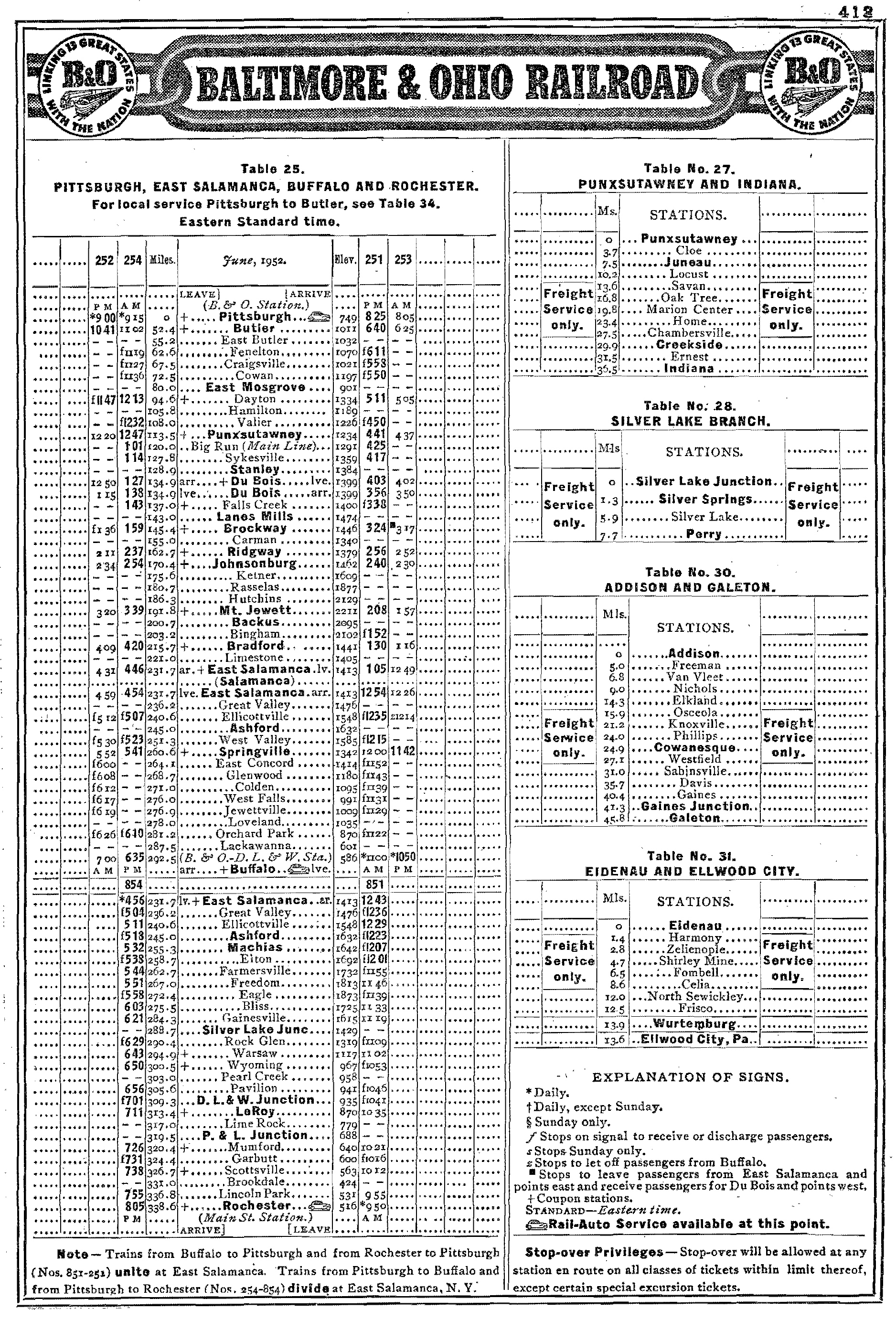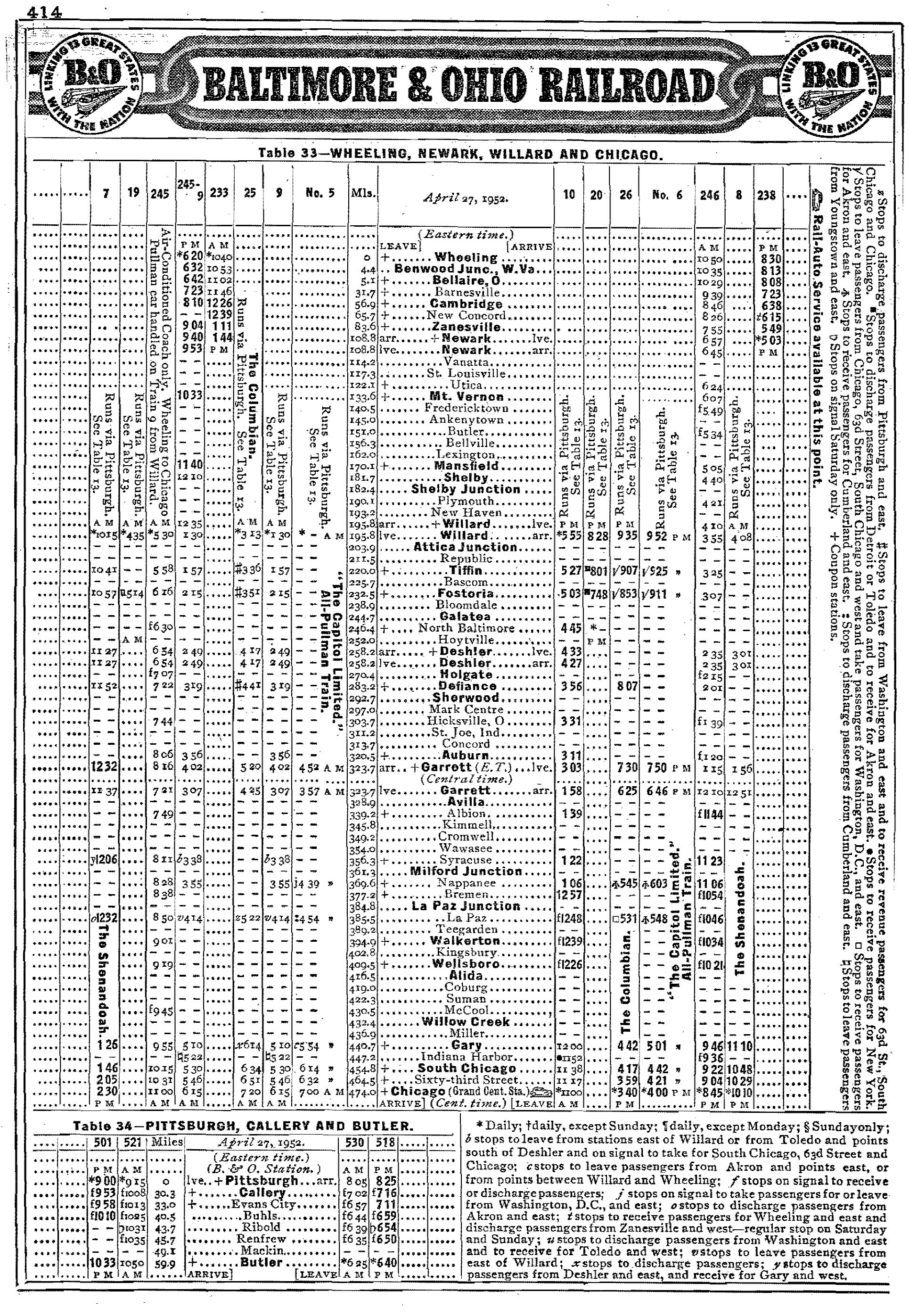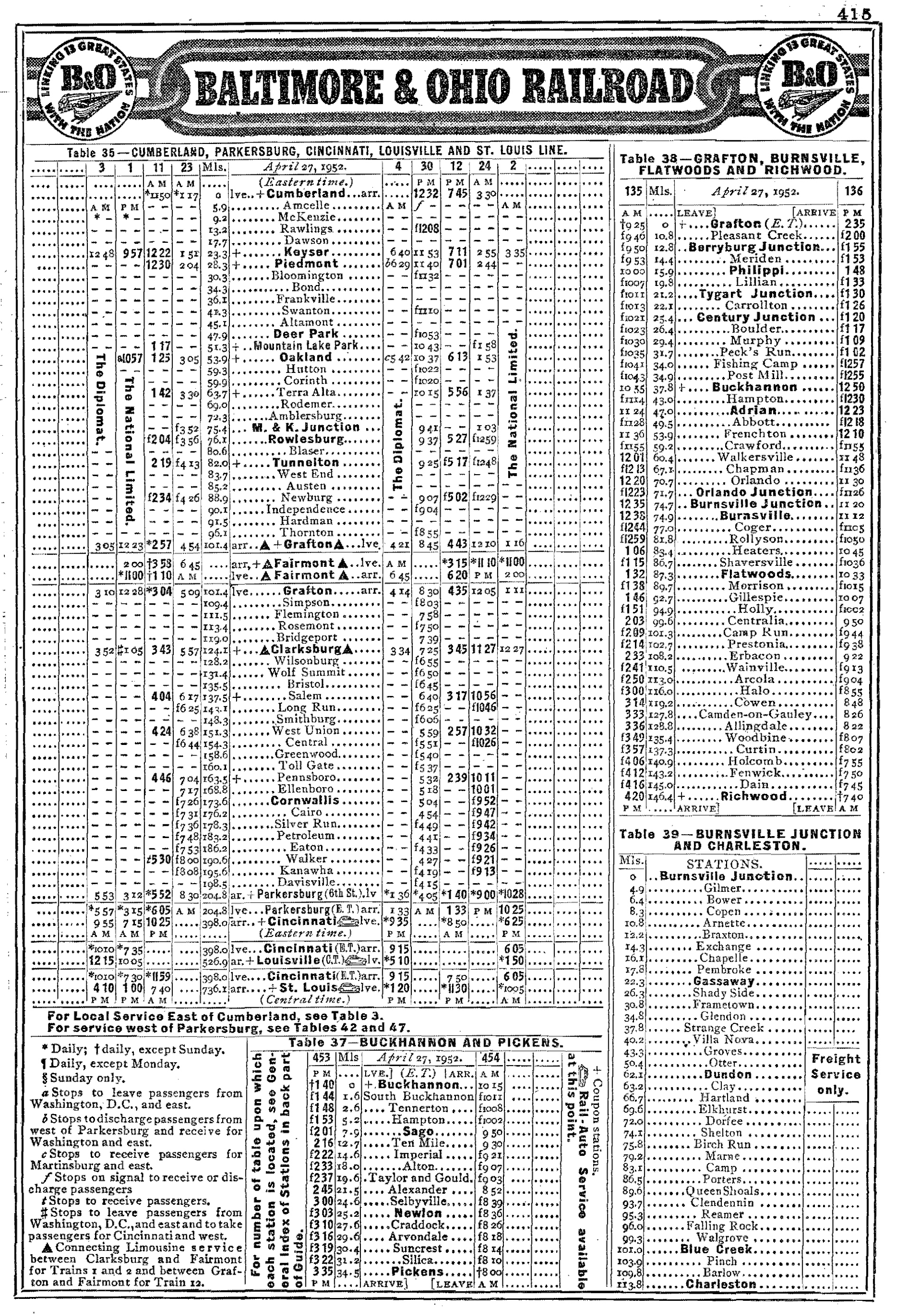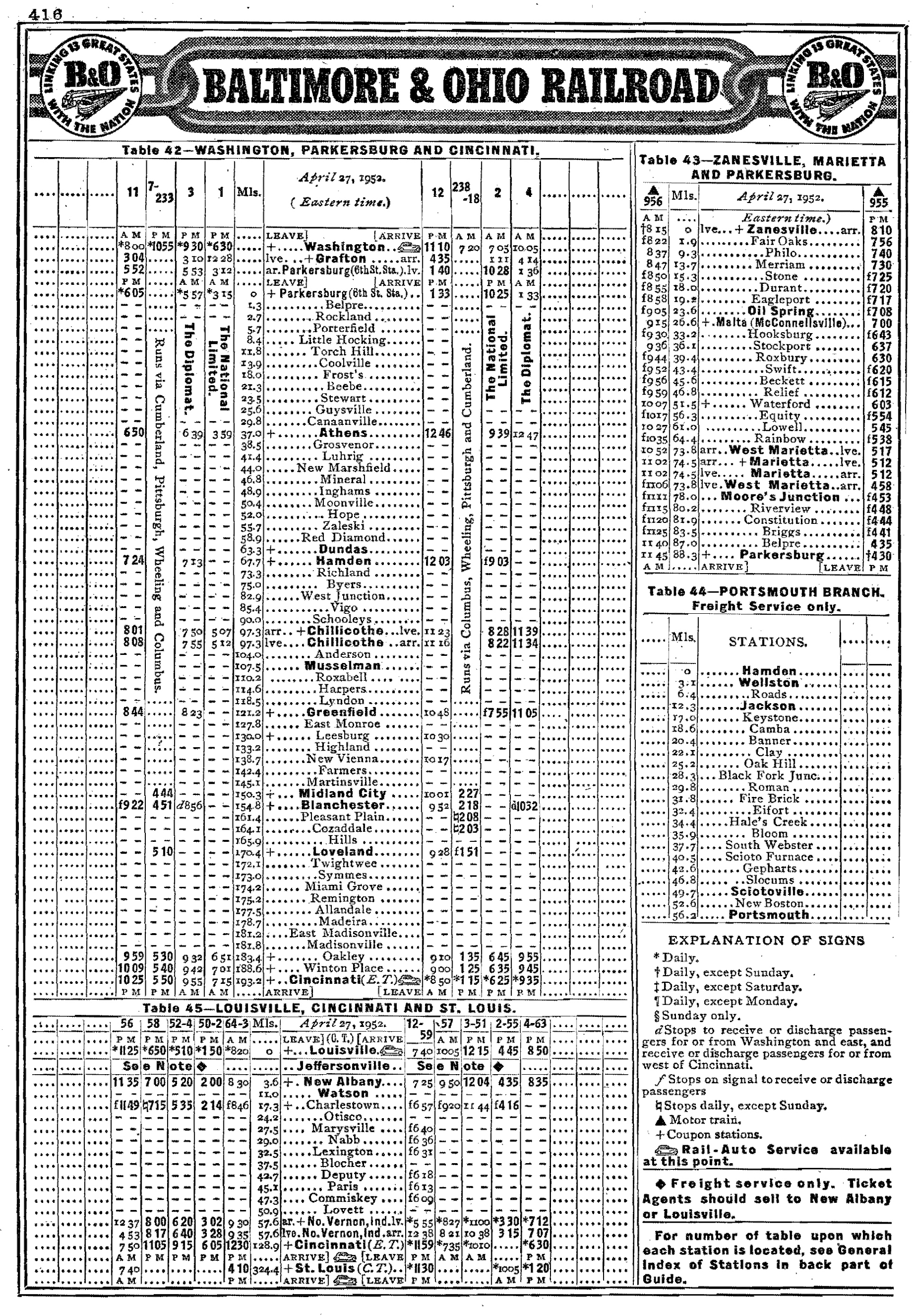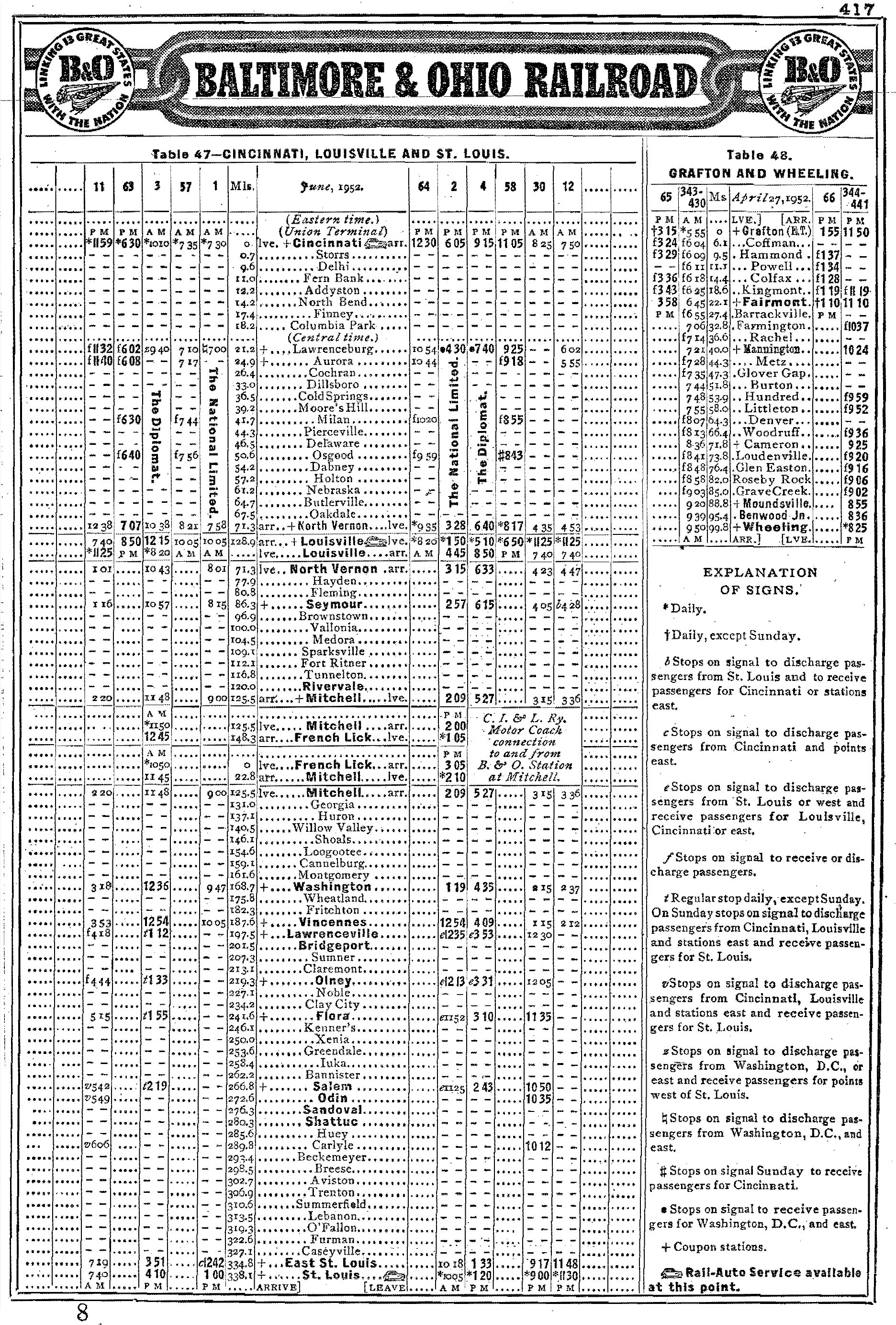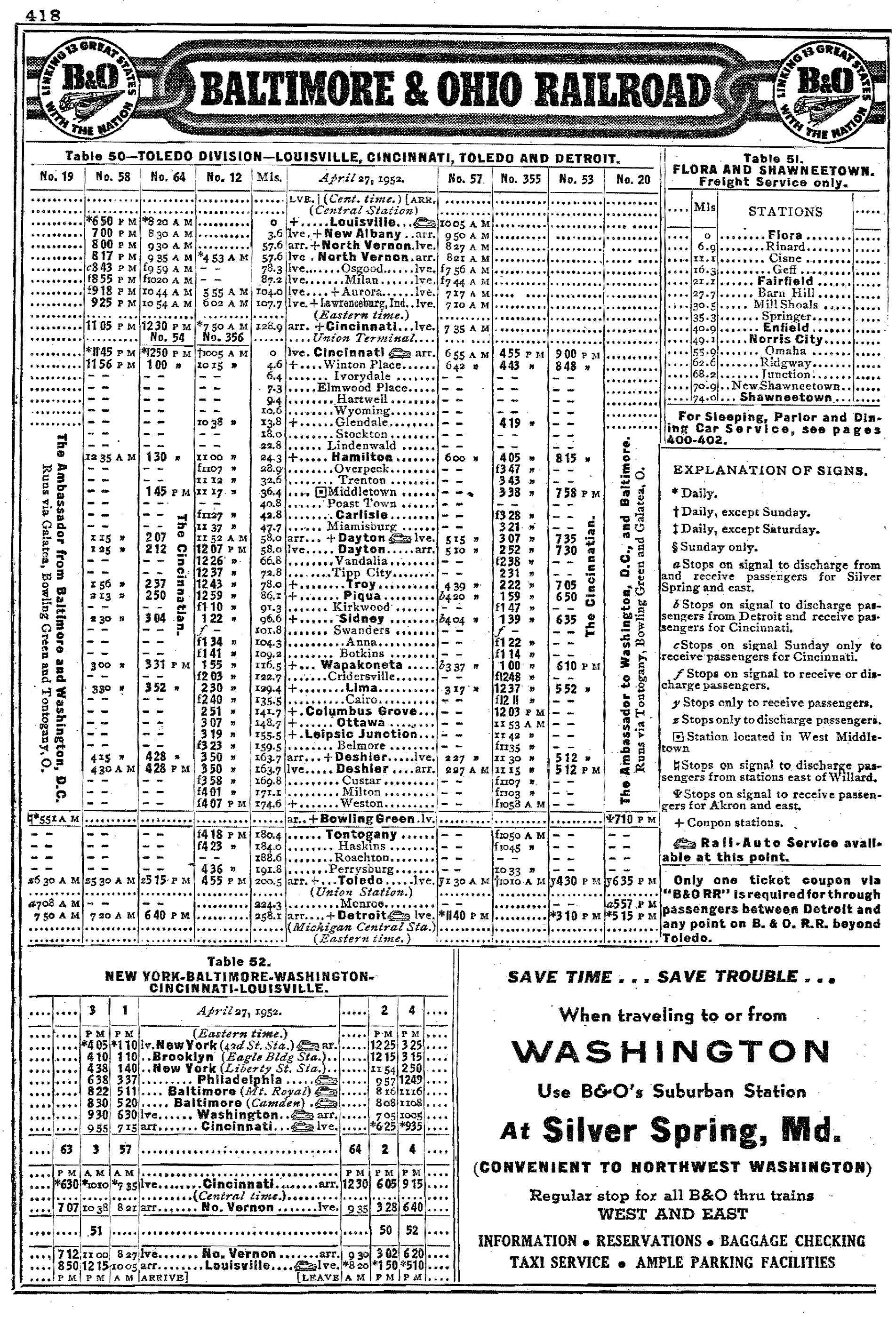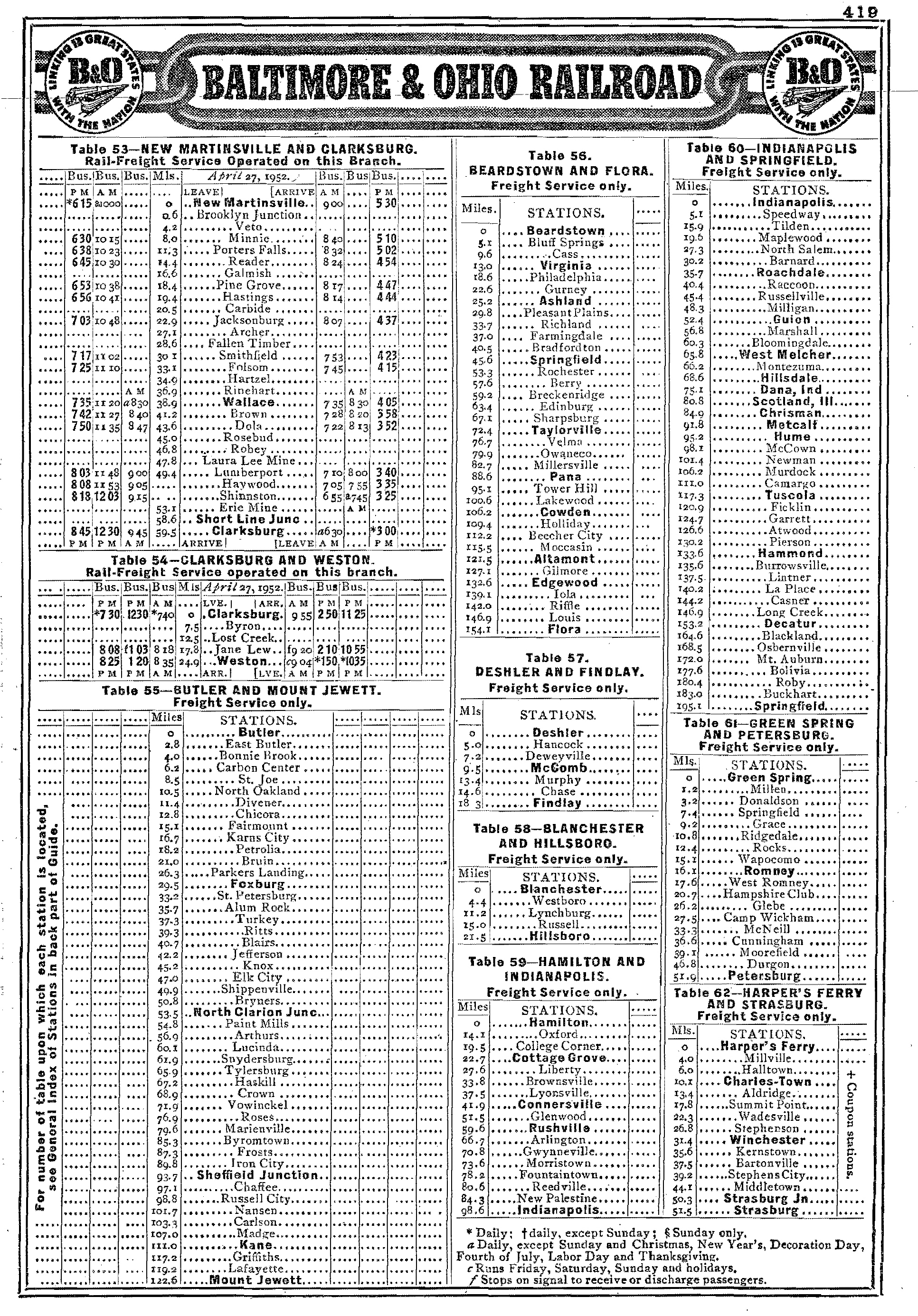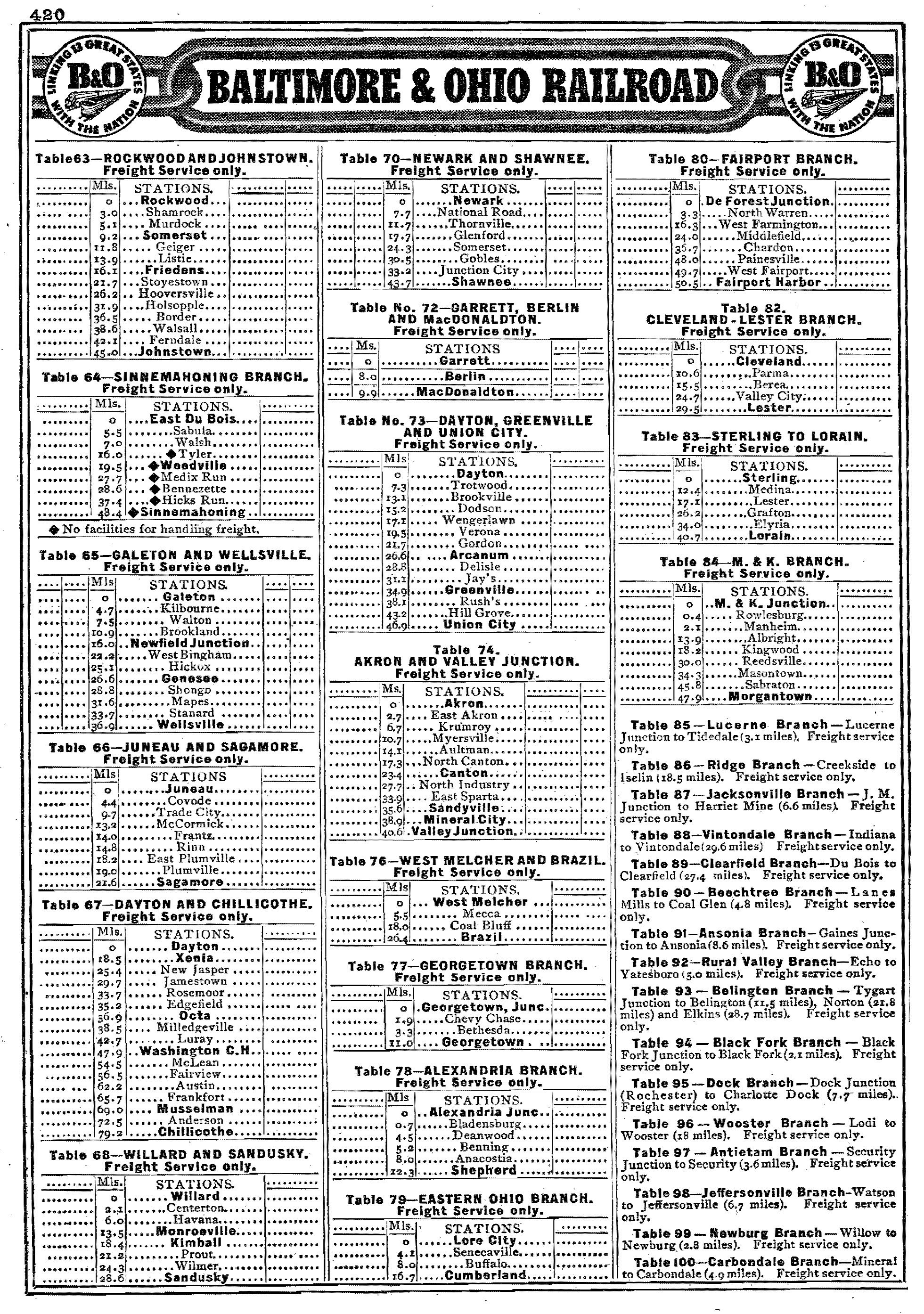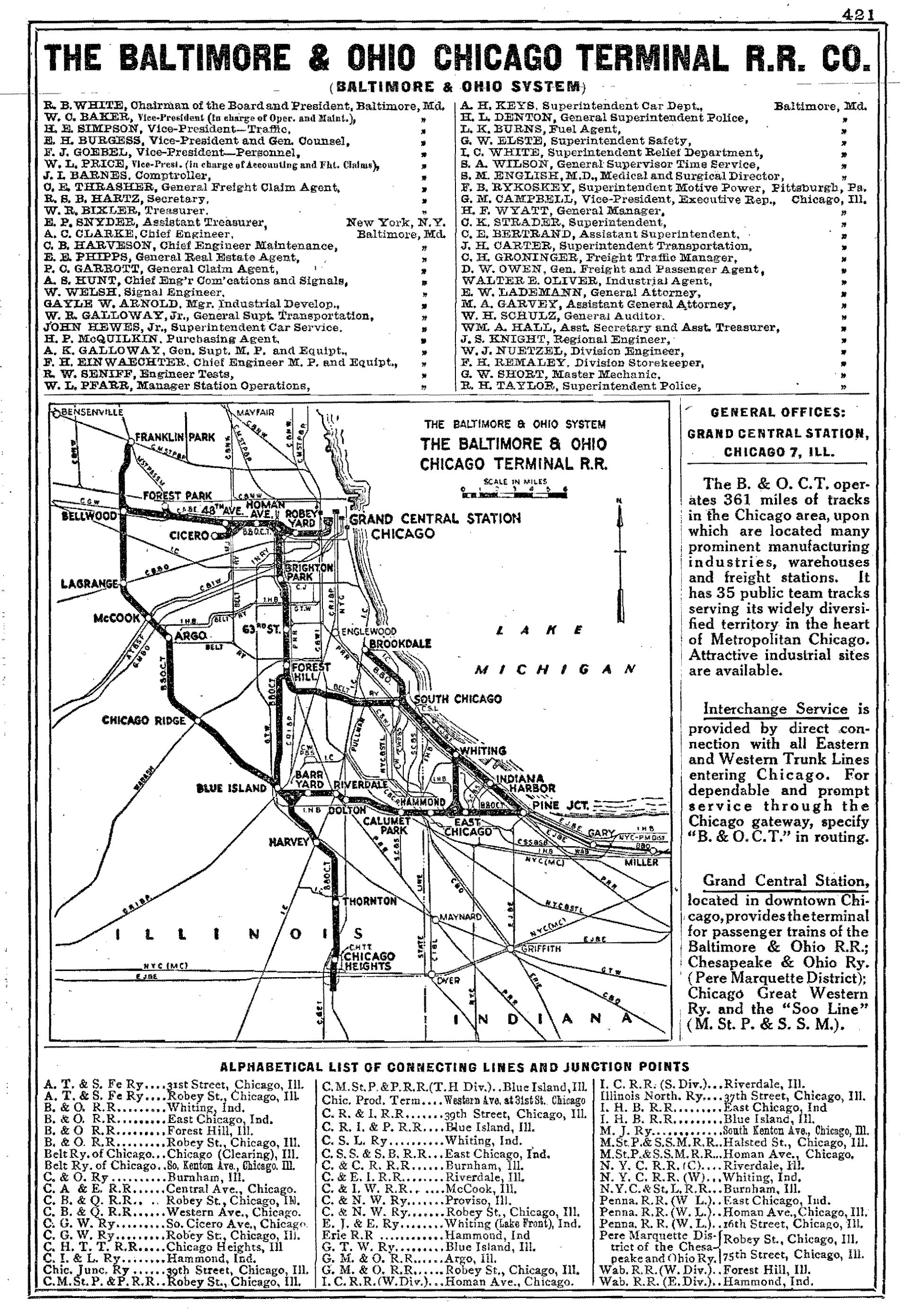Baltimore & Ohio Railroad: "Linking 13 Great States With The Nation"
Last revised: November 4, 2024
By: Adam Burns
The Baltimore and Ohio, “Linking 13 Great States With The Nation.” This was the railroad's slogan to which it remained devoted for many years.
The B&O holds the distinction as being this country’s very first common-carrier railroad (chartered specifically for public use), officially created in 1827.
Its early years were plagued with frustrations as it was blocked by the state of Pennsylvania on numerous occasions in the western route of its choosing, forced instead to rely upon a much more rugged line through Maryland and western Virginia (later West Virginia).
Despite these setbacks, the upheaval of the Civil War, and other issues the B&O grew into a powerful railroad stretching more than 10,000 total miles of track.
It has long been regarded as the third major trunk line to Chicago behind rivals Pennsylvania and New York Central.
The B&O is also fondly remembered for providing friendly and high quality service until the end despite a declining financial condition during the post-World War II years.
Its takeover by the Chesapeake & Ohio in the early 1960s helped ensure its survival and it eventually joined the Chessie System family before disappearing into CSX Transportation during the 1980s.
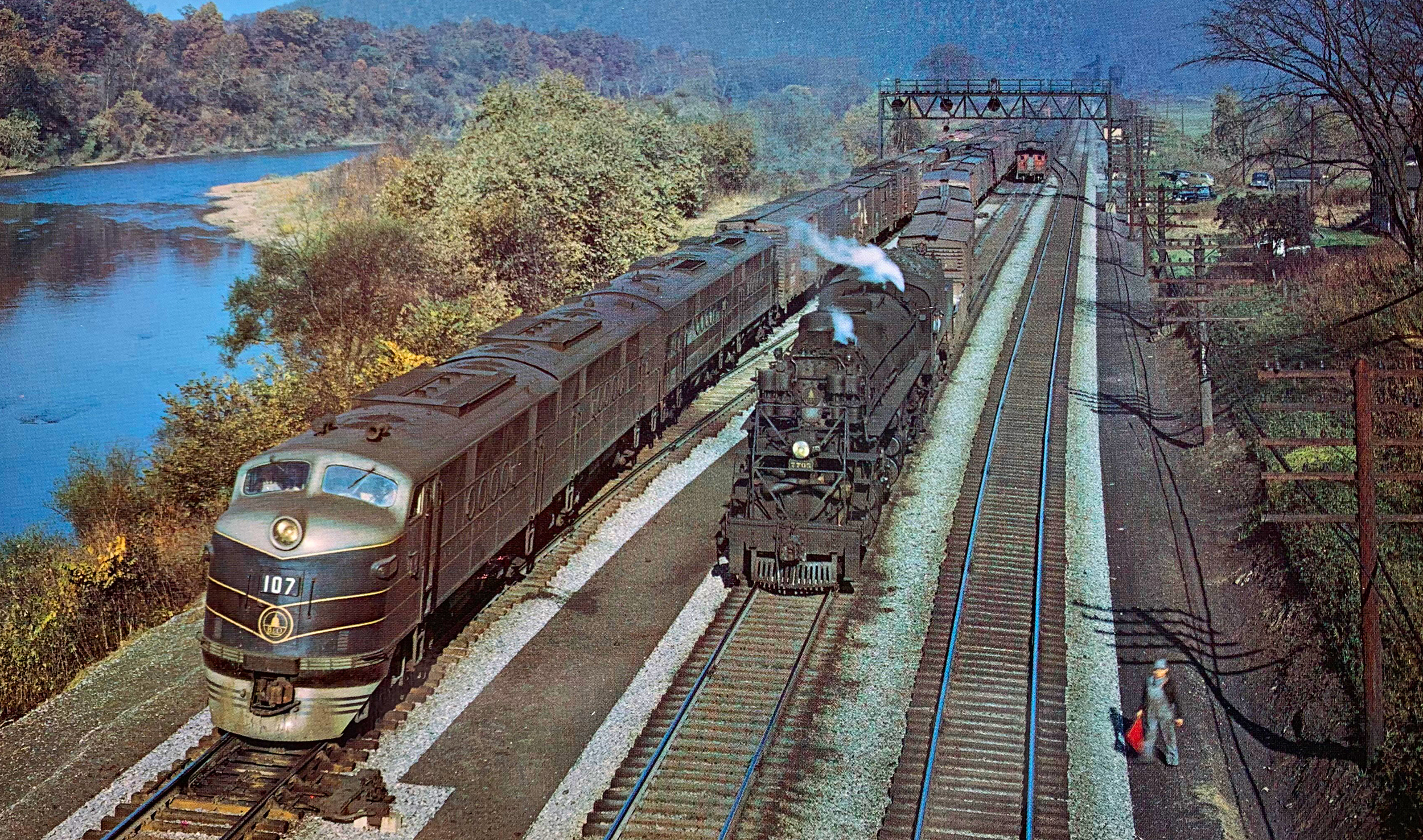 It's a busy scene in this Baltimore & Ohio publicity photo taken at Sir Johns Run, West Virginia during the early 1950s; a nice A-B-B-A lash-up of FT's are ahead of a westbound manifest to left while 2-6-6-4 #7705 (KB-1a), a former Seaboard Air Line engine, leads another to the right. An eastbound coal drag can be seen in the background. American-Rails.com collection.
It's a busy scene in this Baltimore & Ohio publicity photo taken at Sir Johns Run, West Virginia during the early 1950s; a nice A-B-B-A lash-up of FT's are ahead of a westbound manifest to left while 2-6-6-4 #7705 (KB-1a), a former Seaboard Air Line engine, leads another to the right. An eastbound coal drag can be seen in the background. American-Rails.com collection.History
As this country’s first common carrier railroad the B&O was instrumental in growing and stimulate our nation's economy during a time when “West” meant the Ohio River.
While never a wealthy company its legacy will forever be remembered as a survivor and putting customer service above all else.
This dedication earned the B&O a loyal following to the extent that some folks steadfastly rode its trains even if they were somewhat slower than that of its rivals.
In addition, as Brian Solomon notes in his book, "Amtrak," his grandfather, a regular rail traveler during the early 20th century, noted the B&O offered the best dining services.
When the company’s existence finally came to an end on April 30, 1987 it had just celebrated its 160th birthday and witnessed the industry grow from nothing more than few scattered lines to a rail network consisting of tens of thousands of miles linking the country from coast to coast (it also outlived its wealthier northern competitors by more than a decade).
At A Glance
The B&O was largely created out of a great need by the city of Baltimore to compete with the creation of the Erie Canal, which connected New York City with the Port of Albany at Buffalo. In addition, Philadelphia was organizing a plan to build a similar transportation system across the state linking Pittsburgh.
Fearing its city would be left at an economic disadvantage Baltimore leaders formed the B&O, originally chartered on February 28, 1827 and officially incorporated and organized on April 24, 1827. By that Fourth of July construction began with laying of a cornerstone in the city.
According to the book, "Baltimore & Ohio Railroad," by Kirk Reynolds and David Oroszi it was tradition to launch new canal construction on July 4th and since the B&O was a similar transportation artery Independence Day was chosen.
There were celebrations and ceremonies to mark the occasion and Charles Carroll himself, the last living signer of the Declaration of Independence, was on-hand to take part in the festivities. He was given the task of turning the first shovel of dirt, signaling the B&O's construction was underway.
The goal was having the railroad reach the Ohio River at Wheeling, Virginia and connect Cumberland, Maryland along the way. However, the task would be very difficult as the rugged Allegheny Mountains lay in its path.
The company would also face stiff political barriers from Pennsylvania, restricting an easier route through that state and forcing it to build across western Virginia.
The B&O's immediate concern was simply building a rail line; as a true pioneer, nearly everything decision it made was an educated guess based on what little was known about trains at the time.
Perhaps most challenging was constructing a proper right-of-way and figuring out the curvature limits and grade severity a typical train could handle. To aid in this endeavor engineers sailed to England, the birthplace of railroads, for ideas concerning construction and best practices.
Among their most notable takeaways was track gauge. In his book, "American Narrow Gauge Railroads," author and historian Dr. George W. Hilton notes the B&O was initially built to a gauge of 4 feet, 6 inches.
However, after its engineers studied English railways and witnessed how their gauge of 4 feet, 8 1/2 inches provided for more room of moving parts on inside-connected locomotives, it was adopted and in use by the early 1830's. The B&O's next task was in designing a track guideway for the trains' wheels to follow.
Once again, engineers found themselves in unknown territory as they experimented with various techniques from stone guideways with wooden beams to iron straps using the same principle.
They eventually learned the best, most economical design was a wooden beam reinforced with a iron strap supported by wooden crossties.
Iron strap rails did work although proved incredibly dangerous as worn straps could let go causing the deadly phenomenon of "snake heads," which easily ripped through the floors of early wooden cars and maimed or killed passengers.
By the 1840s solid iron "T"-rail was introduced, developed by Robert Stevens president of the Camden & Amboy Railroad. In January of 1830 the B&O launched service over its first 1.5 miles from a small station in Baltimore at Pratt Street.
Within just a few months, 13 miles was opened to Ellicotts Mills (today Ellicott City) in May where the railroad constructed a sturdy, two-story stone depot along with a small turntable.
The location did not offer significant passenger traffic but did serve a local granite quarry, known as Ellicott's Quarries, along with nearby agriculture and less-than-carload freight.
These early trains all operated with horses as power, trotting along with what was little more than retrofitted carriages.
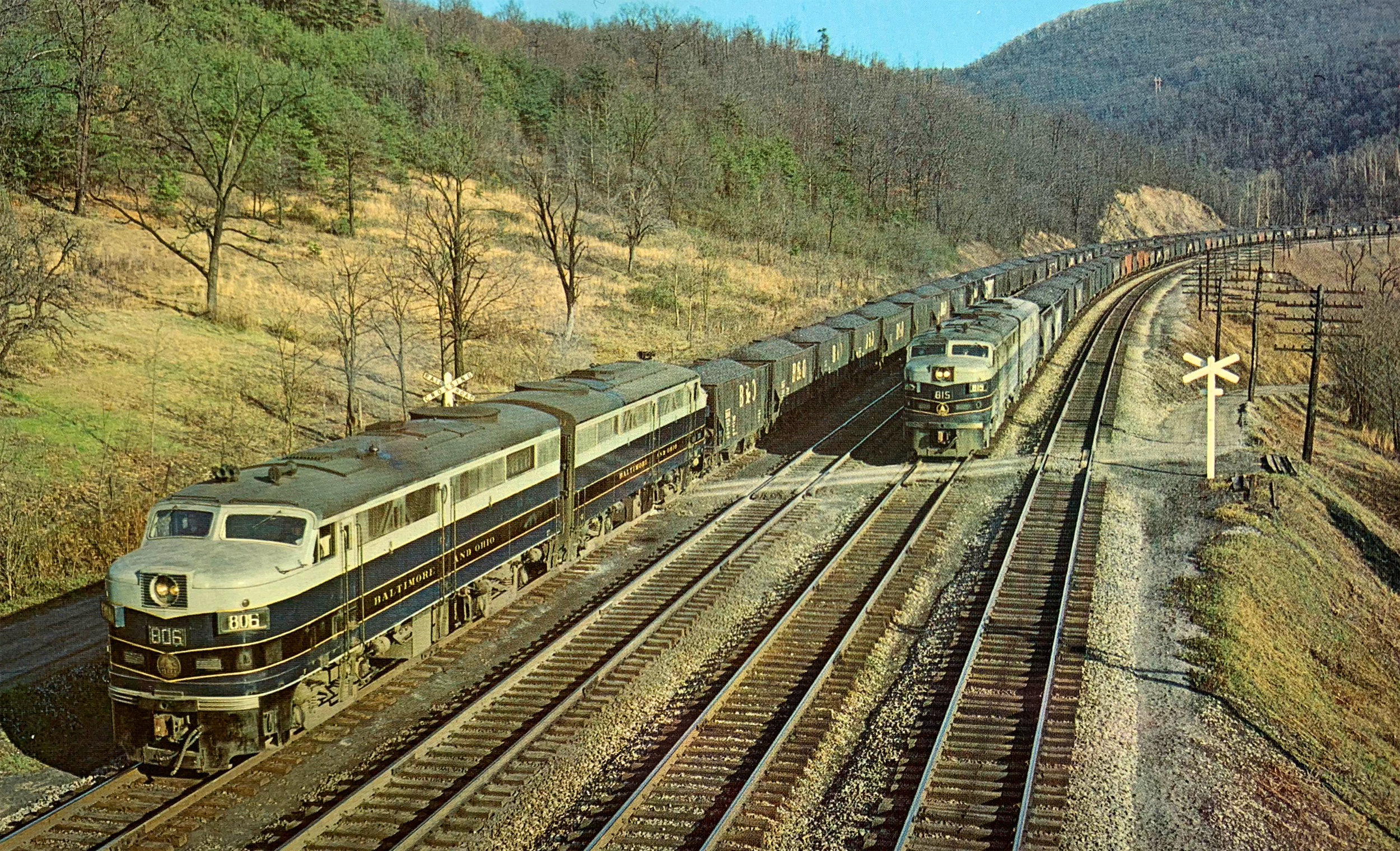 In this Baltimore & Ohio publicity photo, handsome FA-2's have westbound coal drags at Orleans, West Virginia during the early 1950's.
In this Baltimore & Ohio publicity photo, handsome FA-2's have westbound coal drags at Orleans, West Virginia during the early 1950's.That same summer on August 28th the B&O successfully tested Peter Cooper's 2-2-0 "Tom Thumb," a Planet Type steam locomotive. It lost its famous race with a horse that day but successfully proved the viability of steam-powered locomotives.
In early 1831 the B&O placed an order from Phineas Davis of York, Pennsylvania for an 0-4-0 steamer called the York and in time the railroad retired its stable of horses for the iron horse.
As the 1830s progressed the B&O continued expansion towards the west reaching Frederick in 1831 (via a branch) and Harpers Ferry, Virginia in January, 1837 following a completion of a bridge spanning the Potomac River.
System Map
As construction quickened Cumberland was finally reached on November 5, 1842, a location that throughout the railroad’s existence would be a major division point.
A further push to the west bogged down as the B&O focused on upgrading its existing property. Unfortunately, by the 1840s the railroad was no longer alone as many other new charters and companies were being formed, notably the Pennsylvania Railroad (1846).
Under the new direction of Thomas Swann, who achieved the presidency on October 11, 1848, the railroad was soon under construction again in an effort to complete its charter; heading roughly southwest it reached the small community of Bridge Valley (later Grafton) and Fairmont, Virginia before turning northwesterly towards the Ohio River.
Finally, in 1852 it had reached the City of Wheeling, Virginia (West Virginia after June 20, 1863) along the river. It was not long before the B&O was again pushing west from Grafton (founded on March 15, 1856 and named after John Grafton), this time heading due west to the Ohio River at Parkersburg where it connected with the Marietta & Cincinnati.
Downtown Baltimore Map (1848)
Through a series of mergers and acquisitions the railroad had reached St. Louis by 1857 via Cincinnati, Ohio thus linking eastern markets with the Mississippi River.
After recovering from the Civil War's destruction the company reached Chicago by 1875 (albeit indirectly, its through route to the Windy City, via Pittsburgh, was not established until 1891).
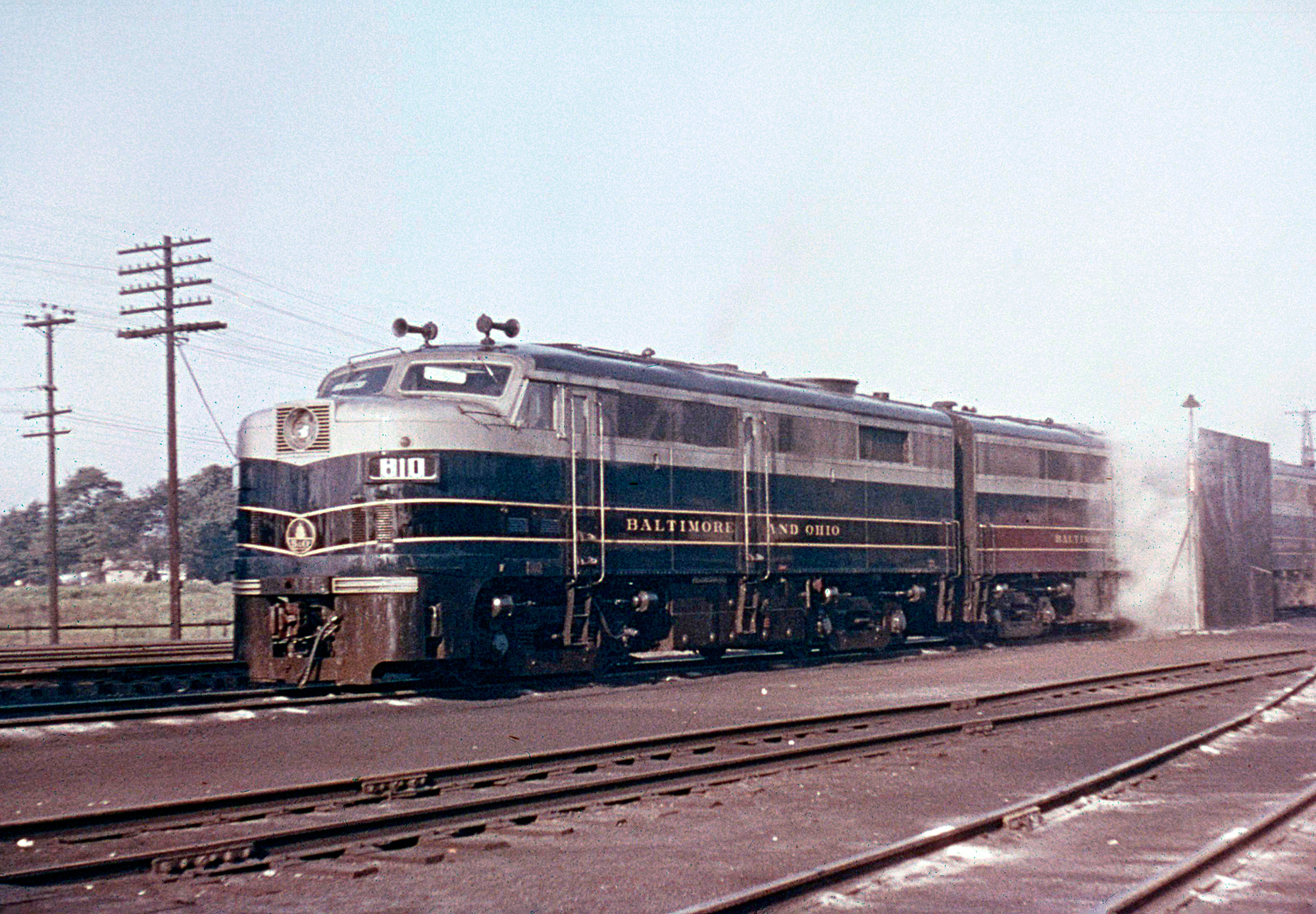 Baltimore & Ohio FPA-2 #810 and FB-2's receive a bath at the wash rack in Willard, Ohio on August 14, 1956. J.W. Swanberg photo. American-Rails.com collection.
Baltimore & Ohio FPA-2 #810 and FB-2's receive a bath at the wash rack in Willard, Ohio on August 14, 1956. J.W. Swanberg photo. American-Rails.com collection.Following its Chicago link the B&O eyed better easterly connections at Philadelphia and New York to better compete against a Pennsylvania Railroad that, by then, had already established itself as the dominate road to those cities.
It opened between Philadelphia and Baltimore (111 miles) in September of 1886 by way of subsidiary Delaware Western.
The only way for the B&O to reach New York City was thanks to friendly connections over the Philadelphia & Reading (Philadelphia - Bound Brook) and Central Railroad of New Jersey (Bound Brook - Jersey City).
What became known as its "Royal Blue Line" was actually a patch work of through connections and passengers had to disembark from the CNJ's Jersey City Terminal where they rode ferries across the Hudson River into Manhattan.
This setup obviously put the B&O at a disadvantage in the market but it faithfully fought hard with an elegant train known as the Royal Blue before giving up in 1958.
Predecessors
Baltimore & Ohio Chicago Terminal
Arguably the most important B&O Railroad subsidiary was the B&OCT, which provided crucial switching and terminal operations within the Windy City not only for its parent but also numerous surrounding railroads.
It was formed in 1910 when the B&O acquired the bankrupt Chicago Terminal Transfer Railroad.
The CTTR itself had a long history of predecessors dating back to the La Salle & Chicago Railroad of 1867. At its peak the B&OCT operated from Chicago Heights to Franklin Park via Blue Island and La Grange.
It also connected Bellwood, Forest Hill, South Chicago, East Chicago, Calumet Park, Whiting, and Pine Junction. The B&OCT offered its parent direct access to its Grand Central Station along Chicago's North Side. Today, the company is still a subsidiary of CSX Transportation.
Baltimore, Pittsburgh & Chicago
A wholly-owned subsidiary of the B&O, the BP&C was incorporated in March of 1872 to build a 260-mile extension from a point known as Chicago Junction, Ohio (later renamed Willard after noted B&O president Daniel Willard).
In 1873 the line reached Newark, Ohio and was completed to Chicago by 1875. At first the B&O used the Illinois Central to reach the Windy City's downtown area but later established a successful terminal road, the Baltimore & Ohio Chicago Terminal, to handle the daily tasks of operations throughout the city.
The railroad's initial passenger terminal here was located along Adams Street although by 1883 it had an improved facility near Monroe Street. Finally, the B&O moved into the handsome Grand Central Station in 1891, which became its primary terminal until passenger services ended three-quarters of a century later.
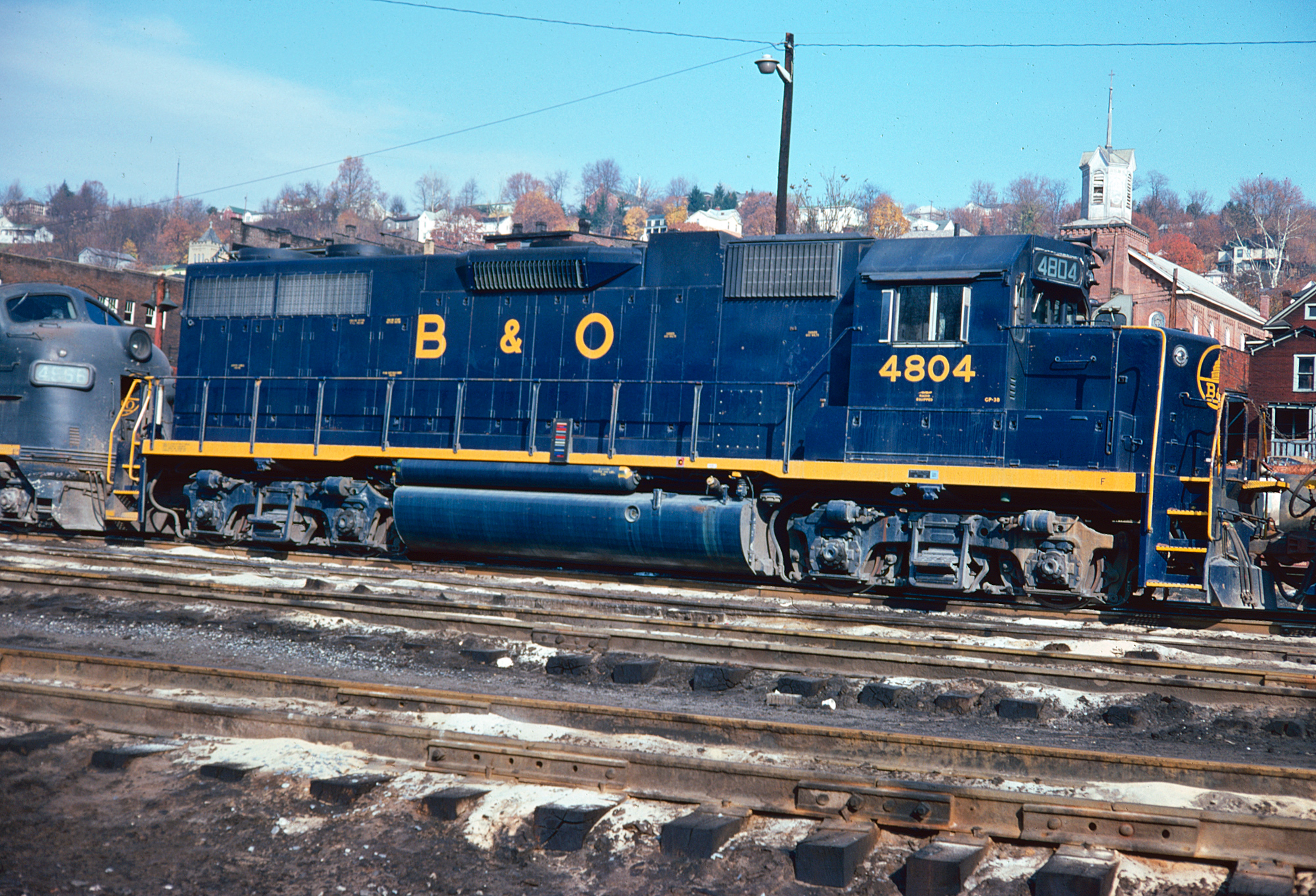 Baltimore & Ohio GP38 #4804 and F7A #4566 layover in Grafton, West Virginia in November, 1970. American-Rails.com collection.
Baltimore & Ohio GP38 #4804 and F7A #4566 layover in Grafton, West Virginia in November, 1970. American-Rails.com collection.Buffalo, Rochester & Pittsburgh
The BR&P was a regional line linking central Pennsylvania with Buffalo and Rochester, New York. It was pieced together primarily to handle coal traffic and was acquired by the B&O in 1929 which formally took over the property on January 1, 1932.
The BR&P's corporate history began on March 10, 1887 when the Pittsburgh & State Line Railroad and the first Buffalo, Rochester & Pittsburgh merged following the bankruptcy of the Rochester & Pittsburgh.
Then-president Daniel Willard was attempting to push the B&O into key western New York markets although the BR&P never offered the greatest connection to Buffalo.
He also purchased a nearby road known as the Buffalo & Susquehanna in 1932, created in 1893 through the merger of several small logging lines including the Sinnemahoning Valley Railroad, Susquehanna Railroad, Cherry Springs Railroad, Cross Fork Railroad, and an earlier Buffalo & Susquehanna.
It ran diagonally across Pennsylvania from Sagamore to Addison and Wellsville, New York via Galeton. There were also branches to Ansonia and Keating Summit, Pennsylvania.
The road struggled financially and never earned much revenue, even during B&O control, relying largely on sparse local industry and agriculture.
Heavy flooding in November of 1942 forced the abandonment of the B&S south of Galeton, isolating it from the B&O network. The northern segment was later sold to form the Wellsville, Addison & Galeton in 1956. It operated freight service until 1979.
Marietta & Cincinnati Railroad
The M&C initially carried no ties to the B&O although the Baltimore road saw it as an important link to the Midwest. The M&C was formed in 1851 by the consolidation of the Belpre & Cincinnati and Franklin & Ohio railroads.
Its funding came primarily from the towns it would connect such as Athens, Cincinnati, Marietta, and Chillicothe.
The road opened in early 1857 between Marietta and Cincinnati, establishing a link to the B&O/NV via carferry service from Parkersburg to Marietta.
After many years the B&O was finally able to construct a large, 7,100-foot bridge across the Ohio River from Parkersburg to Belpre, Ohio opening for service on January 7, 1871 and eliminating the car-ferry operation. The B&O gained control of the M&C in 1882 and renamed it has the Baltimore & Ohio Southwestern in 1889.
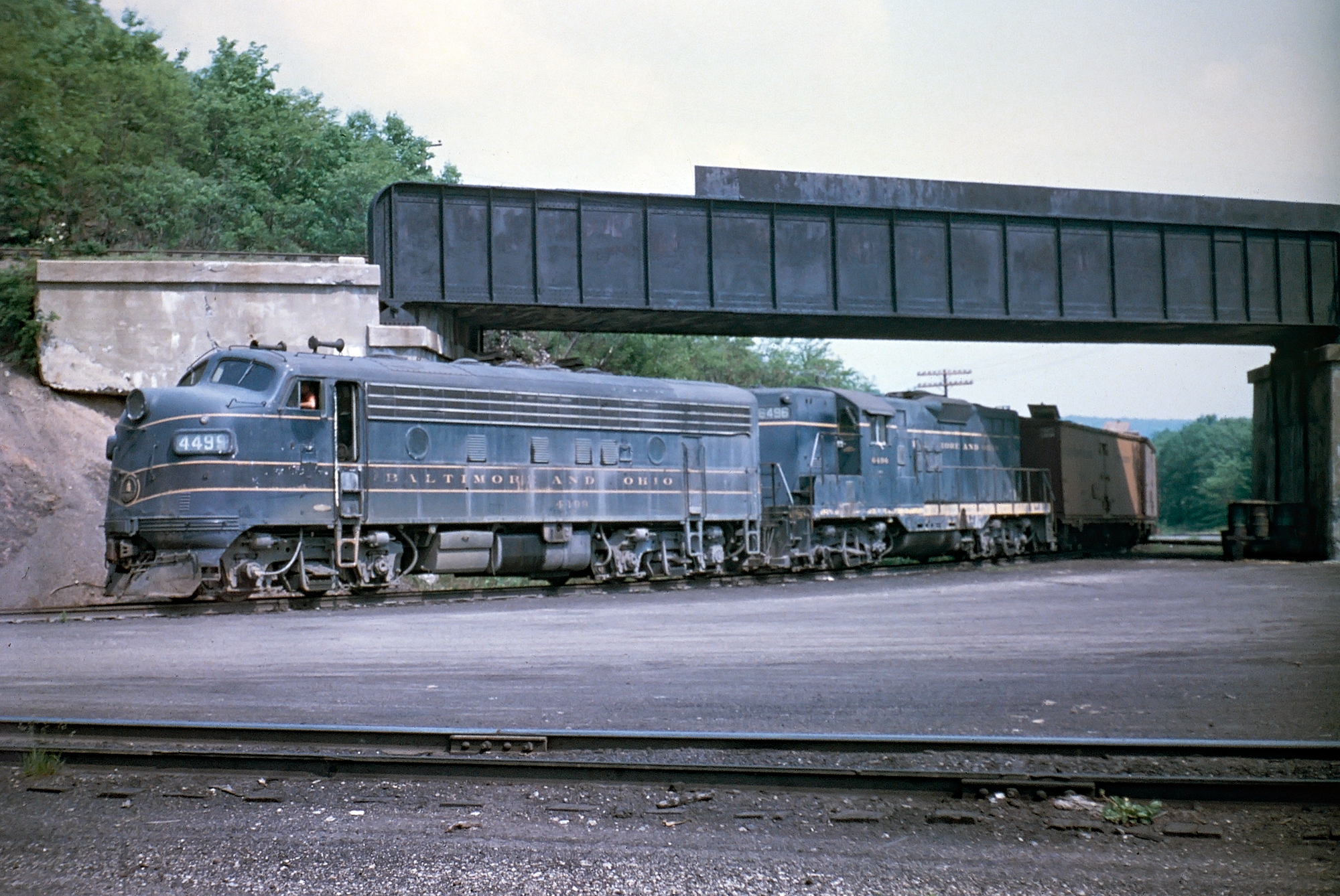 Baltimore & Ohio F7A #4499 and GP9 #6496 swing off the Chicago main line and onto the Somerset & Cambria Branch at Rockwood, Pennsylvania in June, 1967. The Western Maryland connection can be seen overhead. E. Roy Ward photo. American-Rails.com collection.
Baltimore & Ohio F7A #4499 and GP9 #6496 swing off the Chicago main line and onto the Somerset & Cambria Branch at Rockwood, Pennsylvania in June, 1967. The Western Maryland connection can be seen overhead. E. Roy Ward photo. American-Rails.com collection.Northwestern Virginia Railroad
The NV provided the B&O with a more direct western routing from Cumberland. While its original main line to Wheeling offered access to the Ohio River and a connection with the National Road the company began searching for a better river port centered more geographically towards the Midwest.
On February 14, 1851 the Northwestern Virginia Railroad was chartered to connect with the B&O at what later became Grafton, winding its way along the Appalachian foothills to Parkersburg, Virginia.
Although the NV was a private corporation it was largely backed by the B&O and formally leased during December of 1856.
The railroad opened for service on May 1, 1857 and became known as the "Parkersburg Branch." The corridor, despite being riddled with sharp curves, tunnels, and stiff grades became an integral link of the B&O's St. Louis main line/Monongah Division.
It always carried the moniker, "Parkersburg Branch," until its abandonment in the 1980s. For a complete history of the Parkersburg Branch please click here.
Pittsburgh & Connellsville Railroad
The P&C was first organized in 1837 and eventually began construction in 1847 as the B&O helped fund the project to reach the Steel City.
The railroad battled with the state and rival Pennsylvania Railroad for control of the P&C, eventually winning in court in 1868. The road, including its famous Sand Patch Grade, was completed from Pittsburgh to Cumberland in May of 1871.
It became a vital component in the B&O's Chicago main line. Soon after the line opened the B&O gained additional access to Pittsburgh from the west via Wheeling (the Wheeling, Pittsburgh & Baltimore) and the south via Fairmont/Morgantown (the Fairmont, Morgantown & Pittsburgh, also remembered as the "Sheepskin Line").
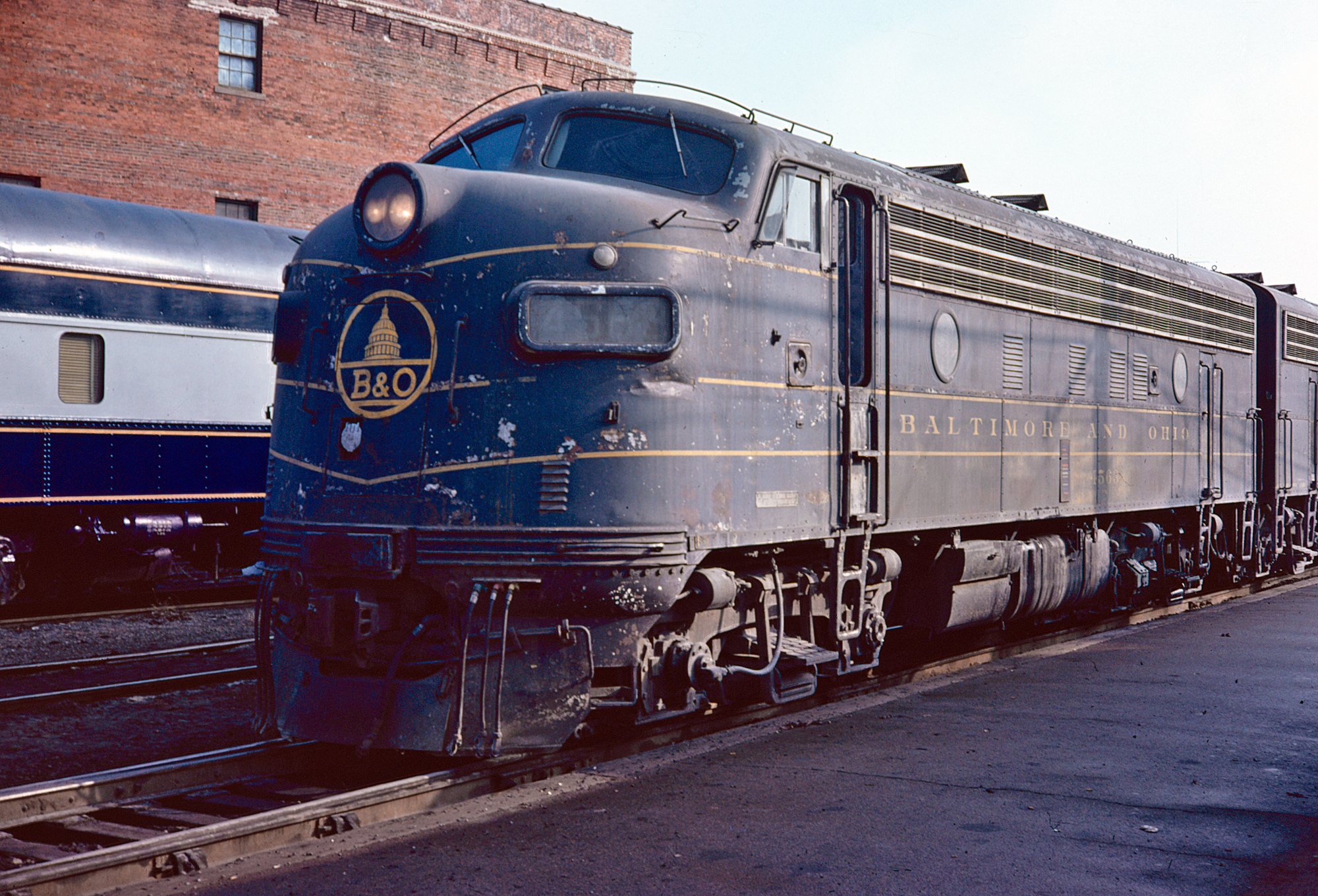 Baltimore & Ohio F7A #4563 sits at the west end of the High Yard in Parkersburg, West Virginia near OB Tower as the locomotive awaits departure to the west; February, 1974. Parkersburg was once a major division point along the St. Louis main line. American-Rails.com collection.
Baltimore & Ohio F7A #4563 sits at the west end of the High Yard in Parkersburg, West Virginia near OB Tower as the locomotive awaits departure to the west; February, 1974. Parkersburg was once a major division point along the St. Louis main line. American-Rails.com collection.Ohio & Mississippi Railway
The O&M was the B&O's link beyond Cincinnati to St. Louis. It began construction in 1854 and was completed in 1857 at around the same time as the M&C and NV.
It also constructed two branches, one linking Jeffersonville, Indiana near Louisville, Kentucky and the other connecting Shawneetown with Beardstown, Illinois via Flora.
The route was originally built to 6-foot gauge and later converted to standard gauge in July of 1871. In 1893 the B&O formally acquired the O&M and integrated it into the B&O Southwestern in 1900.
Ohio River Rail Road
The ORRR began construction south of Wheeling, West Virginia in 1882, backed with funding from the Rockefeller/Standard Oil interests. It was completed to Huntington, West Virginia in 1888 as it closely paralleled its namesake river.
In time oil and petrochemical industries sprang up along the route as the B&O took an interest in the property. It leased the ORRR during September of 1901 and purchased it in 1912.
The line not only offered growing freight traffic but also linked the B&O's main lines at Wheeling and Parkersburg while a southerly connection was established with the Chesapeake & Ohio at Huntington/Kenova.
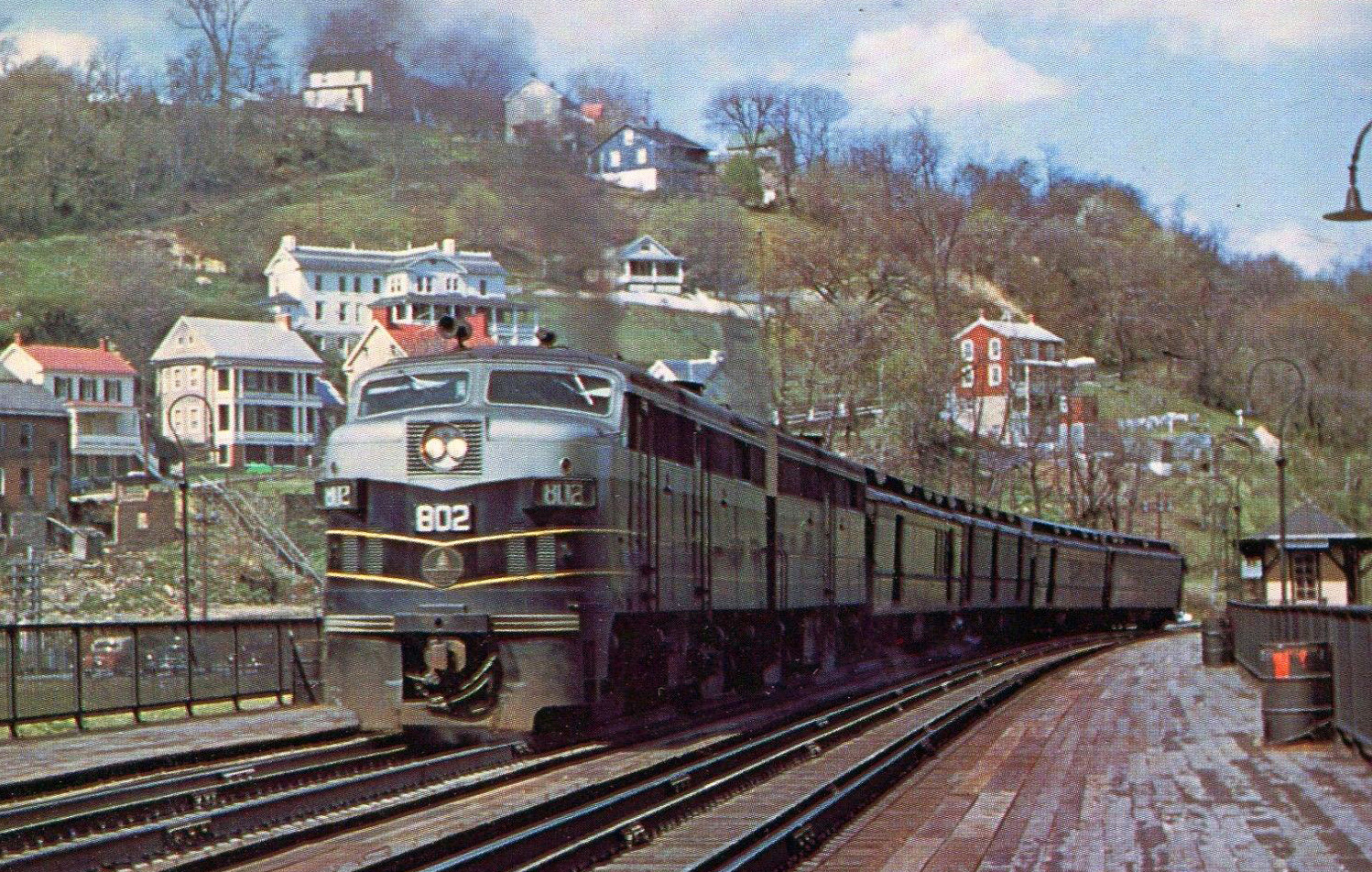 A Baltimore & Ohio FA-2/FB-2 set has train #34 heading eastbound through historic Harpers Ferry, West Virginia as it crosses the Potomac River in the spring of 1956. Clarence Cade photo.
A Baltimore & Ohio FA-2/FB-2 set has train #34 heading eastbound through historic Harpers Ferry, West Virginia as it crosses the Potomac River in the spring of 1956. Clarence Cade photo.Virginia Extension
As the B&O carried out its rapid expansion after the Civil War it fanned out in all directions, including the Deep South.
This idea was quite unique for an eastern road and had it been successful would likely have provided the B&O an important connection with systems like the Southern and Norfolk & Western.
Its first acquisition occurred on July 1, 1867 when it leased the Winchester & Potomac running 22 miles from its main line at Harpers Ferry to Winchester, Virginia.
It then acquired the 19-mile Winchester & Strasburg while in 1873 the Virginia Midland offered access as far south as Harrisonburg via Strasburg (50 miles) once completed the following year.
As it continued its push down the Shenandoah Valley the B&O-backed Valley Railroad, aiming for Salem (near Roanoke), made it only as far as Lexington in 1883 before further construction ceased.
The Baltimore road was busy with other ventures and with little local public support to complete the extension the VRR withered.
In 1896 the B&O, attempting to restructure its finances following bankruptcy sold its northern interests and the great project's fate was sealed. The VRR operated until the early 1940s when operations were suspended.
At the B&O’s peak the railroad served the markets of New York City, Philadelphia, Baltimore, Pittsburgh, Chicago, Buffalo, Detroit, and St. Louis via more than 6,000 route miles (over 10,000 miles in total). The B&O was always the underdog in an eastern market dominated by the PRR and NYC.
The company also had an on-and-off again struggle to remain independent as it once went into receivership in early 1896 and later ownership by the PRR. However, throughout it all the road steadfastly carried a pride that held true until its final days under CSX.
Despite its marginal financial situation the B&O holds many “firsts.” It was quick to adopt the more efficient mode of diesel power in 1930s and the first to include air-conditioning on its passenger trains.
Other accomplishments included the first to place electric locomotives in service (through its Howard Street tunnel in Baltimore, a project developed in conjunction with General Electric), championed the use of streamlined passenger trains early on, and pioneered dome cars in the eastern United States (tight clearances had largely restricted these east of the Mississippi River).
The B&O’s financial situation would, however, eventually catch up with it as a severe national recession in the 1950s saw the company in a serious situation and facing bankruptcy by the early 1960s.
It had been skillfully headed by Daniel Willard from 1910 until June of 1941, guiding the company through the struggles of World War I and the Great Depression era.
In his place stepped Roy White who also did a superb job through the World War II era. The 1950s, however, proved more problematic and new president Howard Simpson had to deal with these issues.
As traffic slipped, eroded by other modes of transportation, the road struggled after 1956 to sustain profitability.
It tried many tactics to curb losses, from slicing down its payroll to implementing new types of freight service such as intermodal/trailer-on-flat-car (TOFC). These efforts helped but by 1960 the B&O was showing significant losses.
Perhaps as a blessing the modern merger movement began at that time, kicked off by the Norfolk & Western's purchase of the Virginian Railway in 1959.
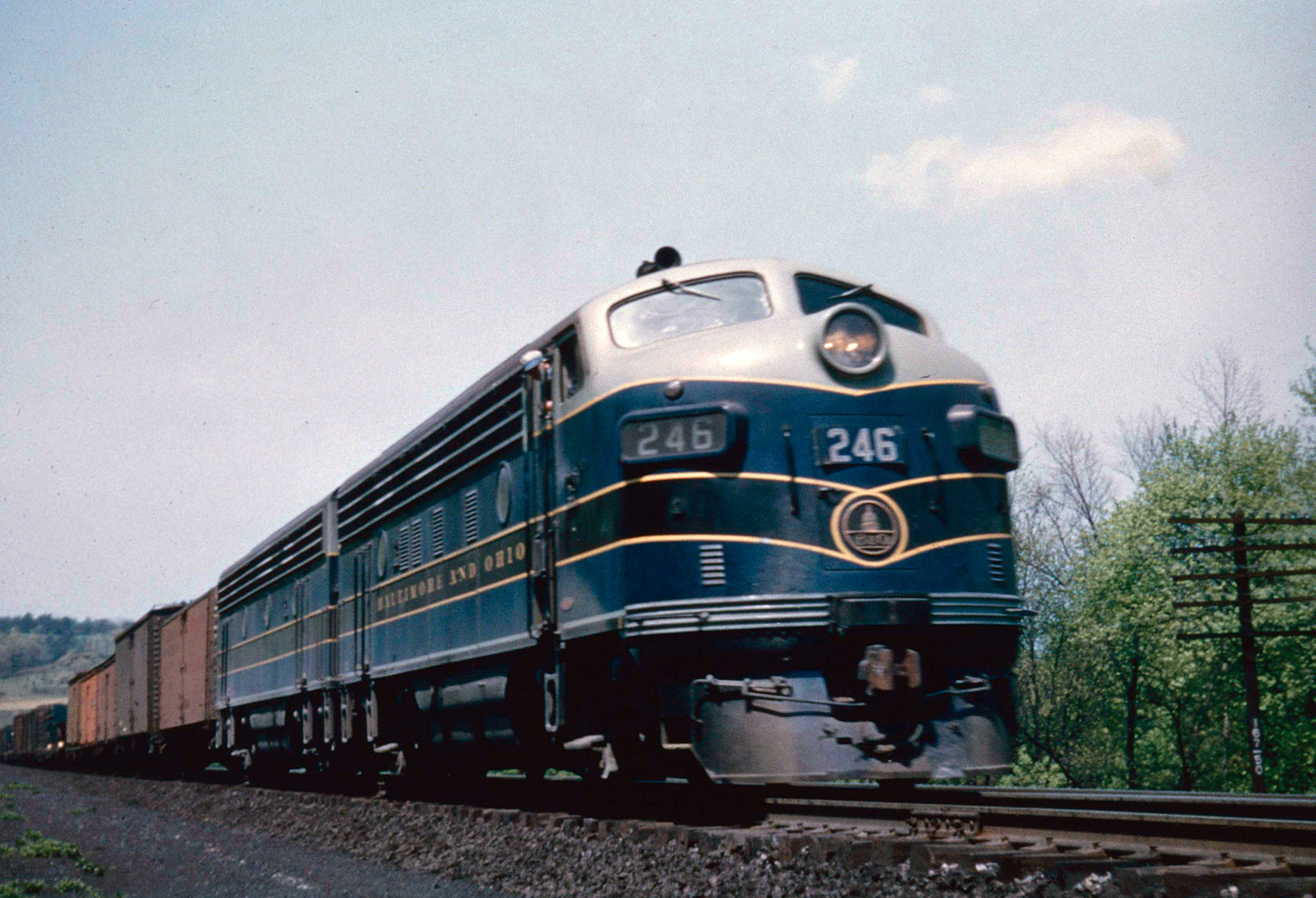 Baltimore & Ohio F7's are just east of Cumberland, Maryland with a general manifest during a spring day in the 1950s. Author's collection.
Baltimore & Ohio F7's are just east of Cumberland, Maryland with a general manifest during a spring day in the 1950s. Author's collection.C&O Acquisition
During this time the Chesapeake & Ohio Railway (C&O) took an interest in the company and would later win a battle with the NYC for control of the B&O.
After a drawn out process, Chessie was declared the victor. The Interstate Commerce Commission formally approved the merger on December 31, 1962.
A few months later, on February 4, 1963 the C&O took direct control. The B&O was to suffer a better fate than either the NYC or PRR, which would merge in 1968 to form the ill-fated Penn Central Corporation.
Chessie System
The C&O, for several reasons, chose to leave the B&O almost entirely independent, only gradually merging the operational aspects of both companies.
This finally changed in 1972 when both, including B&O-subsidiary Western Maryland, formed a holding company called the Chessie System in which all three were included.
An entire new livery was drawn up featuring a brilliant yellow, blue, and vermilion paint scheme adorned with a Chess-"C" silhouette of the C&O's famous Chessie the kitten napping on her pillow.
Baltimore Belt Railroad
The Baltimore Belt Railroad and Howard Street Tunnel project undertaken by the Baltimore & Ohio essentially kicked off electrified rail operations in the United States when it began service in 1895 (in 1888 when General Electric successfully demonstrated the motive power on the Richmond Union Passenger Railway).
The B&O’s project was constructed to fill a gap by connecting the railroad’s New York-Washington (north-south) and Washington – Cumberland (east-west) main lines.
According to the railroad's "Official List No. 29" issued January 1, 1948 notes the territory covered 7.2 miles from Milepost 90.7 at Bay View, Maryland to Milepost 97.9 at Hamburg Street, Baltimore.
Of this, 4 miles was electrified. Prior to this project it had used a circuitous car ferry operation across Baltimore Harbor, which made competing effectively with rival Pennsylvania Railroad nearly impossible.
After the first successful demonstration in Richmond, which involved a lightly powered locomotive, the motive power sprang up on light rail, interurban, and trolley systems all across the country.
The B&O's system used a 600 volt direct current system with four gearless, 360 horsepower, locomotives (or “motors” as electrics are often called).
The primary reason for the B&O’s Baltimore Belt Railroad was to solve a safety issue with its 1.4-mile long tunnel situated under residential neighborhoods where smoke would become a health issue.
Even by the late 19th century steam locomotives in large urban areas were becoming a serious health and safety issue due to their suffocating smoke and impairing vision.
The issue became all too real when a New York Central train collided with a New Haven suburban run in January of 1902 within New York City due to a smoke-obscured signal.
The result of this incident banned steam within downtown Manhattan and other cities began passing similar ordinances.
In all the B&O’s electrified system stretched three miles with initial power provided by General Electric that employed “steeple cab” electrics. First operated on May 1, 1895 the new line used steam locomotives fired by coke, which burned much cleaner than coal.
Electric Locomotive Classes
In all, the B&O employed six different classes of electric locomotives, which are listed below:
· Class LE-1: B&O’s first class of motors were delivered in 1895 and 1896 and were of a steeple-cab design totaling three units.
· Class LE-2: B&O’s second-class of motors were delivered between 1903 and 1906 by GE and were a boxcab design totaling four units.
· Class OE-1: B&O’s third-class of motors were delivered in 1910 by GE and were a steeple-cab design totaling two units.
· Class OE-2: B&O’s fourth-class of motors were delivered in 1912 by GE and were a steeple-cab design totaling two units.
· Class OE-3: B&O’s fifth-class of motors were delivered in 1923 by GE and were a steeple-cab design totaling two units.
· Class OE-4: B&O’s sixth, and final class of motors were delivered in 1923 by GE and were a steeple-cab design totaling two units.
Finally, the electrified system was completed about a month later and the first electrically powered train completed a test run on June 27th.
A few days later, on July 1st, the B&O introduced the revolutionary new mode of transportation to the public.
Initially, the company employed an overhead third-rail system, whereby “shoes” picked up power, similar to later overhead systems that used strung wires (catenary).
However, this system proved vulnerable to coal smoke and by 1900 a conventional third-rail system running near the ground was used.
One other addition was the railroad’s beautiful Mount Royal Station, constructed at the north end of Howard Street Tunnel. Today, the station remains in place and has been beautifully restored.
Final Years
The Chessie System, by far one of the best-loved railroad liveries ever created lasted only a short eight years; in 1980 the Chessie roads and those of the Family Lines/Seaboard Coast Line Industries (which was a holding company for a number of southeastern railroads including the Seaboard Coast Line and Louisville & Nashville) to form CSX Corporation on November 1st.
The creation of CSX entered the B&O into its last of many long and storied chapters. By now the company was merely a "paper" railroad (remaining in existence partly because of a tax exemption it retained in its home state of Maryland) and would be gone in only seven more years.
Passenger Trains
According to Trains Magazine, the Western Maryland was the first to disappear, merged into the B&O on May 1, 1983. The B&O survived until April 30, 1987 when it disappeared into the C&O (ironically it had just celebrated its 160th birthday on April 24th). Finally, the C&O was formally dissolved as a corporate entity on August 31, 1987.
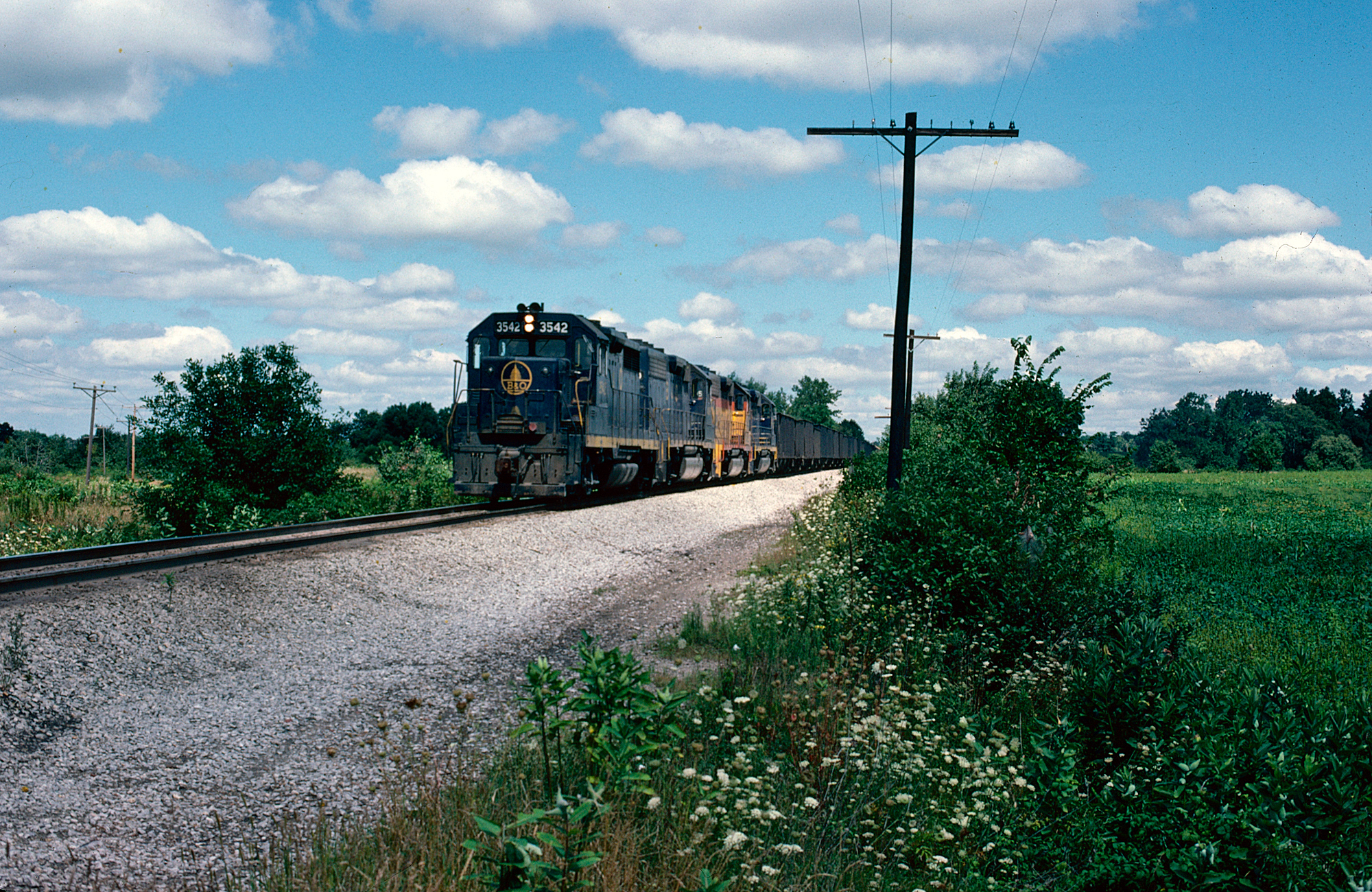 Baltimore & Ohio Geeps, led by GP35 #3542, are southbound near Chippewa Lake, Ohio on the CL&W Subdivision (Cleveland, Lorain & Wheeling); August 20, 1978. American-Rails.com collection.
Baltimore & Ohio Geeps, led by GP35 #3542, are southbound near Chippewa Lake, Ohio on the CL&W Subdivision (Cleveland, Lorain & Wheeling); August 20, 1978. American-Rails.com collection.Alas, the 1980s and the years to follow were not good for the former B&O lines as CSX began a long and continued campaign of abandoning or selling lines it deemed redundant/unprofitable. Unfortunately, large sections of its network were deemed as such.
In 1985, just as the intermodal container revolution was gaining steam, CSX announced intentions to sever its St. Louis main line between Clarksburg and Parkersburg, West Virginia (the "Parkersburg Branch") as well as much of the Ohio Division.
When the intermodal business truly took off soon afterwards CSX was left without a market to move containers competitively until its acquisition of Conrail in 1999.
This event has long since been questioned and had the line been left in place, upgraded to carry double-stack containers it would likely be profitable today, offering the shortest distance between the St. Louis gateway and east coast.
Diesel Roster
The Baltimore & Ohio's diesel locomotive roster was initially an eclectic array of road-switcher models from all of the major builders, except General Electric (the railroad did own a few GE switchers).
However, by the 1950s it was largely a loyal Electro-Motive customer, purchasing large batches of first-generation cab and GP units. Due to severe financial constraints by the 1950s, the railroad went nearly ten years without acquiring new locomotives.
That all changed with the Chesapeake & Ohio's acquisition in early February of 1963. The C&O was a very healthy company and its infusion of cash enabled the B&O to purchase large batches of second-generation power such as GP30's, GP35's, GP38's, GP40's, GP40-2's, and more.
The final new locomotives to wear any kind of "B&O" markings were a batch of SD50's that rolled of La Grange in 1984 wearing the Chessie System livery.
From a historical perspective the B&O had been fascinating line to railfan dating back to the late steam era with big 2-8-8-4 EM-1's and 2-10-2 "Big Sixes" working Sand Patch, and 4-8-2's hustling fast freights through the Midwest.
This enthusiasm continued into the diesel era as the railroad operated a variety of locomotives, ranging from Electro-Motive's very early EA passenger model to Baldwin's RF16 and Alco's stylish FA freight units.
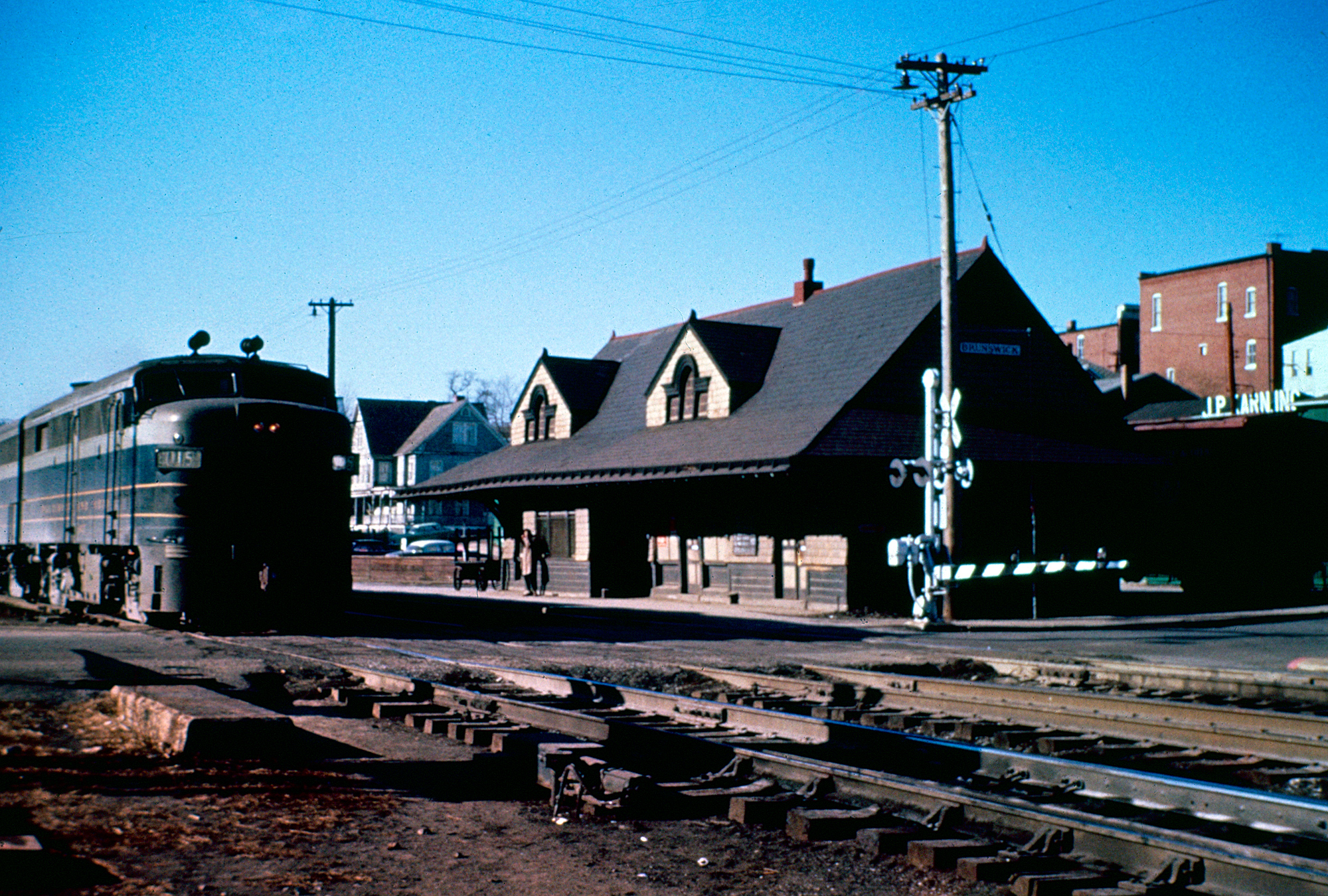 Baltimore & Ohio FA-2's head east past the depot at Brunswick, Maryland during the 1950s. American-Rails.com collection.
Baltimore & Ohio FA-2's head east past the depot at Brunswick, Maryland during the 1950s. American-Rails.com collection.In a move to eliminate steam locomotives in an urban setting and comply with a city's smoke abatement ordinance, the B&O put into service its first diesel in 1925.
That year it acquired a 60-ton, 300 horsepower boxcab produced by American Locomotive/General Electric/Ingersoll-Rand to carry out switching chores along its confined yard at 26th Street in New York City, situated on Manhattan's West Side.
Then, in 1935 the railroad acquired Electro-Motive's early boxcab design for main line service, an 1,800 horsepower testbed unit numbered 50.
It tested on Sand Patch and spent time pulling the Royal Blue between Washington and New York before being transferred to Abraham Lincoln on subsidiary Alton Railroad.
The railroad came back to Electro-Motive in 1937 for the streamlined variants of these boxcabs known as the EA model. The cab units featured a beautiful sweeping carbody with a slanted nose.
They went to work on the flagship Capitol Limited that year and the B&O was quite pleased with the units. From this point forward the railroad was a loyal EMD customer although did experiment with some models from other builders.
You could find Baldwins, FMs, and Alcos in yard work while the B&O even tried out a few of the latter's dual-service cab model, the FPA-2.
After the War Production Board eased restrictions on buying new diesels during World War II, the B&O picked up its efforts to fully dieselize its locomotive fleet in the late 1940s.
During the 1950s the Baltimore & Ohio purchased large batches of GP units, like the GP7, and even tried out Baldwin's unique AS616 road-switcher.
In 1958 the B&O had completed dieselization when its final steam locomotives entered retirement. Interestingly, this was also a period when the railroad was struggling financially.
It acquired its first GP30's in 1962 but it wasn't until the C&O's takeover a year later and subsequent cash infusion this acquisition provided that the railroad acquired the new power needed to meet increasing traffic demands.
Its final new power included a fleet of twenty SD50's, rated at 3,600 horsepower, delivered in the Chessie System livery in 1984.
American Locomotive (Alco)
| Model Type | Road Number (1st) | Road Number (2nd) | Road Number (3rd) | Order Number | Serial Number | Date Built | Quantity | Notes |
|---|---|---|---|---|---|---|---|---|
| Boxcab* | 1 | - | - | S1484 | Unknown | 1925 | 1 | - |
| S1 | 222-223 | 8010-8011 | 9150-9151 | Unknown | 70057, 72694 | 8/1944-9/1944 | 2 | - |
| S1 | 224-227 | 8012-8015 | 9152-9155 | S1942 | 72835-72836, 72840-72841 | 10/1944-11/1944 | 4 | - |
| S4 | 468-474, 542-545 | - | 9008-9018 | 20961 | 81320-81330 | 4/1955 | 11 | - |
| S2 | 475-481 | - | 9019-9025 | S1884 | 70248-70254 | 4/1943-11/1943 | 7 | - |
| S2 | 482-487 | - | 9026-9031 | S1915 | 71301-71303, 71309-71311 | 4/1943-11/1943 | 6 | - |
| S2 | 488-492 | - | 9032-9036 | Unknown | 76175-76184 | 4/1944-7/1944 | 5 | - |
| S2 | 493-496 | - | 9037-9040 | S1943 | 72727, 72892-72894 | 8/1944-1/1945 | 4 | - |
| S2 | 497-508 | - | 9041-9052 | S1943 | 72903-72909, 72912-72916 | 2/1945-5/1945 | 12 | - |
| S2 | 509-510 | - | 9053-9054 | 20243 | 76160-76161 | 8/1948 | 2 | - |
| S2 | 511-520 | - | 9055-9064 | 20243 | 76175-76184 | 9/1948-10/1948 | 10 | - |
| S2 | 521-524 | - | 9065-9068 | 20243 | 76202-76205 | 11/1948 | 4 | - |
| S2 | 525-533 | - | 9069-9077 | 20243 | 76500-76508 | 11/1948-12/1948 | 9 | - |
| S4 | 534-541 | - | 9000-9007 | Unknown | 80954-80959, 80962-80963 | 11/1953-12/1953 | 2 | - |
| FA-2 | 801-805 (Odds), 801A-805A (Odds) | 4000-4005 | - | Unknown | 78188-78193 | 10/1950-11/1950 | 6 | - |
| FB-2 | 801x-809x (Odds) | 5000-5003 | - | Unknown | 78198-78200, 78502 | 10/1950-1/1951 | 4 | - |
| FA-2 | 807, 807A | 4006-4007 | - | Unknown | 78266-78267 | 11/1950 | 2 | - |
| FPA-2 | 809-817 (Odds), 809A-817A (Odds) | 4008-4017 | - | 20551 | 78483-78492 | 12/1950-1/1951 | 10 | - |
| FB-2 | 809x-817x (Odds)** | 5004-5008 | - | Unknown | 78201, 78498-78501 | 12/1950-1/1951 | 5 | - |
| FB-2 | 817Ax | 5009 | - | Unknown | 78497 | 1/1951 | 1 | - |
| FA-2 | 819-823 (Odds), 819A-823A (Odds) | 4018-4023 | - | 20774 | 79710-79715 | 1/1952-2/1952 | 6 | - |
| FB-2 | 819x-823x (Odds) | 5010-5012 | - | Unknown | 79760-79762 | 1/1952 | 3 | - |
| FA-2 | 825-827 (Odds), 825A-827A (Odds) | 4024-4027 | - | 20774 | 79744-79746, 79955 | 3/1952 | 4 | - |
| FB-2 | 825x-835x (Odds) | 5013-5018 | - | Unknown | 80010-80013, 80030-80031 | 4/1952, 4/1953 | 6 | - |
| FA-2 | 829-831 (Odds), 829A-831A (Odds) | 4028-4031 | 4128-4131 | 20774 | 79956-79959 | 3/1952-4/1952 | 4 | - |
| FA-2 | 833-837 (Odds), 833A-837A (Odds) | 4032-4037 | 4132-4137 | 20848 | 79984-79989 | 4/1953-5/1953 | 6 | - |
| FB-2 | 837x, 837Ax | 5019-5020 | - | Unknown | 80032-80033 | 5/1953 | 2 | - |
| RSD12 | - | - | 2007-2016 | Unknown | 81943-81952 | 4/1956-5/1956 | 10 | Ex-Chesapeake & Ohio #6700-6709 |
| RS1 | - | - | 9185-9186 | 20871 | 80851-80852 | 9/1953 | 2 | Ex-Chesapeake & Ohio #5114-5115 |
| S4 | 9078-9097 | - | - | 21023 | 81860-81879 | 4/1956-6/1956 | 20 | - |
| S4 | 9098-9099 | - | - | 21023 | 81971-81972 | 6/1956 | 2 | - |
| S4 | 9100-9114 | - | - | 21055 | 81985-81999 | 2/1957-8/1957 | 15 | - |
| S2 | 9115-9144 | - | - | - | - | - | 30 | Ex-Chesapeake & Ohio*** |
| S2 | 9145-9149 | - | - | - | - | - | 5 | Ex-Lehigh Valley**** |
| S2 | 9160-9165, 9171-9184 | - | - | - | - | - | 20 | Ex-Chesapeake & Ohio***** |
* A joint GE/Alco/Ingersoll-Rand project. The boxcab employed 300 horsepower and could produce 7,900 pounds of tractive effort at 10.0 mph. Its top speed was 30 mph. The trio broke down the work as follows:
- Alco carried out mechanical work at its Schenectady, New York plant.
- Ingersoll-Rand supplied the engine from its Phillipsburg, New Jersey plant, and was responsible for sales.
- General Electric installed all electrical equipment and carried out testing at its Erie, Pennsylvania plant.
** Steam-generator equipped.
*** See Table Below
| Baltimore & Ohio Number | Chesapeake & Ohio Number | Serial Number | Date Built |
|---|---|---|---|
| 9115 | 5026 | 77165 | 10/1949 |
| 9116 | 5029 | 77798 | 10/1949 |
| 9117 | 5016 | 77141 | 10/1949 |
| 9118 | 5039 | 77807 | 11/1949 |
| 9119 | 5017 | 77142 | 10/1949 |
| 9120 | 5004 | 76783 | 6/1949 |
| 9121 | 5028 | 77797 | 10/1949 |
| 9122 | 5042 | 77811 | 11/1949 |
| 9123 | 5043 | 77812 | 11/1949 |
| 9124 | 5035 | 77803 | 11/1949 |
| 9125 | 5027 | 77796 | 10/1949 |
| 9126 | 5030 | 77799 | 10/1949 |
| 9127 | 5037 | 77806 | 10/1949 |
| 9128 | 5023 | 77148 | 10/1949 |
| 9129 | 5054 | 76899 | 1/1950 |
| 9130 | 5050 | 77944 | 1/1950 |
| 9131 | 5044 | 77813 | 11/1949 |
| 9132 | 5038 | 77807 | 10/1949 |
| 9133 | 5040 | 77809 | 11/1949 |
| 9134 | 5041 | 77810 | 11/1949 |
| 9135 | 5001 | 76771 | 5/1949 |
| 9136 | 5024 | 77149 | 10/1949 |
| 9137 | 5008 | 77133 | 9/1949 |
| 9138 | 5013 | 77138 | 10/1949 |
| 9139 | 5002 | 77165 | 10/1949 |
| 9140 | 5009 | 77134 | 9/1949 |
| 9141 | 5010 | 77135 | 9/1949 |
| 9142 | 5003 | 76782 | 6/1949 |
| 9143 | 5007 | 77132 | 9/1949 |
| 9144 | 5014 | 77139 | 10/1949 |
**** See Table Below
| Baltimore & Ohio Number | Lehigh Valley Number | Serial Number | Date Built |
|---|---|---|---|
| 9145 | 150 | 69952 | 8/1942 |
| 9146 | 153 | 69955 | 10/1942 |
| 9147 | 155 | 69878 | 10/1943 |
| 9148 | 161 | 70068 | 10/1949 |
| 9149 | 162 | 70069 | 11/1949 |
***** See Table Below
| Baltimore & Ohio Number | Chesapeake & Ohio Number | Serial Number | Date Built |
|---|---|---|---|
| 9160 | 5000 | 76770 | 5/1949 |
| 9161 | 5005 | 77130 | 9/1949 |
| 9162 | 5006 | 77131 | 9/1949 |
| 9163 | 5011 | 77136 | 10/1949 |
| 9164 | 5012 | 77137 | 10/1949 |
| 9165 | 5015 | 77140 | 10/1949 |
| 9171 | 5032 | 77801 | 11/1949 |
| 9172 | 5033 | 77802 | 11/1949 |
| 9173 | 5036 | 77805 | 10/1949 |
| 9174 | 5045 | 77827 | 12/1949 |
| 9175 | 5046 | 77828 | 12/1949 |
| 9176 | 5047 | 77941 | 12/1949 |
| 9177 | 5048 | 77942 | 12/1949 |
| 9178 | 5049 | 77943 | 1/1950 |
| 9179 | 5051 | 77945 | 1/1950 |
| 9180 | 5052 | 76897 | 1/1950 |
| 9181 | 5053 | 76898 | 1/1950 |
| 9182 | 5055 | 76900 | 1/1950 |
| 9183 | 5056 | 76901 | 1/1950 |
| 9184 | 5057 | 76902 | 1/1950 |
Baldwin Locomotive Works (BLW)
| Model Type | Road Number (1st) | Road Number (2nd) | Road Number (3rd) | Baldwin Serial Number(s) | Construction Number(s) | Date Built | Quantity | Notes |
|---|---|---|---|---|---|---|---|---|
| DS-4-4-1000 | 376 | - | 9250 | 1005 | 74778 | 7/14/1950 | 1 | - |
| DS-4-4-1000 | 377-381 | - | 9251-9255 | 1006-1010 | 74788-74792 | 7/14/1950 | 5 | - |
| DS-4-4-1000 | 382-385 | - | 9256-9259 | 1017-1020 | 74799-74800, 74881-74882 | 8/23/1950-8/25/1950 | 4 | - |
| DS-4-4-1000 | 386-399 | - | 9260-9273 | 1029-1042 | 74937-74950 | 8/28/1950-10/13/1950 | 14 | - |
| VO-1000 | 413, 415, 421, 429 | 9221-9224 | - | 168-170, 299, 416 | 67649, 67651, 70858, 71990 | 8/26/1943-1/24/1945 | 4 | - |
| VO-1000 | 414, 416 | 9200-9201 | - | 169, 171 | 67650, 67652 | 8/27/1943, 8/30/1943 | 2 | - |
| VO-1000 | 417-420 | 9202-9205 | - | 218-221 | 70112-70115 | 11/27/1943-12/1/1943 | 4 | - |
| VO-1000 | 422-427 | 9206-9211 | - | 300, 320, 332-335 | 70859, 70879, 71930-71933 | 5/8/1944-7/24/1944 | 6 | - |
| VO-1000 | 428, 430-432 | 9212-9215 | - | 415, 417-419 | 71989, 71991, 71426-71427 | 1/21/1945-1/28/1945 | 4 | - |
| VO-1000 | 433-437 | 9216-9220 | - | 427-431 | 71333-71337 | 2/19/1945-2/25/1945 | 5 | - |
| DS-4-4-1000 | 438-462 | - | 9225-9249 | 707-731 | 73839-73863 | 10/27/1948-12/25/1948 | 25 | - |
| DS-4-4-1200 | 463-467 | - | 9274-9278 | 408-412 | 75961-75965 | 11/11/1953-11/20/1953 | 5 | - |
| DR-4-4-1500 (A) | 847, 849 | 4200-4201 | - | 29, 30 | 73981, 73984 | 6/1949 | 2 | Acquired 3/1955: Ex-Elgin, Joliet & Eastern #700A-701A: Nee-Demonstrators #6001A, #6001A1. |
| DR-4-4-1500 (A) | 847x, 849x | 5200-5201 | - | 18-19 | 73982-73983 | 6/1949 | 2 | Acquired 3/1955: Ex-Elgin, Joliet & Eastern #700B-701B: Nee-Demonstrators #6001B, #6001B1. |
| RF16 (A) | 851-861 (Odds), 851-861A (Odds) | 4202-4213 | - | 1-12 | 74801-74811, 74816 | 11/7/1950-11/30/1950 | 12 | - |
| RF16 (A) | 863, 863A | 4214-4215 | - | 13-14 | 74817-74818 | 12/6/1950 | 2 | - |
| RF16 (A) | 865, 865A, 867, 869, 871 | 4216-4220 | - | 107-111 | 75386-75390 | 5/24/1952-5/21/1953 | 5 | - |
| RF16 (B) | 865x, 851x, 853x-861x (Odds), 867x-871x (Odds), 867Ax-871Ax (Odds) | - | - | 40-52 | 75413-75419, 75808-75813 | 5/15/1952-5/21/1953 | 13 | - |
| AS16 | 890-898 | 6207-6216 | 2241-2249 | 120-128 | 76096-76104 | 5/6/1955-6/30/1955 | 9 | - |
| AS16 | 899 | 6206 | 2240 | 105 | 75966 | 2/25/1954 | 1 | - |
| AS16 | 900-904 | 6200-6204 | 2234-2238 | 60-64 | 75498-75502 | 5/27/1952-6/3/1952 | 5 | - |
| AS16 | 905 | 6205 | 2239 | 92 | 75420 | 3/27/1953 | 1 | - |
| AS616 | 2250 | - | - | 83 | 75175 | 8/3/1951 | 1 | Built as Chesapeake & Ohio #5555, later became C&O #2219. |
Electro-Motive (EMC/EMD)
| Model Type | Road Number (1st) | Road Number (2nd) | Road Number (3rd) | Serial Number(s) | Order Number | Date Built | Quantity | Notes |
|---|---|---|---|---|---|---|---|---|
| SW | 2 | - | - | 653 | E152 | 12/1936 | 1 | Baltimore & Ohio Chicago Terminal. Rebuilt as SW1 #199 in May, 1942. Later renumbered again as 8422. |
| E8A | 26-32 (Evens), 26A-32A (Evens) | 1446-1453 | 1446-1453 | 18675-18682 | 2061 | 10/1953 | 8 | - |
| FTA | 1A-5A Odds), 1D-5D (Odds) | 101-111 (Odds) | 4400-4405 | 1633-1638 | E470 | 8/1942-9/1942 | 6 | - |
| FTB | 1B-5B (Odds), 1C-5C (Odds) | 101x-105X (Odds), 101Ax-105Ax (Odds) | 5400-5405 | 1645-1650 | E471 | 8/1942-9/1942 | 6 | - |
| FTA | 7A-11A (Odds), 7D-11D (Odds) | 101A-111A (Odds) | 4406-4411 | 1639-1644 | E470 | 8/1943-10/1943 | 6 | - |
| FTB | 7B-11B (Odds), 7C-11C (Odds) | 107x-111x (Odds), 107Ax-111Ax (Odds) | 5406-5411 | 1651-1656 | E471 | 8/1943-10/1943 | 6 | - |
| E9A | 34-40 (Evens) | 1454-1457 | 1454-1457 | 20377-20380 | 2069 | 5/1955 | 4 | - |
| Boxcab | 50 | - | - | 532 | E127 | 8/1935 | 1 | This 1,800 horsepower boxcab was first assigned to the New York-Washington, D.C. "Royal Blue" service. It was transferred to the Alton Railroad's "Abraham Lincoln" service in April, 1936. It later became Gulf, Mobile & Ohio #1200; retired in 1956 and now preserved at the Museum Of Transportation in St. Louis. |
| EA | 51 | 1433 | 1433 | 666 | E145 | 5/1937 | 1 | Rebuilt as E8Am #1433 (order #7507) in December, 1953. |
| EB | 51x-56x | 2414-2419 | 2414-2419 | 667, 669, 768-770, 801 | E146 | 5/1937-6/1938 | 6 | Rebuilt as E8Bm's #2414-2419 (order #7507) between May, 1953 and January, 1954. |
| EA | 52 | - | - | 668 | E145 | 6/1937 | 1 | Transferred to the Alton Railroad. |
| E6A | 52 (2nd) | - | - | 1094 | E322 | 10/1940 | 1 | - |
| EA | 53-54 | 1434-1435 | 1434-1435 | 765-766 | E189 | 1/1938 | 1 | Rebuilt as E8Am #1434-1435 (order #7507) in October, 1953 and January, 1954. |
| EA | 55-56 | 1436-1437 | 1436-1437 | 770, 801 | E191 | 6/1938 | 1 | Rebuilt as E8Am #1436-1437 (order #7507) between June-August, 1953. |
| E6A | 57-59 | 1408-1410 | 1408-1410 | 1091-1093 | E322 | 9/1940 | 3 | - |
| E6B | 57x-59x | 2407-2409 | 2407-2409 | 1095-1097 | E323 | 9/1940 | 3 | - |
| E6A | 60-63 | 1411-1414 | 1411-1414 | 1328-1331 | E388 | 6/1941-7/1941 | 4 | - |
| E6B | 60x-63x | 2410-2413 | 2410-2413 | 1332-1335 | E389 | 6/1941-7/1941 | 4 | - |
| E7A | 64, 64A, 66, 66A | 1415-1418 | 1415-1418 | 1673-1676 | E472 | 2/1945 | 4 | - |
| E7A | 68-80 (Evens), 68A-80A (Evens) | 1419-1432 | 1419-1432 | 2897-2910 | E642 | 9/1945-10/1945 | 14 | - |
| F3A | 82-88 (Evens), 82A-86A (Evens) | 1400-1406 | 4637-4643 | 4072-4078 | E757 | 7/1947 | 7 | Steam-generator equipped. |
| F3B | 82x-82Ax, 84x-84Ax | 2400-2403 | 5520-5523 | 4080-4083 | E757 | 7/1947 | 4 | - |
| F3B | 86x,86Ax, 88x | 2404-2406 | 5524-5526 | 4135-4137 | E757 | 7/1947 | 3 | - |
| E8A | 90, 90A, 92, 92A | 1438-1441 | 1463 (See Notes) | 10231-10234 | 2015 | 9/1950 | 4 | #92/#1440 was later renumbered as 1463. |
| E8A | 94, 94A, 96, 96A | 1442-1445 | 1442-1445 | 12712-12715 | 6162 | 9/1950-10/1950 | 4 | - |
| F3A | 113-151 (Odds), 113A-151A (Odds) | 4420-4459 | - | 5089-5128 | E865 | 4/1948-5/1948 | 40 | - |
| F3A | 153-151 (Odds), 153A-171A (Odds) | - | 4460-4479 | 5089-5128 | E940 | 11/1948-1/1949 | 20 | - |
| F7B | 153x-171x (Odds) | 5420-5429 | 5420-5429 | 12283-12292 | 3069 | 9/1950 | 10 | - |
| F7A | 180-192 (Evens), 180A-192A (Evens) | 4480-4493 | 4480-4493 | 7554-7567 | E1079 | 8/1949-10/1949 | 14 | - |
| F7B | 180x-184x (Evens), 180Ax-184Ax (Evens) | 5430-5435 | 5430-5435 | 7568-7573 | E1079 | 8/1949-9/1949 | 6 | - |
| F7B | 186x-192x (Evens), 186Ax-192Ax (Evens) | 5436-5443 | 5436-5443 | 8743-8750 | E1079 | 9/1949 | 8 | - |
| SW1 | 200-215 | - | 8400-8415 | 1098-1113 | E324 | 8/1940-9/1940 | 16 | - |
| SW1 | 217, 216, 218-221 | - | 8416-8421 | 1601-1606 | E462 | 5/1940-8/1940 | 6 | Baltimore & Ohio Chicago Terminal |
| F7A | 231-237, 239-243 (Odds), 239A-243A (Odds) | 4494-4503 | 4494-4503 | 10221-10230 | 8/1950 | 10 | - | |
| F7B | 231x-237x (Odds) | 5444-5447 | 5444-5447 | 11709-11712 | 3034 | 8/1950 | 4 | - |
| F7A | 245-245A, 247-247A | 4504-4507 | 4504-4507 | 11705-11708 | 8/1950 | 4 | - | |
| F7A | 249-263 (Odds), 249A-263A (Odds) | 4508-4523 | 4508-4523 | 12259-12274 | 3064 | 9/1950-10/1950 | 16 | - |
| F7B | 249x-263x (Odds) | - | 5448-5455 | 12275-12282 | 3064 | 9/1950-10/1950 | 8 | - |
| F7A | 265-279 (Odds), 265A-279A (Odds) | 4524-4539 | 4524-4539 | 12626-12641 | 6161 | 10/1950-12/1950 | 16 | - |
| F7B | 265-279x (Odds) | 5456-5463 | 5456-5463 | 12674-12681 | 6161 | 11/1950-12/1950 | 8 | - |
| F7A | 281-297 (Odds), 281A-297A (Odds), 361-361A | 4540-4559 | 4540-4559 | 12642-12661 | 6207 | 1/1951-2/1951 | 20 | - |
| F7B | 281x-297x (Odds), 361x | 5464-5473 | 5464-5473 | 12682-12691 | 6207 | 1/1951-2/1951 | 10 | - |
| F7A | 363-363A, 365-365A | 4560-4563 | 4560-4563 | 12662-12665 | 6161 | 1/1951-2/1951 | 4 | - |
| F7B | 363x-363Ax, 365x-365Ax | 5474-5477 | 5474-5477 | 12692-12695 | 6161 | 12/1950-1/1951 | 4 | - |
| F7A | 367-374 | 4564-4571 | 4564-4571 | 12666-12673 | 6161 | 12/1950-1/1951 | 8 | - |
| F7B | 367x-374x (Odds), 367Ax-374Ax (Odds) | 5478-5493 | 5478-5493 | 12696-12711 | 6161 | 12/1950-1/1951 | 16 | - |
| NW2 | 400-408 | - | 9500-9508 | 1114-1122 | E325 | 10/1940-11/1940 | 9 | - |
| NW2 | 409-411 | - | 9509-9511 | 1729-1731 | E463 | 1/1943 | 3 | Baltimore & Ohio Chicago Terminal |
| NW2 | 550-559 | - | 9542-9551 | 6673-6682 | E1086 | 9/1948-11/1948 | 10 | - |
| NW2 | 560-589 | - | 9512-9541 | 6683-6712 | E1022 | 1/1949-5/1949 | 30 | - |
| SW9 | 590-597 | - | 9600-9607 | 15886-15893 | 6366 | 2/1952-4/1952 | 8 | Baltimore & Ohio Chicago Terminal |
| SW9 | 598-603 | - | 9608-9613 | 19308-19313 | 4258 | 12/1953 | 6 | - |
| SW900 | 625-653 | - | 9400-9428 | 20384-20412 | 4301 | 5/1955-7/1955 | 29 | - |
| GP7 | 720-731 | 6413-6424 | 5613-5624 | 18694-18705 | 5301 | 9/1953 | 12 | - |
| GP7 | 740-746 | 3400-3406 | 6693-6699 | 18687-18693 | 5302 | 10/1953 | 7 | - |
| GP9 | 747-752 | 3417-3412 | 6600-6605 | 20417-20422 | 5388 | 4/1955 | 6 | - |
| GP9 | 675-690 | - | 6425-6440 | 20429-20444 | 5393 | 4/1955-5/1955 | 16 | - |
| GP9 | 691-696 | - | 6441-6446 | 20423-20428 | 5392 | 4/1955 | 6 | - |
| SD7 | 760 | 7400 | 1826 | 17410 | 6457 | 3/1952 | 1 | Ex-Demonstrator #991 |
| SD7 | 761-764 | 7401-7404 | 1827-1830 | 18683-18686 | 5303 | 11/1953 | 4 | - |
| SD9 | 765-766 | 7405-7406 | 1831-1832 | 20121-20122 | 5376 | 12/1954 | 2 | - |
| SD9 | 772 | 7412 | 1838 | 20123 | 5388 | 12/1954 | 1 | - |
| SD9 | 767-771 | 7407-7411 | 1833-1837 | 20124-20128 | 5376 | 12/1954 | 5 | - |
| SD9 | 773-774 | 7413-7414 | 1839-1840 | 20451-20452 | 5395 | 4/1955 | 2 | - |
| GP7 | 910-922 | 6400-6412 | 5600-5612 | 17499-17511 | 6294 | 1/1953 | 13 | - |
| F7A | 929-945 (Odds) | 4572-4580 | 4572-4580 | 15905-15913 | 3122 | 1/1952 | 9 | - |
| F7B | 929x-945x (Odds) | 5494-5502 | 5494-5502 | 15923-15931 | 3122 | 1/1952 | 9 | - |
| F7A | 929A-945A (Odds) | 4581-4589 | 4581-4589 | 15914-15922 | 3122 | 1/1952 | 9 | - |
| F7A | 947-961 (Odds), 947A-961A (Odds) | 4590-4605 | 4590-4605 | 16642-16657 | 3146 | 8/1952 | 16 | - |
| F7B | 947x-961x (Odds) | 5503-5510 | 5503-5510 | 16671-16678 | 3146 | 8/1952 | 8 | - |
| F7A | 963-975 (Odds), 963A-973A (Odds) | 4606-4618 | 4606-4618 | 16658-16670 | 3154 | 8/1952 | 13 | - |
| F7A | 977-993 (Odds), 977A-993A (Odds) | 4619-4636 | 4619-4636 | 17512-17529 | 6467 | 1/1953 | 18 | - |
| F7B | 977x-993x (Odds) | 5511-5519 | 5511-5519 | 17530-17538 | 6467 | 1/1953 | 9 | - |
| E8A | 1440 (2nd) | - | - | 14765 | 2015 | 8/1951 | 1 | Ex-Chesapeake & Ohio #4006. |
| E8A | 1460-1462 | - | - | 14760, 14770, 14776 | 2040 | 8/1951-12/1951 | 3 | Ex-Chesapeake & Ohio #4001, #4011, #4017. |
| E8A | 1464-1467 | - | - | 14766, 14768, 14771-14772 | 2040 | 8/1951-11/1951 | 4 | Ex-Chesapeake & Ohio #4007, #4009, #4012-4013. |
| GP9 | 3413-3418 | 6606-6611 | - | 22255-22260 | 5490 | 8/1956-10/1956 | 6 | - |
| GP9 | 3419-3425 | 6612-6618 | - | 22418-22424 | 5490 | 10/1956 | 7 | - |
| GP35 | 3500-3519 | - | - | 29090-29109 | 7716 | 3/1964-4/1964 | 20 | - |
| GP35 | 3540-3559 | - | - | 29372-29391 | 7736 | 7/1964-9/1964 | 20 | - |
| GP35 | 3581 | - | - | 31262 | 7863 | 12/1965 | 1 | - |
| GP40 | 3684-3699 | - | - | 32644-32659 | 7943 | 11/1966 | 15 | - |
| GP40 | 3700-3739 | - | - | 34823-34862 | 7158 | 2/1969-4/1969 | 40 | - |
| GP40 | 3740-3764 | - | - | 36721-36745 | 7275 | 12/1970-1/1971 | 25 | - |
| GP40 | 3765-3777 | - | - | 37189-37201 | 7301 | 2/1971-3/1971 | 13 | - |
| GP40 | 3778-3779 | - | - | 37202-37203 | 7317 | 3/1971 | 2 | - |
| GP38 | 3800-3849 | - | - | 33318-33367 | 7060 | 10/1967-11/1967 | 50 | - |
| GP38 | 3837 (2nd) | - | - | 33335 | 8085 | 7/1971 | 50 | - |
| GP40 | 4000-4054 | - | - | 38480-38534 | 7340 | 8/1971-10/1971 | 55 | - |
| GP40 | 4055-4064 | - | - | 38535-38544 | 7356 | 11/1971 | 10 | - |
| GP40-2 | 4100-4162, 1977 (1st), 4164 ("GM50") | - | - | 7365-1 thru 7365-65 | 7365 | 8/1972-11/1972 | 65 | #1977 celebrated the B&O's 150th anniversary while "GM50" marked Electro-Motive's 50 years of building locomotives. |
| GP40-2 | 4185-4246 | - | - | 74695-1 thru 74695-62 | 74695 | 4/1975-7/1975 | 62 | - |
| GP40-2 | 4247-4256 | - | - | 767034-1 thru 767034-10 | 767034 | 2/1977 | 10 | - |
| GP40-2 | 4287-4307 | - | - | 776091-1 thru 776091-21 | 777051 | 1/1978-2/1978 | 21 | - |
| GP40-2 | 4308-4311 | - | - | 777051-1 thru 777051-4 | 777051 | 3/1978 | 4 | - |
| GP40-2 | 4322-4351 | - | - | 787227-1 thru 787227-30 | 787227 | 2/1979-3/1979 | 30 | - |
| FTA | 4412-4413 | - | - | 3128-3129 | E654 | 5/1945 | 2 | Ex-New York, Ontario & Western #806-807. |
| GP40-2 | 4422-4447 | - | - | 807014-1 thru 807014-26 | 807014 | 5/1981-6/1981 | 26 | - |
| F7A | 4644-4647 | - | - | 11809-11812 | 6118 | 6/1950 | 4 | Ex-Bessemer & Lake Erie #701A-704A. |
| F7A | 4648-4651 | - | - | 13678-13681 | 3085 | 2/1951-3/1951 | 4 | Ex-Bessemer & Lake Erie #708A-711A. |
| F7A | 4652-4654 | - | - | 11813-11815 | 6118 | 6/1950 | 3 | Ex-Bessemer & Lake Erie #705A-707A. |
| GP38 | 4800-4819 | - | - | 36676-36695 | 8085 | 8/1970-12/1970 | 20 | - |
| NW2 | 5061-5064 | - | - | 10382-10385 | 6023 | 9/1949 | 4 | Ex-Chesapeake & Ohio #5061-5064. |
| NW2 | 5069 | - | - | 10370 | 6021 | 6/1949 | 1 | Ex-Chesapeake & Ohio #5069. |
| NW2 | 5074, 5076, 5079 | - | - | 10375, 10377, 10380 | 6021 | 6/1949-8/1949 | 3 | Ex-Chesapeake & Ohio 5074, 5076, 5079. |
| SW7 | 5215 | - | - | 10274 | 6075 | 1/1950 | 1 | Ex-Chesapeake & Ohio #5215. |
| FTB | 5412-5413 | - | - | 3136-3137 | E654 | 5/1945 | 2 | Ex-New York, Ontario & Western #806B-807B. |
| F7B | 5527-5533 | - | - | 11816-11822 | 6118 | 2/1951 | 7 | Ex-Bessemer & Lake Erie #701B-707B. |
| F7B | 5534-5537 | - | - | 13685-13688 | 3085 | 3/1951 | 4 | Ex-Bessemer & Lake Erie #708B-711B. |
| F7B | 5540 | - | - | 16026 | 3097 | 2/1952 | 1 | Ex-Chesapeake & Ohio #7519. |
| GP7 | 6405 (2nd) | - | - | 17504 | 8030 | 12/1953 | 1 | - |
| GP9 | 6447-6500 | - | - | 22191-22244 | 5477 | 8/1956-10/1956 | 54 | - |
| GP9 | 6498 (2nd) | - | - | 23624 | 8045 | 5/1957 | 1 | - |
| GP9 | 6501-6510 | - | - | 22245-22254 | 5489 | 10/1956 | 10 | - |
| GP9 | 6511-6562 | - | - | 22985-23036 | 5519 | 5/1957-7/1957 | 52 | - |
| GP9 | 6563-6570 | - | - | 23037-23044 | 5543 | 7/1957 | 8 | - |
| GP9 | 6571 | - | - | 23641 | 8046 | 5/1957 | 1 | - |
| GP9 | 6572-6598 | - | - | 24356-24382 | 5568 | 1/1958-2/1958 | 27 | - |
| GP9 | 6599 | - | - | 27086 | 7615 | 1/1962 | 1 | - |
| GP9 | 6650-6658 | - | - | 22101-22109 | 5473 | 6/1956-7/1956 | 9 | Ex-Chesapeake & Ohio #6100-6108. |
| GP9 | 6659-6661 | - | - | 22017-22019 | 5467 | 9/1956 | 3 | Ex-Chesapeake & Ohio #6109-6111. |
| GP9 | 6662-6683 | - | - | 22021-22042 | 5467 | 9/1956 | 22 | Ex-Chesapeake & Ohio #6113-6134. |
| GP30 | 6900-6927 | - | - | 27617-27644 | 7628 | 10/1962-11/1962 | 28 | - |
| GP30 | 6928-6976 | - | - | 27645-27693 | 7631 | 11/1962-1/1963 | 49 | - |
| SD35 | 7400-7419 | - | - | 29408-29427 | 7738 | 7/1964-10/1964 | 20 | - |
| SD35 | 7437-7440 | - | - | 30706-30709 | 7828 | 9/1965 | 4 | - |
| SD40 | 7482-7494 (See Notes) | 7591-7594 (See Notes) | - | 33161-33173 | 7998 | 5/1967 | 13 | Among this group, #7482-7490 were transferred to the Jersey Central while #7591-7594 were renumbered as #7591-7594. |
| SD40 | 7497-7500 | 7597-7599 (See Notes) | - | 34775-34778 | 7159 | 4/1969 | 4 | #7497-#7499 were renumbered as #7597-7599 while #7500 maintained its original number. |
| SD40-2 | 7600-7619 | - | - | 767033-1 thru 767033-20 | 767033 | 1/1977-2/1977 | 20 | - |
| SD20-2 | 7700-7704 | - | - | 29413, 29409, 29414, 29412 | 7738 | 2/1979-3/1979 | 5 | Ex-Baltimore & Ohio SD35's #7405, #7401, #7406, and #7404; de-rated to 2000 horsepower. |
| TR3A (Cow) | 9552, 9555 | - | - | 10253, 10256 | 6018 | 7/1949, 10/1949 | 2 | Ex-Chesapeake & Ohio #9552 and #9555; built as C&O #6500A and #6501A. |
| TR3B (Calf) | 9554, 9556 | - | - | 10254-10255 | 6018 | 7/1949 | 2 | Ex-Chesapeake & Ohio #9554 and #9556; built as C&O #6500B and #6500C. |
| TR3B (Calf) | 9553, 9557 | - | - | 10257-10258 | 6018 | 10/1949 | 2 | Ex-Chesapeake & Ohio #9553 and #9557; built as C&O #6500B and #6500C. |
| SW1200 | 9614-9621 | - | - | 23360-23367 | 4393 | 5/1957 | 8 | - |
Fairbanks-Morse (FM)
| Model Type | Road Number (1st) | Road Number (2nd) | Road Number (3rd) | Construction Number(s) | Contract Number(s) | Date Built | Quantity | Notes |
|---|---|---|---|---|---|---|---|---|
| H12-44 | 196-197 | - | 9720-9721 | 12L774-12L775 | LD157 | 9/1953 | 2 | - |
| H10-44 | 300-309 | - | 9700-9709 | 10L86-10L95 | LD151 | 11/1948-12/1948 | 10 | - |
| H12-44 | 310-319 | - | 9710-9719 | 12L392-12L401 | LD103 | 2/1951 | 10 | - |
| H16-44 | 906-907 | 6700-6701 | - | 16L697-16L598 | LD144 | 12/1952 | 2 | Leased to the CNJ in November, 1967 and numbered 18-19. Returned to the B&O the following year, both were to be renumbered as 9735-9736. However, the units were retired and scrapped in January, 1970 prior to this last renumbering. |
| H16-44 | 925-926 | 6702-6703 | 9737-9738 | 16L961-16L962 | LD178 | 4/1955 | 2 | - |
| H16-44 | 927 | 6704 | 9739 | 16L969 | LD178 | 4/1955 | 1 | - |
| H16-44 | 6705-6709 | 9740-9743 | - | 16L1144-16L1148 | LD211 | 3/1957 | 5 | #6709 was wrecked prior to its renumbering, which would have been 9744. |
| H12-44 | 9722-9726 | - | - | 12L1089-12L1093 | LD213 | 4/1957 | 5 | - |
General Electric (GE)
| Model Type | Road Number (1st) | Road Number (2nd) | Road Number (3rd) | Serial Number(s) | Date Built | Quantity | Notes |
|---|---|---|---|---|---|---|---|
| 44-Ton | 19-20 | 8801-8802 | 8300-8301 | 30470-30471 | 9/1950-10/1950 | 2 | - |
| 65-Ton | 194 | 8810 | - | 18072 | 12/1943 | 1 | - |
| 80-Ton | 198 | 8820 | - | 18011 | 9/1943 | 1 | - |
Lima-Hamilton Locomotives
Lima never gave model names to its diesel line.
| Model Type | Road Number (1st) | Road Number (2nd) | Road Number (3rd) | Construction Number(s) | Order Number(s) | Date Built | Quantity | Notes |
|---|---|---|---|---|---|---|---|---|
| 1,000 Horsepower Switcher | 330-331 | - | 9366-9367 | 9347-9348 | 1212-3 thru 1212-4 | 12/1949-1/1950 | 2 | - |
| 1,000 Horsepower Switcher | 332-337 | - | 9381-9386 | 9347-9348 | 1212-5 thru 1212-10 | 1/1950-2/1950 | 6 | - |
| 1,000 Horsepower Switcher | 338-339 | - | 9374-9375 | 9392-9393 | 1214-1 thru 1214-2 | 3/1950 | 2 | - |
| 1,200 Horsepower Switcher | 320-327 | 9376-9383 | - | 9468-9475 | 1219-12-19 | 12/1950 | 8 | - |
| 1,200 Horsepower Switcher | 328-329 | 9384-9385 | - | 9476-9477 | 1219-20-21 | 1/1951 | 2 | - |
| 1,200 Horsepower Switcher | 340-343 | 9386-9389 | - | 9478-9481 | 1219-22-25 | 1/1951 | 4 | - |
| 1,200 Horsepower Switcher | 344-352 | 9390-9398 | - | 9482-9490 | 1219-26-34 | 2/1951 | 9 | - |
| 1,200 Horsepower Switcher | 353 | 9399 | - | 9491 | 1219-35 | 3/1951 | 1 | - |
Plymouth Locomotive Works
| Model Type | Road Number (1st) | Road Number (2nd) | Road Number (3rd) | Date Built | Quantity | Notes |
|---|---|---|---|---|---|---|
| 25-Ton | 25 | 8900 | - | 1/1926 | 1 | - |
Steam Roster (Post 1900)
As the nation's first common-carrier, the B&O operated an array of different wheel arrangements, from the ubqitious 4-4-0 to the monster 2-8-8-4.
During the 19th century the railroad relied on the common types of that era, such as the American, Mogul, and early Consolidations (its first being purchased in 1873).
Into the modern, post-1900 time period the B&O acquired increasingly larger, heavier, and more powerful arrangements to handle freight and heavyweight passenger movements over the stiff grades found on its West End.
General freight movements tended to be operated by 2-8-2s, 4-8-2s, and 2-8-0s while large articulateds like 2-8-8-0s, 2-8-8-2s, and 2-8-8-4s worked heavy drag service. Passenger assignments were generally carried out by 4-6-2s and, in some cases, 4-8-2s.
The B&O was an early proponent of articulated/Mallet designs and, in fact, operated the first example in the U.S., 0-6-6-0 "Old Maude" completed at Alco's Schenectady Works in 1904. The locomotive was based from Anatole Mallet's 1885 concept and spearheaded on the B&O by superintendent of motive power, John E. Muhlfeld.
Ironically, however, the railroad was not a big proponent of compound steam. Its most famous large articulateds were the 2-8-8-4 EM-1s acquired in the mid-1940s from Baldwin.
| Wheel Arrangement | Class | Number(s) | Quantity | Builder | Date Built | Retirement | Notes |
|---|---|---|---|---|---|---|---|
| 4-4-4 | J-1 | 1/5330 (named the "Lady Baltimore") | 1 | B&O (Mount Clare Shops) | 1934 | 1949 | - |
| 4-6-4 | V-2 | 2/5340, "Lord Baltimore" | 1 | B&O (Mount Clare Shops) | 1935 | 1949 | - |
| 0-4-0 | C-13 | 76-77 | 2 | Baldwin | 1902 | By 1948 | - |
| 0-6-0 | D-29 | 91-94 | 4 | Alco (Pittsburgh Works) | 1900-1901 | By 1930 | Ex-Cincinnati, Hamilton & Dayton |
| 0-4-0T | C-16 | 96-99 | 4 | Baldwin | 1912 | 1944-1951 | - |
| 4-6-0 | B-55 | 163 | 1 | Baldwin | 1906 | 1947 | Ex-Morgantown & Kingwood |
| 4-6-0 | B-56 | 164 | 1 | Baldwin | 1909 | 1946 | Ex-Morgantown & Kingwood |
| 4-6-0 | B-57 | 165-170 | 6 | Alco (Schenectady) | 1916 | By 1938 | Ex-Cincinnati, Indianapolis & Western |
| 4-6-0 | B-58 | 171-180 | 10 | Baldwin | 1916 | By 1953 | Ex-Cincinnati, Indianapolis & Western |
| 0-6-0 | D-35 | 330-332 | 3 | Alco (Cooke Works) | 1902 | By 1928 | Ex-Cincinnati, Indianapolis & Western |
| 0-6-0 | D-36 | 333-335 | 3 | Alco (Brooks Works) | 1905 | By 1934 | Ex-Cincinnati, Indianapolis & Western |
| 0-6-0 | D-37 | 336-338 | 3 | Alco (Brooks Works) | 1901 | By 1934 | Ex-Cincinnati, Indianapolis & Western |
| 0-6-0 | D-38 | 339-343 | 5 | Lima | 1916 | By 1934 | Ex-Cincinnati, Indianapolis & Western |
| 0-6-0 | D-30 | 350-369 | 20 | Baldwin | 1919 | By 1956 | USRA |
| 0-6-0 | D-30 | 370-389 | 20 | Alco | 1919 | By 1956 | USRA |
| 0-6-0 | D-44 | 390-394 | 3 | Alco (Brooks Works) | 1904 | By 1954 | Ex-Buffalo, Rochester & Pittsburgh |
| 2-8-0 | E-37 | 413 | 1 | Baldwin | 1906 | 1936 | Ex-Morgantown & Kingwood |
| 2-8-0 | E-38 | 414 | 1 | Baldwin | 1918 | By 1939 | Ex-Morgantown & Kingwood |
| 2-8-0 | E-39 | 415-416 | 2 | Baldwin | 1903 | 1947 | Ex-Morgantown & Kingwood |
| 2-8-0 | E-40 | 417-422 | 6 | Baldwin | 1907-1909 | By 1938 | Ex-Morgantown & Kingwood |
| 2-8-0 | E-41 | 425-434 | 10 | Baldwin | 1916 | By 1950 | Ex-Cincinnati, Indianapolis & Western |
| 2-8-0 | E-43 | 436 | 1 | Baldwin | 1900 | 1929 | Ex-Cincinnati, Indianapolis & Western |
| 2-8-0 | E-44 | 437-438 | 2 | Alco (Schenectady) | 1901 | 1929 | Ex-Cincinnati, Indianapolis & Western |
| 2-8-0 | E-45 | 439 | 1 | Alco (Schenectady) | 1905 | 1934 | Ex-Cincinnati, Indianapolis & Western |
| 0-8-0 | L-2 thru L-2c | 600-714 | 115 | B&O (Mount Clare Shops) | 1924-1941 | By 1959 | Former E-27 2-8-0s |
| 4-4-0 | G-18 | 630 | 1 | Baldwin | 1903 | By 1936 | Ex-Morgantown & Kingwood |
| 4-4-0 | H-12 | 717-718 | 2 | Baldwin | 1905 | By 1929 | Ex-Coal & Coke |
| 0-8-0 | L-4, L-4a | 772-789 | 18 | Alco (Brooks Works) | 1918, 1923 | 1956-1958 | Ex-Buffalo, Rochester & Pittsburgh |
| 4-4-0 | M-3 | 862-863 | 2 | Baldwin | 1906 | By 1936 | Ex-Coal & Coke |
| 4-4-0 | M-4 | 864 | 1 | Baldwin | 1912 | 1934 | Ex-Coal & Coke |
| 4-4-0 | M-5 | 865-867 | 3 | Alco (Brooks Works) | 1904 | By 1930 | Ex-Cincinnati, Indianapolis & Western |
| 4-4-0 | M-6/a | 868-869 | 2 | Alco (Schenectady Works) | 1904, 1906 | 1929-1930 | Ex-Cincinnati, Indianapolis & Western |
| 2-6-0 | K-16 | 901-910 | 10 | Baldwin | 1911 | By 1949 | - |
| 0-10-0 | U | 950-951 | 2 | B&O (Mount Clare Shops) | 1926-1927 | 1953 | - |
| 0-8-0 | L-1, L-1a | 1000-1085 | 86 | B&O (Mount Clare Shops) | 1923-1929 | By 1959 | Former E-24 2-8-0s |
| 0-6-0 | D-7 | 1137-1176 | 40 | Alco (Richmond Works) and Baldwin | 1901, 1903 | By 1948 | - |
| 0-6-0 (Camelback) | D-23 | 1180-1184 | 5 | Baldwin | 1906 | By 1947 | - |
| 0-6-0 | D-12 | 1197 | 1 | Alco (Richmond Works) | 1925 | 1953 | - |
| 4-6-0 | B-17 | 1328-1336 | 9 | Baldwin | 1901 | By 1935 | Vauclain compound locomotives. |
| 4-4-2 | A-3 | 1424-1449 | 25 | Baldwin | 1910 | 1944 | - |
| 4-4-2 | A, A-1 | 1450-1455 | 6 | Baldwin | 1900-1901 | By 1929 | Vauclain compound locomotives. |
| 4-4-2 | A-2 | 1456-1475 | 20 | Alco (Schenectady) | 1903 | Retired between 1933 and 1947. | - |
| 4-4-2 | A-9 | 1484-1485 | 2 | Alco (Schenectady Works) | 1904 | 1948 | Ex-Buffalo & Susquehanna |
| 4-4-2 | A-10 | 1486 | 1 | Alco (Brooks Works) | 1906 | 1936 | Ex-Buffalo & Susquehanna |
| 4-4-2 | A-6 | 1487-1488 | 2 | Alco (Brooks Works) | 1901 | 1937 | Ex-Buffalo, Rochester & Pittsburgh |
| 4-4-2 | A-6 | 1489-1491 | 3 | Alco (Brooks Works) | 1901 | 1936 | Ex-Buffalo, Rochester & Pittsburgh |
| 4-4-2 | A-8/a | 1492-1496 | 5 | Alco (Brooks Works) | 1906-1909 | 1937 | Ex-Buffalo, Rochester & Pittsburgh |
| 2-8-0 | E-29 | 1706-1721 | 16 | Alco (Brooks Works) | 1905 | By 1937 | Ex-Cincinnati, Hamilton & Dayton |
| 2-8-0 | E-30 | 1722-1736 | 15 | Baldwin | 1905 | By 1937 | Ex-Cincinnati, Hamilton & Dayton |
| 2-8-0 | E-32 | 1737-1740 | 4 | Baldwin | 1904-1905 | By 1939 | Ex-Coal & Coke |
| 2-8-0 (Compound) | E-19 | 1771-1779, 1800-1899 | 109 | Baldwin | 1900-1901 | By 1935 | - |
| 2-8-0 (Compound) | E-18 | 1900-1938 | 39 | Baldwin | 1900 | By 1936 | - |
| 2-8-0 (Compound) | E-19 | 1939-1940 | 2 | Baldwin | 1900 | By 1936 | - |
| 2-8-0 | E-23 | 1955-1958 | 4 | Alco (Schenectady) | 1902 | By 1925 | - |
| 2-8-0 | E-19a | 1959-1965 | 7 | Baldwin | 1903 | By 1935 | - |
| 4-6-0 | B-18 | 2000-2034 | 35 | Alco (Rhode Island Works) | 1901 | By 1953 | - |
| 4-6-0 | B-19 | 2035-2069 | 35 | Baldwin | 1901 | By 1934 | Vauclain compound locomotives. |
| 2-8-0 | E-24 | 2200-2397 | 198 | Alco (Pittsburgh, Rogers, Richmond Works) | 1902-1904 | By 1956 | - |
| 2-6-0 | K-17 | 2441-2450 | 10 | Lima | 1917 | By 1954 | - |
| 2-8-0 | E-27 | 2500-2913 | 414 | Alco (Schenectady, Richmond Works) | 1905-1910 | By 1959 | - |
| 2-8-0 | E-31 | 2914-2933 | 20 | Alco (Brooks Works) | 1910 | By 1954 | Ex-Cincinnati, Hamilton & Dayton |
| 2-8-0 | E-33 | 2934-2945 | 12 | Baldwin | 1903-1906 | By 1950 | Ex-Coal & Coke |
| 2-8-0 | E-34 | 2946-2949 | 4 | Baldwin | 1912-1913 | By 1950 | Ex-Coal & Coke |
| 2-8-0 | E-35 | 2950-2951 | 2 | Baldwin | 1914 | By 1950 | Ex-Coal & Coke |
| 2-8-0 | E-36 | 2952-2953 | 2 | Baldwin | 1916 | By 1950 | Ex-Coal & Coke |
| 2-8-0 | E-52 thru E-58 | 3010-3096 | 87 | Baldwin, Alco (Brooks Works) | 1901-1909 | By 1950 | Ex-Buffalo, Rochester & Pittsburgh |
| 2-8-0 | E-60/a | 3100-3142 | 43 | Alco (Brooks, Pittsburgh Works) | 1904-1908 | By 1957 | Ex-Buffalo & Susquehanna |
| 2-8-2 | Q-1 | 4000-4159 | 160 | Baldwin | 1911 | By 1956 | - |
| 2-8-2 | Q | 4160-4161 | 2 | Baldwin | 1911-1912 | 1949 | Rebuilt from 2-8-0s. |
| 2-8-2 | Q-2 | 4162-4169 | 8 | Lima | 1916 | By 1950 | Ex-Cincinnati, Indianapolis & Western |
| 2-8-2 | Q-1b | 4170-4219 | 50 | Baldwin | 1912 | By 1956 | - |
| 2-8-2 | Q-4/a/b | 4400-4499, 4600-4634 | 135 | Baldwin | 1920-1923 | By 1959 | - |
| 2-8-2 | Q-3 | 4500-4599 | 100 | Baldwin | 1918 | By 1959 | - |
| 2-8-2 | Q-4d | 4635-4637 | 3 | B&O (Mount Clare Shops) | 1941-1942 | 1955 | - |
| 2-8-2 | Q-10 | 4700-4747 | 48 | Alco (Brooks Works) | 1912-1917 | By 1959 | Ex-Buffalo, Rochester & Pittsburgh |
| 4-6-2 | P | 5000-5034 | 35 | Alco (Schenectady) | 1906 | By 1950 | - |
| 4-6-4 | V-1 | 5047 | 1 | B&O (Mount Clare Shops) | 1933 | 1950 | - |
| 4-6-2 | P-2 | 5095-5099 | 5 | Alco (Schenectady) | 1910 | By 1948 | Ex-Cincinnati, Hamilton & Dayton |
| 4-6-2 | P-3 | 5100-5129 | 30 | Baldwin | 1913 | By 1952 | - |
| 4-6-2 | P-4 | 5130-5139 | 10 | Baldwin | 1917 | By 1953 | Featured Vanderbilt tenders. |
| 4-6-2 | P-17 | 5140-5148 | 9 | Alco (Brooks Works) | 1912-1913 | By 1953 | Ex-Buffalo, Rochester & Pittsburgh |
| 4-6-2 | P-18 | 5185-5192 | 8 | Alco (Brooks Works) | 1918 | By 1953 | Ex-Buffalo, Rochester & Pittsburgh |
| 4-6-2 | P-8 | 5196-5199 | 4 | Alco (Schenectady Works) | 1924 | By 1952 | Ex-Cincinnati, Indianapolis & Western |
| 4-6-2 | P-5 | 5200-5219 | 20 | Baldwin | 1919 | By 1956 | USRA Light Locomotives |
| 4-6-2 | P-5 | 5220-5229 | 10 | Alco (Schenectady) | 1919 | By 1956 | USRA Light Locomotives |
| 4-6-2 | P-6 | 5230-5244 | 15 | Baldwin | 1922 | By 1949 | Featured Vanderbilt tenders. |
| 4-6-2 | P-19 | 5260-5264 | 5 | Alco (Brooks Works) | 1923 | By 1953 | Ex-Buffalo, Rochester & Pittsburgh |
| 4-6-2 | P-7 | 5300-5319 | 20 | Baldwin | 1927 | By 1958 | Presidents Class |
| 4-6-2 | P-9 | 5320 | 1 | B&O (Mount Clare Shops) | 1928 | 1956 | Class P-7 named "President Cleveland" featuring Caprotti valve gear and a watertube boiler. Rebuilt in 1945 to a standard P-7. |
| 4-6-4 | V-3 | 5350 | 1 | B&O (Mount Clare Shops) | 1935 | 1950 | - |
| 4-6-4 | V-4 | 5360 | 1 | B&O (Mount Clare Shops) | 1936 | 1950 | - |
| 4-8-2 | T | 5500-5501 | 2 | B&O (Mount Clare Shops) | 1925-1926 | 1953 | - |
| 4-8-2 | T-1 | 5510 | 1 | Baldwin | 1930 | 1951 | - |
| 4-8-2 | T-2 | 5550 | 1 | Baldwin | 1930 | 1952 | - |
| 4-8-2 | T-3 | 5555-5594 | 40 | B&O (Mount Clare Shops) | 1943-1948 | By 1960 | - |
| 4-8-2 | T-3 | 5650-5662 | 13 | Baldwin | 1935-1940 | By 1958 | Ex-Boston & Maine |
| 4-4-4-4 | N-1 | 5600, "George H. Emerson" | 1 | B&O (Mount Clare Shops) | 1937 | 1950 | Original duplex drive design. |
| 2-10-2 | S | 6000-6030 | 31 | Baldwin | 1914 | By 1953 | - |
| 2-10-2 | S-1 | 6100-6224 | 125 | Baldwin, Lima | 1923-1926 | By 1959 | - |
| 2-10-0 | Y | 6500-6507 | 8 | Alco (Brooks Works) | 1907-1909 | By 1951 | Ex-Buffalo, Rochester & Pittsburgh |
| 0-6-6-0 | DD-1 | 7000 ("Old Maude") | 1 | Alco (Schenectady) | 1904 | 1938 | - |
| 0-8-8-0 | LL-1 | 7020-7049 | 30 | Alco (Schenectady) | 1911 | By 1950 | - |
| 2-8-8-0 | EL-4 | 7020, 7023, 7032-7033, 7036, 7038-7040, 7049 | 9 | B&O (Mount Clare Shops) | 1919-1923 | By 1950 | Ex-Class LL-1 |
| 2-8-8-0 | EL-1 | 7100-7114 | 15 | Baldwin | 1916 | By 1954 | - |
| 2-8-8-0 | EL-3 | 7115-7144 | 30 | Baldwin | 1917 | By 1952 | - |
| 2-8-8-0 | EL-5 | 7145-7170 | 26 | Baldwin | 1919-1920 | By 1954 | - |
| 2-8-8-0 | EL-2 | 7200-7214 | 15 | Baldwin | 1916 | By 1952 | - |
| 2-8-8-0 | EL-6/a | 7300-7315 | 16 | B&O (Mount Clare Shops) | 1922 (Sold to the B&O in November, 1920 and rebuilt as simple expansion engines in 1922.) | By 1954 | Ex-Seaboard Air Line 2-8-8-2s. |
| 2-8-8-2 | EE-2/a | 7316-7324 | 9 | Alco (Brooks Works) | 1918-1923 | 1950-1951 | Ex-Buffalo, Rochester & Pittsburgh |
| 2-6-6-2 | KK-1 | 7400 | 1 | Baldwin | 1930 | 1953 | Equipped with watertube firebox. |
| 2-6-6-2 | KK-2 | 7450 | 1 | Baldwin | 1930 | 1953 | - |
| 2-6-6-2 | KK-4 | 7500-7554 | 55 | Alco (Schenectady, Brooks Works) | 1930 | By 1951 | - |
| 2-8-8-4 | EM-1 | 7600-7629 | 30 | Baldwin | 1944 | By 1960 | - |
| 2-6-6-4 | KB-1 | 7700-7709 | 10 | Baldwin | 1935-1937 | 1953 | Ex-Seaboard Air Line |
Notable Steam Classes
Class E (2-8-0)
Like most railroads the B&O found the ubiquitous and rugged 2-8-0 very useful in all types of applications from heavy freight service to secondary passenger assigments.
The wheel arrangement offered just the right blend of speed and power to find work just about anywhere.
If you were a railfan in the 1940s or '50s, and exploring one of the railroad's numerous branch lines, there was a good chance you would have seen one of these locomotives in operation. The B&O went to on roster hundreds either purchased new, rebuilt, or acquired via a predecessor.
As David Mainey points out in his book, "Baltimore & Ohio Steam In Color," the B&O had an odd way of classifying its Consolidations; sometimes a lower subclass was actually a newer and more advanced design.
Such characteristics only added to the B&O's already confusing system that was often a dizzying array of rebuilds, additions, or some other change. Alas, no examples of the railroad's modern Consolidations were preserved although an early example is on display at the B&O Railroad Museum.
The B&O's 2-8-0s are far too numerous to cover in great detail here and only a brief overview will be provided. The Consolidation was quite a leap in power for the industry following its 1865 introduction as its heavier frame and larger boiler provided increased tractive effort and horsepower.
The B&O took delivery of its first 2-8-0 in 1873 and soon found them ideal for freight assignments. Previously the railroad had predominantly relied on any number of then-common wheel arrangements - such as 4-6-0s, 2-6-0s, and 4-4-0s - although its preferred locomotive was the 0-8-0 "Camel" (eventually rostering more than 130 examples).
In 1884 the B&O began using a simplified classification system and the 2-8-0s fell under Class E. It remained in use until steam was retired in 1958.
By the 1890s the B&O had dozens of 2-8-0s in service either purchased new or via rebuild of older 0-8-0s. Some of these early examples were tiny in comparison to the beefier and robust late-era examples.
For instance, the first Consolidations weighed just 100 to 120-tons, carried 57-inch drivers, and carried tractive efforts of 25,000-35,000 pounds. However, as car sizes grew, and freight demand increased, the B&O fielded much more powerful models by the early 20th century.
Its last 2-8-0s - built through World War I - weighed anywhere from 150 to 175-tons, sported up to 63-inch drivers, and offered tractive efforts of 40,000-50,000 pounds. Most of these engines were products of either Alco or Baldwin although a few arrived from other manufacturers.
The B&O also acquired many Consolidations from predecessors roads, most notably the Buffalo & Susquehanna; Buffalo, Rochester & Pittsburgh; Cincinnati, Hamilton & Dayton; Coal & Coke; and Morgantown & Kingwood.
The size, girth, and outward appearance of these engines varied considerably, making it difficult to tell variants apart unless one was a studious follower of B&O steam.
However, for the more-general observer the railroad's own 2-8-0s were much easier to distinguish; they tended to feature a lengthened wheel base, larger boiler, and larger drivers.
The most advanced Consolidations were the Class E-27's built between 1905-1910 by Alco. These were the largest single class the B&O ever owned (more than 300) and required 80+ pound rail. The engines featured 62-inch drivers and offered nearly 41,000 pounds of tractive effort.
The B&O would later rebuild some of these into Class E-27ca's that could produce an even better 50,934 pounds of tractive effort, almost as much as a Class Q Mikado. After 1911 the railroad began upgrading its motive power fleet with even more rugged 2-8-2s.
The Mikado - or "MacArthur" on the B&O - was well-liked by crews and tended to handle most road assignments throughout the late steam-era. However, Consolidations continued to find their niche in branch and yard work. Even through the 1950s one could find them switching cars in Chicago or handling coal trains on tucked away branches in West Virginia.
Color photographs of 2-8-0s are rare but Mr. Mainey's book provides a nice selection of these locomotives during their final years of service.
The 1950s found the railroad rapidly retiring its remaining steamers, replaced by newly arriving diesels. In 1956 the B&O renumbered its remaining fleet to a three-digit system to make room for the new motive power.
Mr. Mainey notes that just 26 Consolidations made the cut although as the author points out its unknown how many actually saw service after this time.
Today, just one 2-8-0 survives, an early Class E-8, #545, named the A.J. Cromwell. The railroad constructed the Consolidation at the Mt. Clare Shops in 1888 and is currently preserved at the B&O Railroad Museum.
Class EL (2-8-8-0)
The B&O was well-known for its prolific use of large, articulated, and Mallet designs. These massive steamers were generally assigned to the stiff grades of its West End main line as well as the infamous Sand Patch Grade in Pennsylvania.
One of these wheel arrangements was the 2-8-8-0 Consolidation Mallet, listed as Class EL. These locomotives, particularly later sub-classes, offered very high tractive efforts making them ideal for the drag service in which they were assigned.
The B&O originally purchased the design new from its favored manufacturer, the Baldwin Locomotive Works. However, as was so often the case in the steam era the railroad also rebuilt 0-8-8-0s and 2-8-8-2s into 2-8-8-0s.
Many could still be found in service through the mid-1950s until they were finally retired in favor of diesels.
If you were a railfan during this time these big compounds could be found anywhere in coal country, from northern West Virginia to the B&O-controlled Buffalo, Rochester & Pittsburgh.
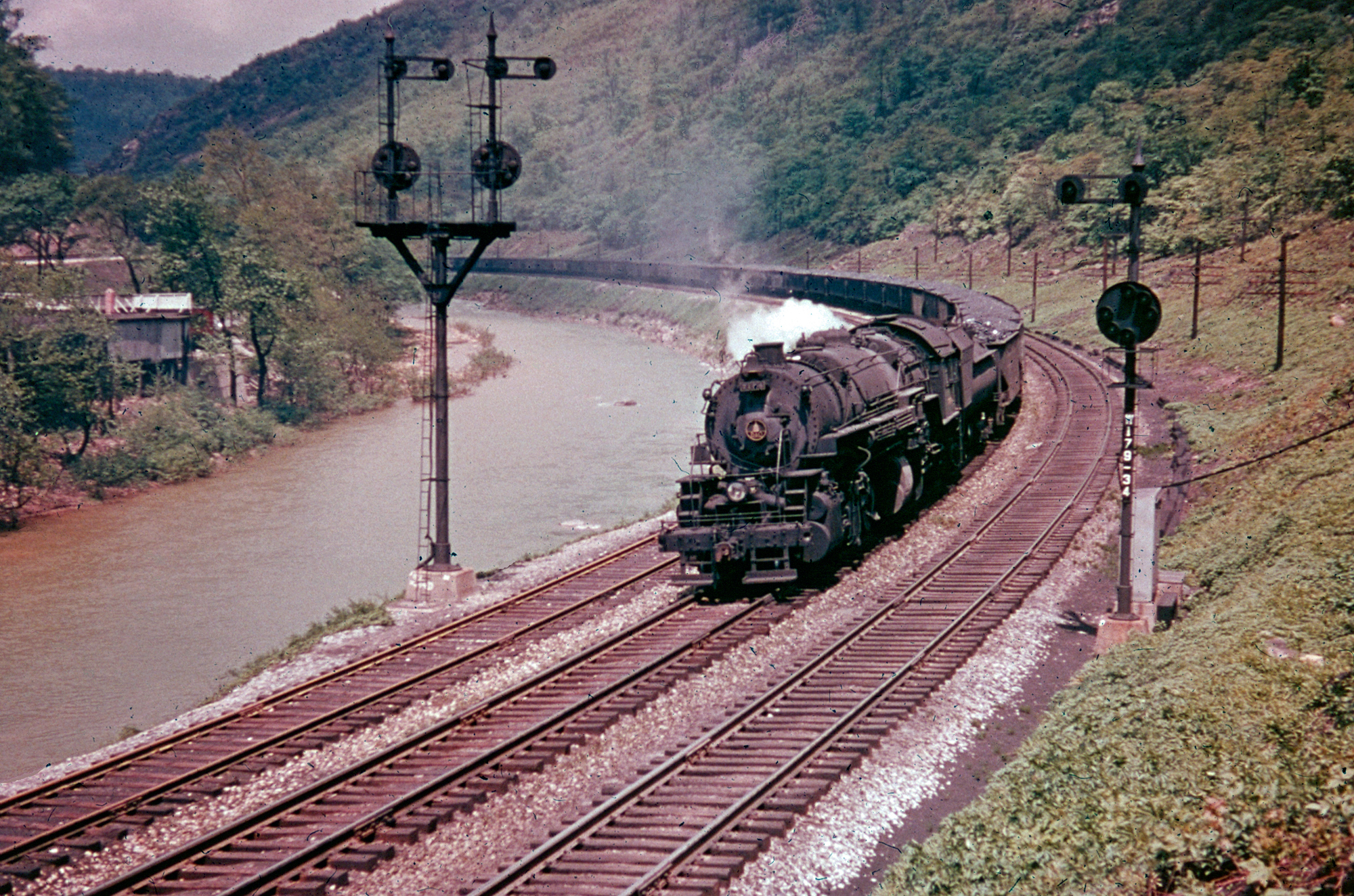 Baltimore & Ohio 2-8-8-0 #7154 leads an eastbound coal drag near Cumberland, Maryland on May 15, 1952. Bob Collins photo. Author's collection.
Baltimore & Ohio 2-8-8-0 #7154 leads an eastbound coal drag near Cumberland, Maryland on May 15, 1952. Bob Collins photo. Author's collection.The Santa Fe was often involved in the development of many now-classic large wheel arrangements, from the 2-10-2 to the 2-10-4, as it sought evermore powerful and efficient locomotives.
The 2-8-8-0 "Consolidation Mallet" was another result of this innovative nature. In 1911 the Santa Fe's own shop forces took a pair of standard 2-8-0s and combined them to form a 2-8-8-0.
The first was given number 3296 and the railroad eventually built four similar engines numberd 3297-3299. However, it was never satisfied with the results and converted them back into 2-8-0s by 1923.
First Examples
In 1916 it acquired its first 2-8-8-0s from Baldwin, and continued receiving new examples from the builder until 1920. Eventually, the manufacturer delivered eighty-six of these engines to the railroad, listed from Class EL-1 through EL-5.
The B&O's 2-8-8-0s were impressive machines. As originally delivered the locomotives weighed more than 462,000 pounds and offered nearly 92,000 pounds of tractive effort with their 58 inch drivers.
Additionally, with a wheelbase of greater than 82 feet, they were then the largest locomotives on the B&O roster. During 1923 the railroad added more to its fleet. In addition, as it aimed to bolster its drag service fleet the railroad had acquired sixteen 2-8-8-2s from the Seaboard Air Line - classified as EE-1 - in 1922.
However, after only a year in service the B&O was displeased with their performance. As a result, Mount Clare shop forces were tasked with removing the rear axle and in the process created another batch of Consolidation Mallets.
After the conversion these locomotives were designated Class EL-6a and numbered 7300-7315. They also boasted the greatest tractive effort of all 2-8-8-0s on the railroad at 121,429 pounds.
Roster
| Model | Builder | Road Number(s) | Date Built | Disposition |
|---|---|---|---|---|
| Class EL-1/a | Baldwin | 7100-7114 | 1916 | Scrapped, 1955 (?) |
| Class EL-2/a | Baldwin | 7200-7214 | 1916 | Scrapped, 1955 (?) |
| Class EL-3/a | Baldwin | 7115-7144 | 1917 | Scrapped, 1955 (?) |
| Class EL-4 | B&O | Former Class LL-1 0-8-8-0s | 1920 | Scrapped, 1955 (?) |
| Class EL-5/a | Baldwin | 7145-7170 | 1919-1920 | Scrapped, 1955 (?) |
| Class EL-6a | B&O | 7300-7315 (Former Class EE-1 2-8-8-2s) | 1922 | Scrapped, 1955 (?) |
Around the same time the B&O added ten more, also thanks to the work done at its Mount Clare Shops. In his authoratitive book, "Steam Locomotives Of The Baltimore & Ohio: An All-Time Roster," author William Edson notes the railroad acquired thirty 0-8-8-0s from Alco's Schenectady Works between March, 1911 and August, 1913.
Listed as Class LL-1 these big engines were originally numbered 2401-2420 and 2422-2431. In 1916 they were renumbered 7020-7049.
Between 1919-1923 it took a third of them - specificaly 7020, 7023, 7026, 7032-7033, 7036, 7038-7040, and 7049 - and rebuilt the locomotives as 2-8-8-0s, listed as Class EL-4. In their new configurations the engines weighed between 472,300-482,500 pounds.
In 1927 the B&O embarked on a rebuild program of the Mallets, changing most from the more complicated compound expansion to simple as mentioned above.
Once out-shopped the EL's designation was appended with an "a" to denote the locomotives' conversion to simple expansion.
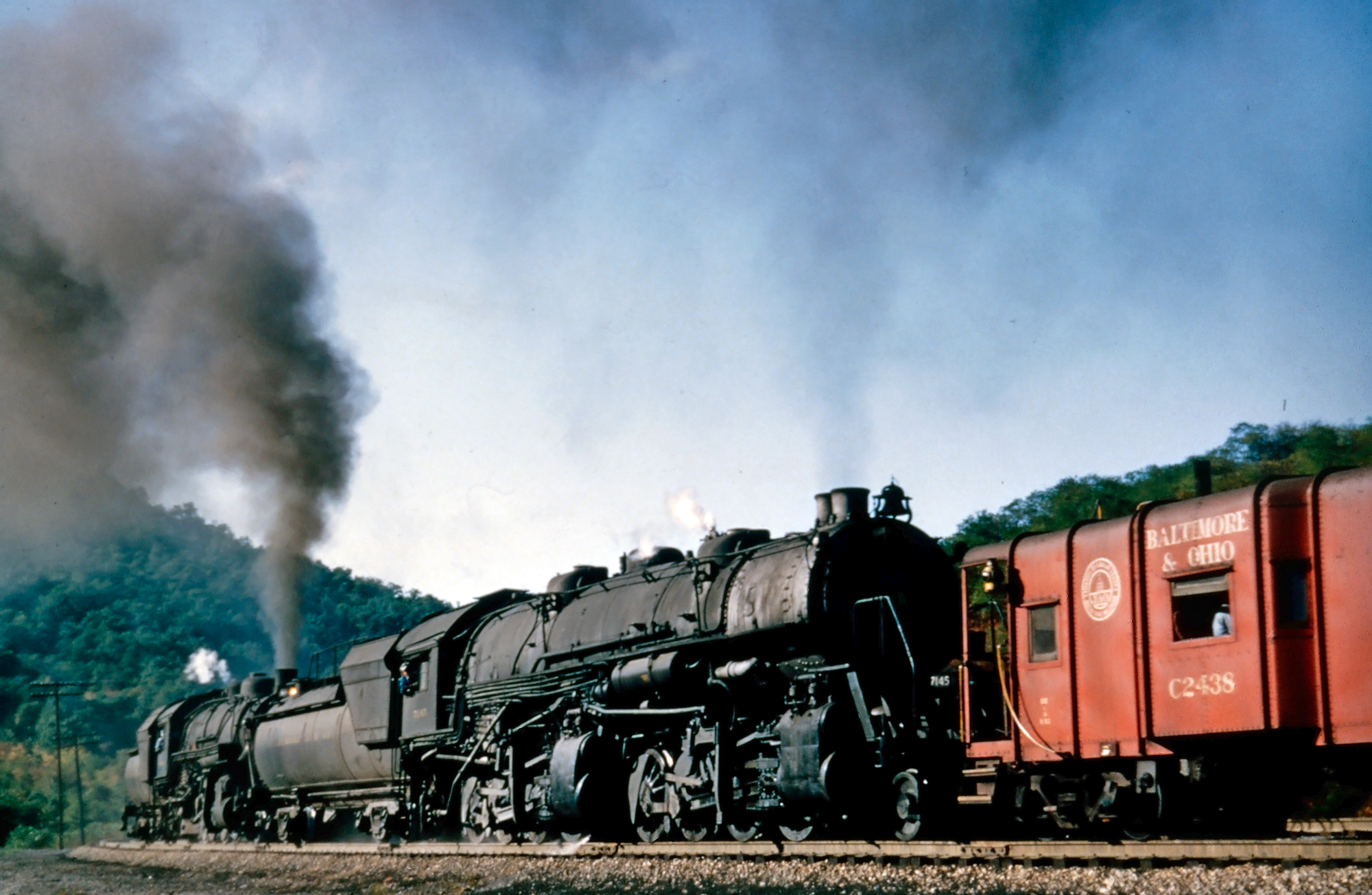 Baltimore & Ohio 2-8-8-0 #7145 (EL-5) and a 2-8-2 work hard in helper service shoving on an eastbound manifest at Sand Patch, circa 1955. Photographer unknown. American-Rails.com collection.
Baltimore & Ohio 2-8-8-0 #7145 (EL-5) and a 2-8-2 work hard in helper service shoving on an eastbound manifest at Sand Patch, circa 1955. Photographer unknown. American-Rails.com collection.All of the B&O's fleet of large, articulated steamers could be found battling the grades somewhere along the West End. Many could still be witnessed in service here well after World War II and into the 1950s, giving railfans of this era a spectacular show.
In David Mainey's book, "Baltimore & Ohio Steam In Color," photographers such as Bob Collins, Emery Gulash, and Don Ball all recorded these behemoths in action (many in color) allowing future generations to see steam from that era.
As the B&O continued acquiring new diesels during the 1950s its steam fleet was slowly retired. The Class EL's remained in service until the mid-1950s. Mr. Edson notes the final example, #7127 (EL-3) was retired in February, 1955. Unfortunately, with the railroad in financial straits at this time none were preserved.
Class EM-1 (2-8-8-4)
While the EM-1s were not the most powerful late era engines they were nevertheless exceptionally built machines and well-liked by train crews.
A symbol of colossal power and impressive engineering the 2-8-8-4s were not only capable of tackling steep grades but were also one of the most aesthetically beautiful large articulated designs.
Ironically, the Baltimore & Ohio had wanted new diesels at the time but was forbade by the War Production Board. As a result, requiring more power to meet wartime traffic demands, the B&O tapped Baldwin for the new locomotives.
Post-World War II, the emergence of diesel engines rendered the steam behemoths like the EM-1 obsolete. Like most late-era designs, the 2-8-8-4's saw less than 20 years of service.
However, this did not erase their influence or importance. Across the B&O network, the EM-1 remained in heavy freight service, hauling coal until the late 1950s, a testament to their reliability and effectiveness.
Sadly, none were preserved. Nevertheless, their legacy continues to articulate the potent capability of an era where steam and steel ruled the railways.
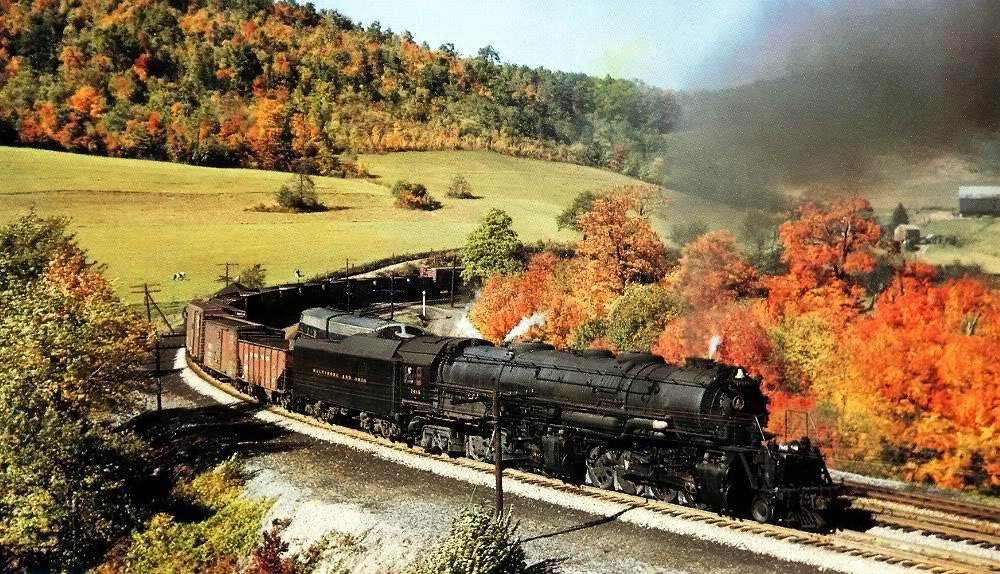 Baltimore & Ohio 2-8-8-4 #7615 (EM-1) works a freight up Sand Patch at Mance, Pennsylvania during a fall afternoon on October 10, 1955. Note the F7 helpers. Author's collection.
Baltimore & Ohio 2-8-8-4 #7615 (EM-1) works a freight up Sand Patch at Mance, Pennsylvania during a fall afternoon on October 10, 1955. Note the F7 helpers. Author's collection.The EM-1 was a variant of the Yellowstone design, originally placed into service on the Northern Pacific in 1928. The NP wanted a powerful locomotive, which could move heavy freights through the Dakotas relatively quickly. Ultimately, only four lines purchased Yellowstones; the B&O, NP, Southern Pacific, and Duluth, Missabe & Iron Range.
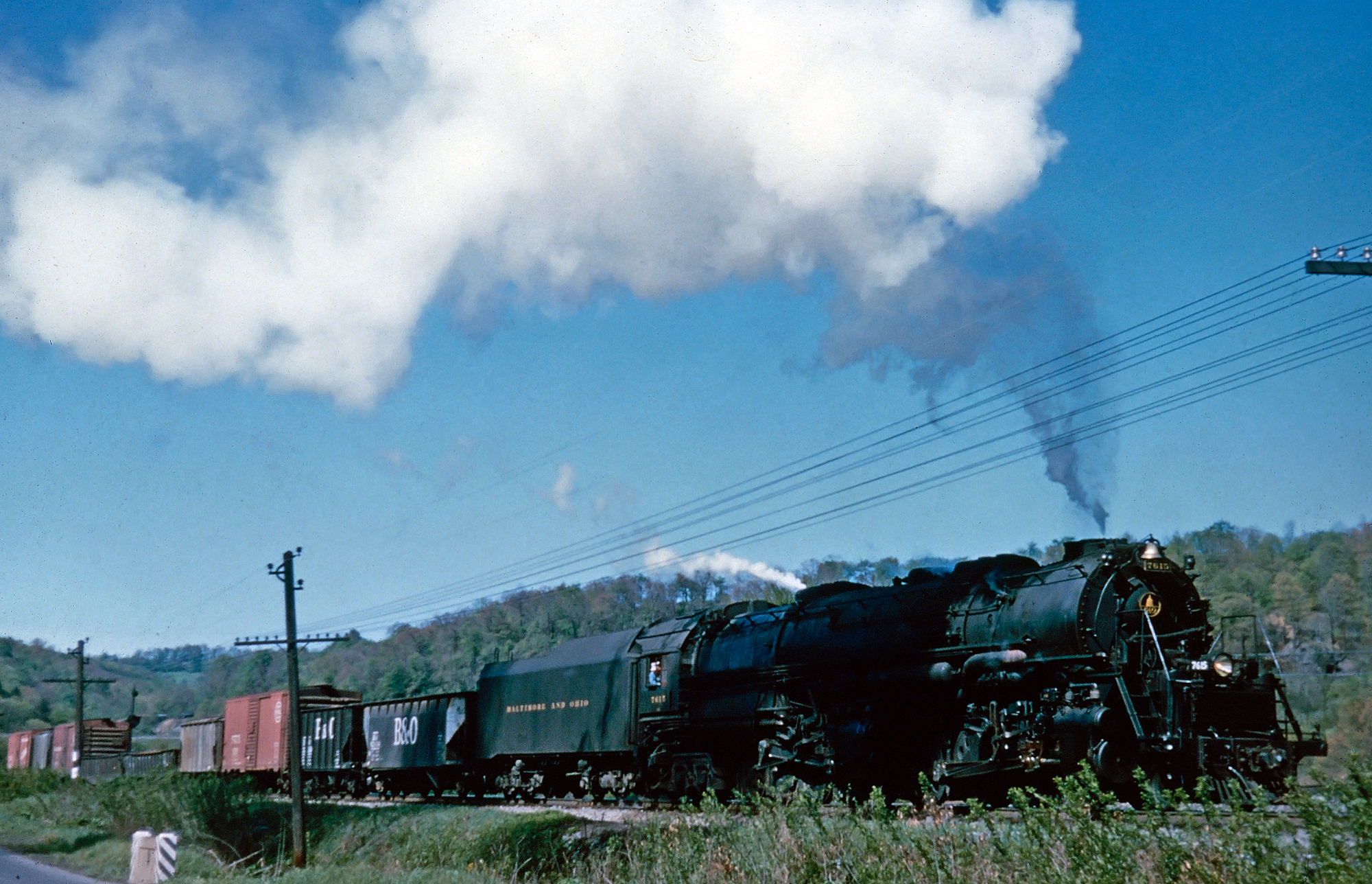 Baltimore & Ohio 2-8-8-4 #7615 (EM-1) leads a general manifest along the East End/Cumberland Division near Hancock, West Virginia, circa 1955. Photographer unknown. American-Rails.com collection.
Baltimore & Ohio 2-8-8-4 #7615 (EM-1) leads a general manifest along the East End/Cumberland Division near Hancock, West Virginia, circa 1955. Photographer unknown. American-Rails.com collection.Development
The EM-1 was developed during the late steam era and, accordingly, would carry the most advanced technology available. Thirty of these locomotives were built for the B&O, all products of the Baldwin Locomotive Works.
The big engines were delivered in two batches, #7600-7619 arrived in 1944 while #7620-7629 were delivered between May and August, 1945.
The eastern trunk line was one of the first to embrace diesel technology purchasing a boxcab switcher from Alco and Ingersoll-Rand in 1924. It was also quick to test Electro-Motive's streamlined EA in 1935 and ultimately went back to EMD for many of its diesel locomotives.
The railroad desperately wished to continue purchasing diesels (then EMC's FT model) to keep up with wartime traffic. However, with WPB restrictions in place the B&O was forced to settle for more steam.
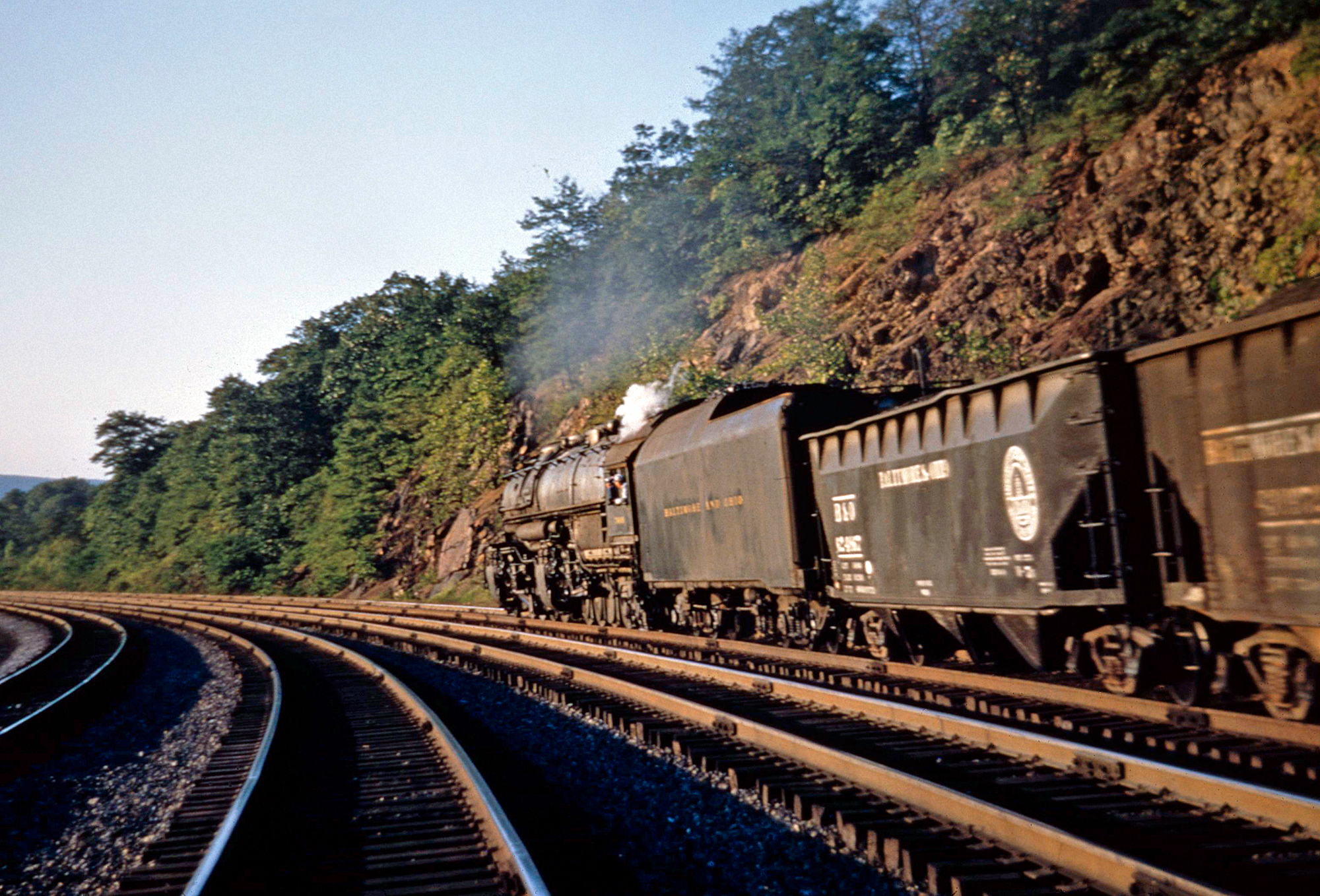 A Baltimore & Ohio EM-1 (2-8-8-4) leads eastbound loads of coal over Magnolia Cutoff at Orleans Road, West Virginia during the early 1950s. Bill Price photo. American-Rails.com collection.
A Baltimore & Ohio EM-1 (2-8-8-4) leads eastbound loads of coal over Magnolia Cutoff at Orleans Road, West Virginia during the early 1950s. Bill Price photo. American-Rails.com collection.In time, however, the railroad became rather fond of its 2-8-8-4s. The EM-1s had a rather low boiler pressure, comparative to other models in its class, which offered a high factor of adhesion (4.22). This high ratio allowed the locomotive to start rather efficiently and it was generally not susceptible to wheel slippage.
This particular characterstic was an added benefit when handling merchandise or coal drags over the steep grades of Cranberry Grade, Seventeen Mile Grade, or Sand Patch in Pennsylvania.
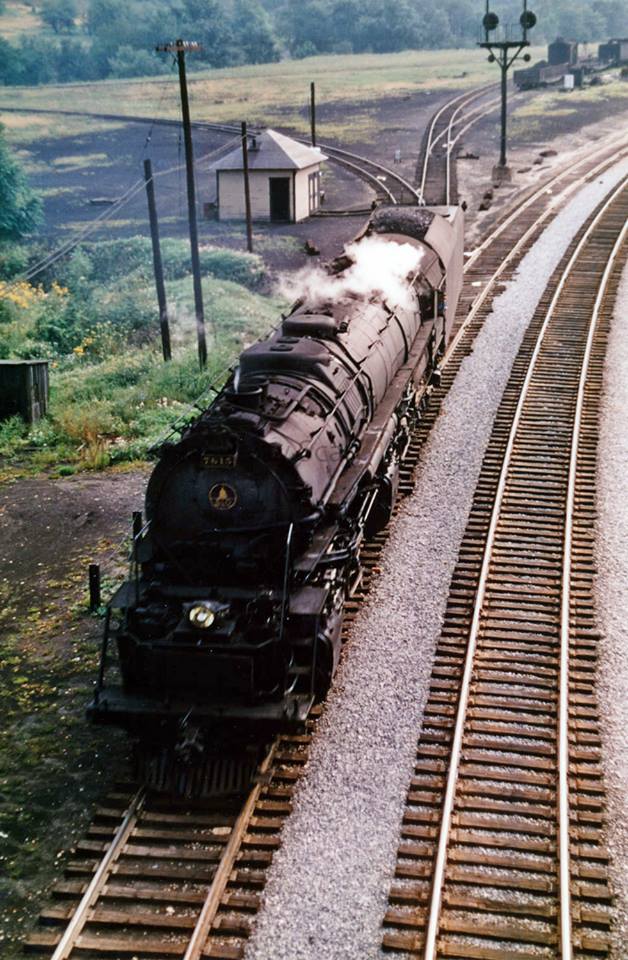 Baltimore & Ohio 2-8-8-4 #7615 (EM-1) is seen here in a rare scene on Sand Patch on August 26, 1954. These behemoths were normally not assigned to this territory. Just a few years later the big steamers were renumbered into the 600 series to make way for newly arriving diesels. Bill Price photo.
Baltimore & Ohio 2-8-8-4 #7615 (EM-1) is seen here in a rare scene on Sand Patch on August 26, 1954. These behemoths were normally not assigned to this territory. Just a few years later the big steamers were renumbered into the 600 series to make way for newly arriving diesels. Bill Price photo.Reception
The EM-1 was a true sight to behold if one was lucky enough to witness it trackside. A classic example is the locomotive working upgrade over Sand Patch. The engine exemplified what made the steam locomotive such an admired and respected machine.
The pure power and deafening sound of the EM-1’s is perhaps something words, pictures and maybe even video can never truly replicate without the fortune of being there in person to witness these phenomenal locomotives in service.
While the locomotive's size is enough in itself, seeing it in person illustrates this point so much more. The below specifications of the locomotive are courtesy of John Patton.
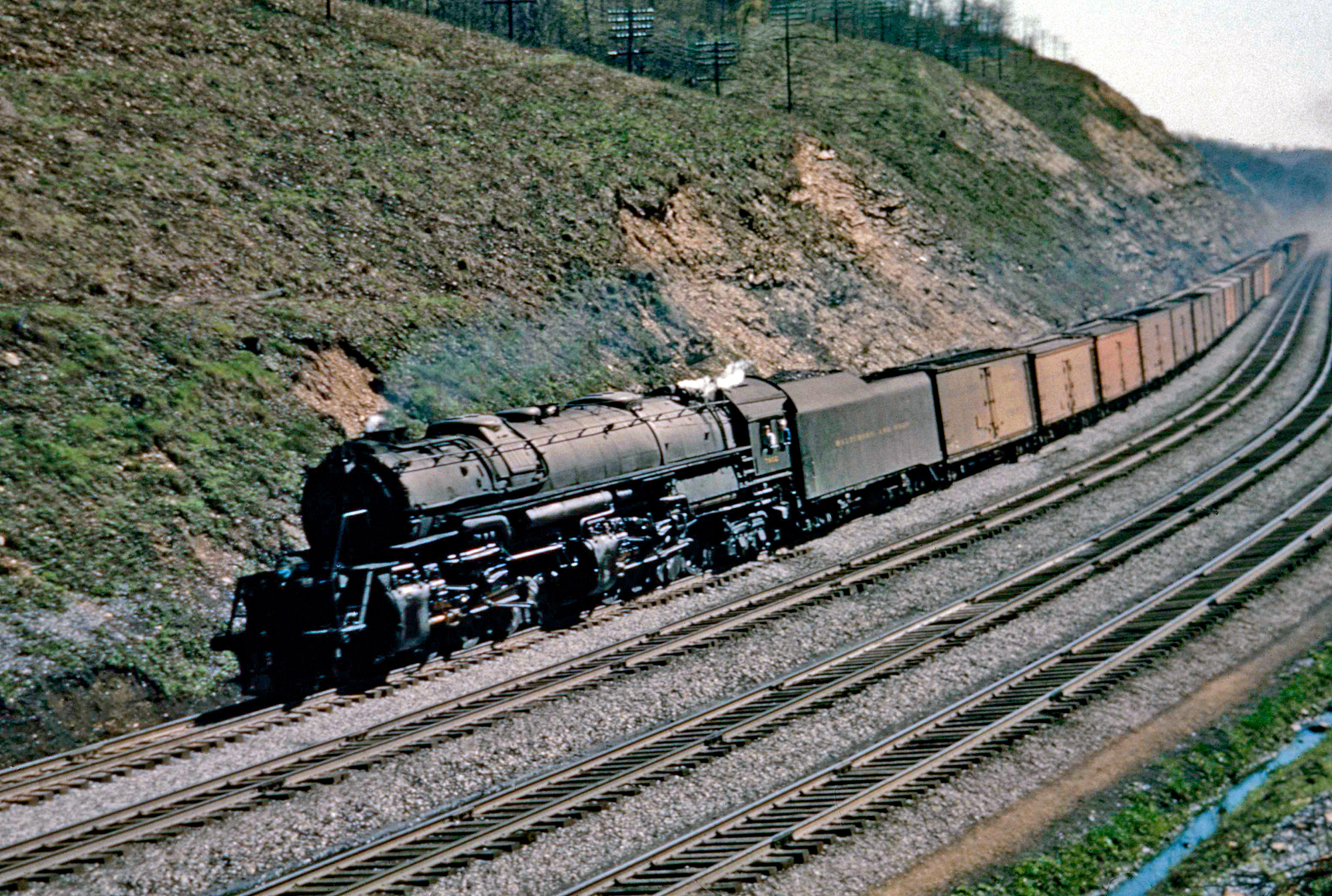 A Baltimore & Ohio EM-1 rolls west downgrade at Doe Gully, West Virginia along the Magnolia Cutoff during the early 1950s. Photographer unknown. American-Rails.com collection.
A Baltimore & Ohio EM-1 rolls west downgrade at Doe Gully, West Virginia along the Magnolia Cutoff during the early 1950s. Photographer unknown. American-Rails.com collection.Specifications
According to John Patton:
"...the EM-1s were said to be easy steamers to operate and crews liked them. With minor stay bolt trouble they were perfect for the B&O in every way possible.
As said upon delivery by head of machinery, they had everything, all wheels had roller bearings and were top of the line for steam on the B&O...these B&O articulateds were 1,010,700 pounds, laden; carried 22,000 gallons of water and 25 tons of coal."
Roster
7600-7629 (1944-1956) 650-679 (Post-1956) |
|
1944 (7600-7619) 5/1945 - 8/1945 (7620-7629) |
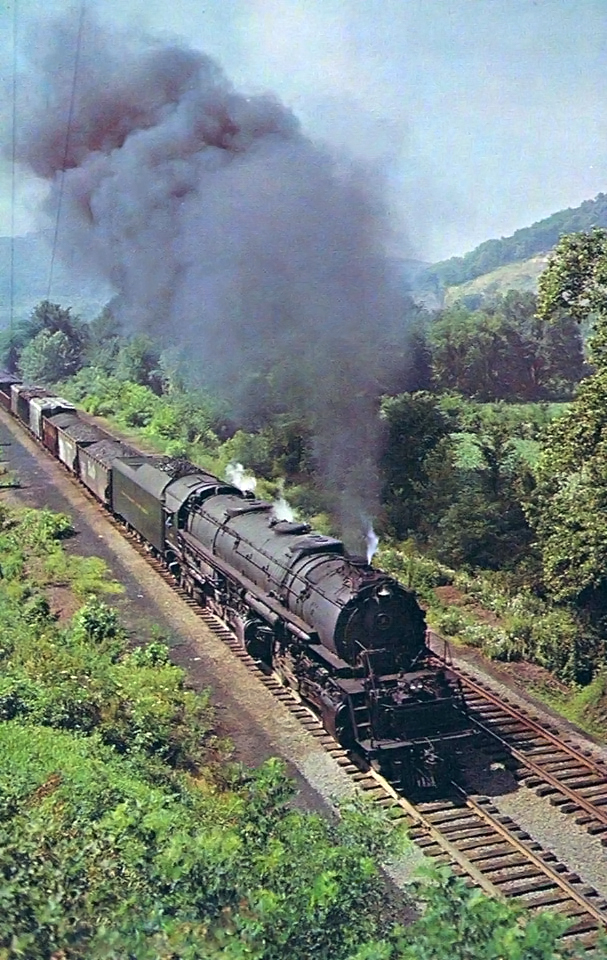 Baltimore & Ohio 2-8-8-4 #657 heads north along the once-busy Wheeling Division near Holloway, Ohio (now abandoned) with a mixed freight (dispatched from Benwood/Wheeling) bound for Lorain in July of 1957. The big EM-1's had recently been renumbered to make room for incoming diesels and they would soon be retired after barely a decade of service... Don Wood photo.
Baltimore & Ohio 2-8-8-4 #657 heads north along the once-busy Wheeling Division near Holloway, Ohio (now abandoned) with a mixed freight (dispatched from Benwood/Wheeling) bound for Lorain in July of 1957. The big EM-1's had recently been renumbered to make room for incoming diesels and they would soon be retired after barely a decade of service... Don Wood photo.Final Years
The EM-1's reign would be short-lived, however. By 1956 the locomotives had been renumbered to a three-digit series, 650-679, tomake room for newly arriving diesels.
As increasingly more examples were delivered for general road service, the EM-1s were shifted further west, from the eastern mountain regions to the Ohio River and Pittsburgh Division.
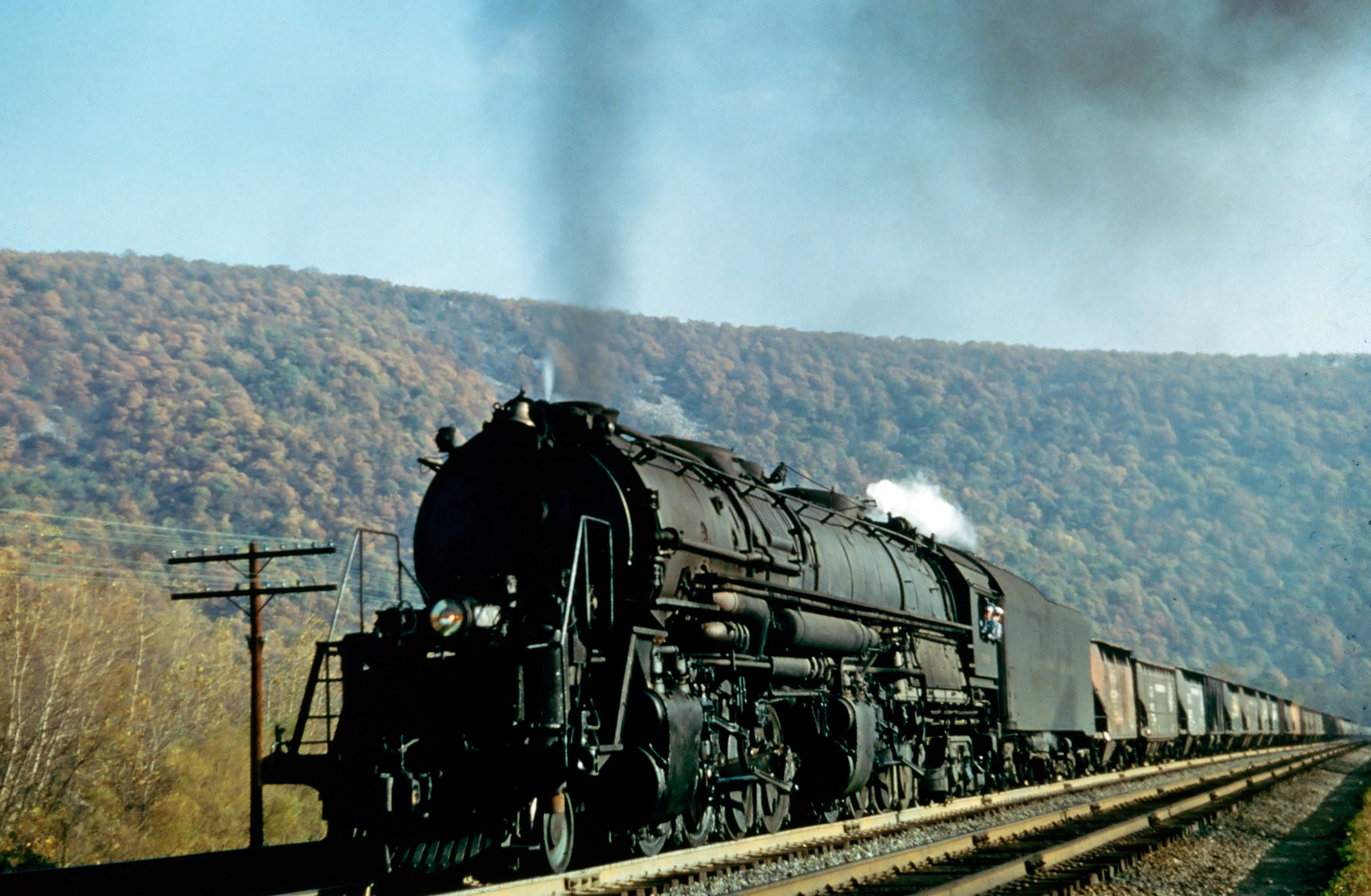 A big Baltimore & Ohio EM-1, #7615, appears to have empties heading west through the Narrows west of Cumberland, Maryland, circa 1955. Photographer unknown. American-Rails.com collection.
A big Baltimore & Ohio EM-1, #7615, appears to have empties heading west through the Narrows west of Cumberland, Maryland, circa 1955. Photographer unknown. American-Rails.com collection.In his authoratitive book, "Steam Locomotives Of The Baltimore & Ohio: An All-Time Roster," author William Edson notes the entire fleet was retired between 1957 and 1960.
However, according to Mr. Patton, "the last one off the roster was to be saved for the B&O Museum in Baltimore, but it never happened due to lack of funding and the museum not being open to try and reserve funding for such." Unfortunately for both railfan and historian alike, not one EM-1 is preserved for future generations to tour and see.
To see the EM-1 in all its glory was, undoubtedly, a spectacle to behold, a symbol of the transformative growth, and tenacity of American railroading.
From hauling coal in times of peace to powering the War effort, the EM-1 exemplified the steely resolve and relentless progress that embodies the spirit of American locomotion history.
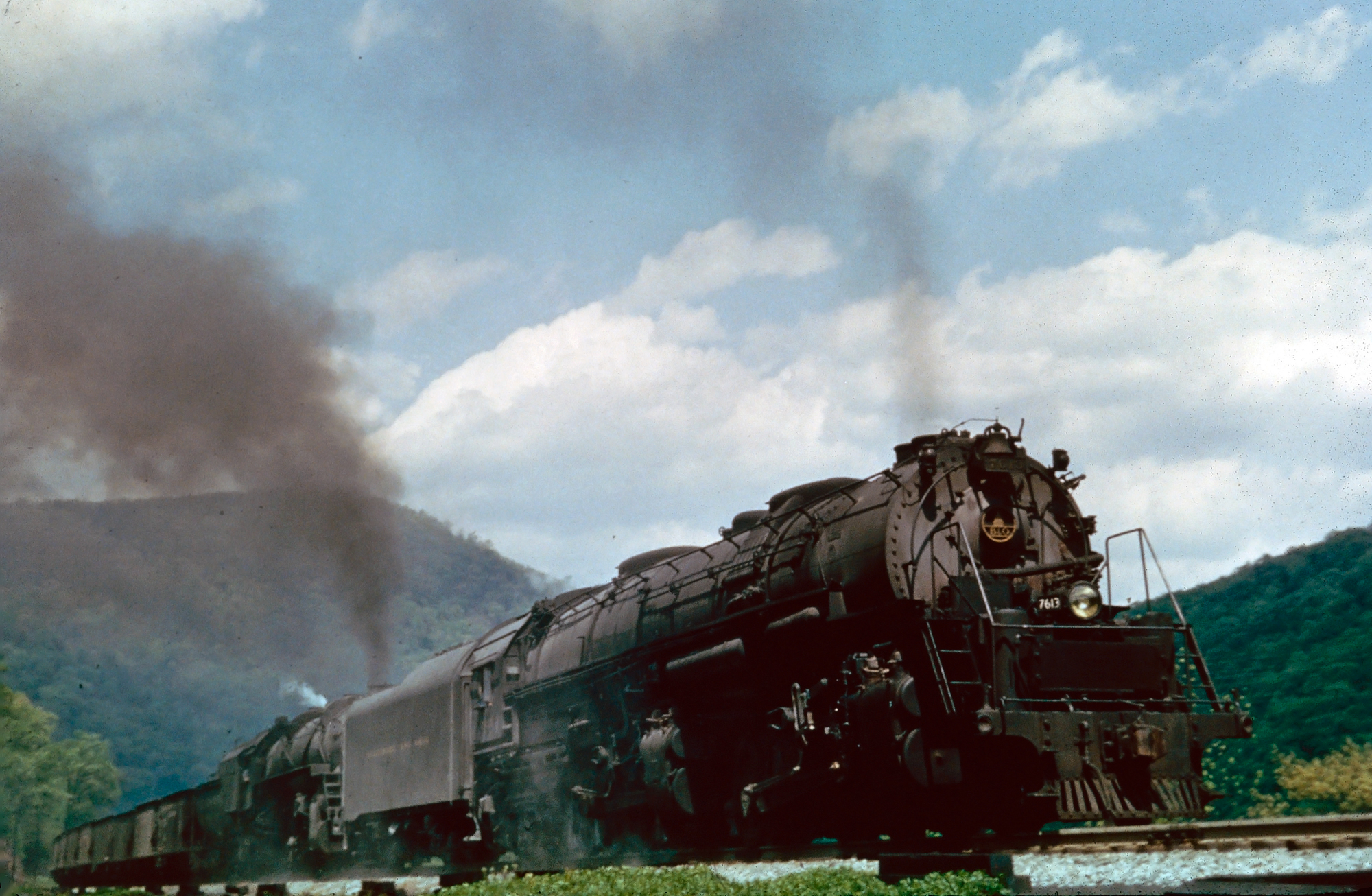 No information was provided on this slide of 2-8-8-4 EM-1 #7613 and what appears to be a "Big Six" in service with a string of coal hoppers, circa 1955. Photographer unknown. American-Rails.com collection.
No information was provided on this slide of 2-8-8-4 EM-1 #7613 and what appears to be a "Big Six" in service with a string of coal hoppers, circa 1955. Photographer unknown. American-Rails.com collection.Class KB-1 (2-6-6-4)
A few classes of the B&O's large steamers were acquired second-hand from other railroads. One in particular, a batch of 2-8-8-2s from the Seaboard Air Line during the early 1920s was never liked, so much so that the B&O converted them into Consolidation Mallets after only a year.
However, the B&O went back to the SAL in the late 1940s purchasing a small fleet of 2-6-6-4s needed due to a power shortage. The steamers were listed as Class KB-1 and crews spoke very highly of them. Interestingly, their time on the B&O was very short.
As new diesels continued arriving during the early 1950s all were retired after only a few years of service. Unfortunately, none of these big articulateds were preserved, as all were scrapped soon after their retirement.
The B&O was a major proponent of large, powerful wheel arrangements to handle heavy coal tonnage in Ohio, northern West Virginia, and western Pennsylvania.
Alas, many mine in these regions have since closed but at the time comprised a high percentage of the B&O's coal traffic. As a result, it rostered big steam like the 2-6-6-4, 2-10-2, 2-8-8-0, 2-8-8-4, and the 2-6-6-2.
The 2-6-6-4 was a late era wheel arrangement developed during the age of "Super Power" steam locomotives, or those designs first employed by the Lima Locomotive Works in the 1920s that featured larger fireboxes and boilers, newer technologies (such as roller bearings), and in general were simply faster and more powerful.
This particular steamer was first put into service on the small Pittsburgh & West Virginia Railroad, which acquired seven (1100-1106) from the Baldwin Locomotive Works in 1934.
The P&WV; operated in western Pennsylvania, northern West Virginia, and eastern Ohio moving heavy freight trains, notably coal, which necessitated the need for such large designs.
Interestingly, the 2-6-6-4 was made most famous on the Norfolk & Western Railway although the design never drew serious interest across much of the industry (the Erie considered but ultimately declined any examples).
Perhaps the 2-6-6-4s should have been referred to as "Norfolks" or "Roanokes" (where they were built in Roanoke, Virginia) due to their success on the N&W. The railroad's legendary shop forces constructed 43 examples between 1936 and 1950 numbered 1200-1242 and listed as Class A.
One could reasonably argue that the Norfolk & Western was a better builder than the notable manufacturers of the day such as Alco, Baldwin, and Lima. The Class A's were a fine machine that could be utilized in either passenger service or as helpers in drag service.
Seaboard Air Line
The only other railroad to put a 2-6-6-4 into service was the Seaboard Air Line. In truth, the N&W; probably gained the inspiration for its Class A's from the SAL. At the time the SAL was seeing its financial situation improve following its bankruptcy in December of 1930.
Management received permission from the railroad's receiver, Legh Powell, Jr. to order a batch of five 2-6-6-4s from Baldwin in 1934 (delivered a year later), which were listed as Class R-1 and numbered 2500-2504.
Unlike the P&WV's examples, the SAL's were designed for fast freight service sporting 69-inch drivers, 82,300 pounds of tractive effort, a boiler pressure of 230 pounds, and were rated to handle 2,700-ton freights along the main line between Richmond, Virginia and Hamlet, North Carolina.
Other features of the locomotives included the type E superheater, Baker valve gear, and Elesco feedwater heaters (#2504, however, used the Worthington Type 5-SA). The Class R-1's were well built locomotives that offered good riding quality and ample power making them a favorite of crews.
As SteamLocomotive.com points out, however, Seaboard management would not allow the 2-6-6-4s to operate at speeds which crews felt they were capable.
If there was a drawback it was their use of friction bearings on all axles instead of the more economical roller bearings used on the Class A's.
Two years after the first batch of five arrived the Seaboard acquired five more from Baldwin in 1937; listed as Class R-2 they were numbered 2505-2509.
Specifications
| Model | Builder | Road Number(s) | Date Built | Disposition |
|---|---|---|---|---|
| Class KB-1 | Baldwin | 7700-7704 | 1935 | Scrapped, 1953 |
| Class KB-1a | Baldwin | 7705-7709 | 1937 | Scrapped, 1953 |
According to Seaboard Air Line Railway: Steam Boats, Locomotives, And History by Richard Prince, the R-2's were slightly different sporting Walschaert valve gear and a change in the locomotives' frame design.
After the arrival of these latest 2-6-6-4s the Seaboard extended their territory to Monroe, North Carolina and northwesterly into Charlotte.
They would also eventually find their way into passenger service speeding trains into Atlanta and as far south as Florida.
B&O Acquisition
Their arrival to the Baltimore & Ohio occurred during July of 1947; the railroad was continuing to experience a power shortage as the result of World War II and the inability to purchase new diesels.
Under B&O ownership the 2-6-6-4s became Class KB-1's #7700-7704 and Class KB-1a's #7705-7709. Just like on the Seaboard, B&O crews liked the locomotives for the same reasons and they did very well at moving fast freights in a timely manner.
Retirement
The big articulateds tended to stay along the eastern fringes of the Cumberland Division according to David Mainey's Baltimore & Ohio Steam In Color, where grades were relatively flat between Brunswick, Maryland and Cumberland save for locations near Harpers Ferry and Martinsburg, West Virginia.
The B&O experienced some minor issues with the locomotives. As noted by SteamLocomotive.com their slip joints tended to leak and were replaced by ball joints.
Additionally, crews noted they had a slipping issue when tackling grades, which was mostly remedied when the air pumps were moved to the front pilot.
As the B&O purchased new diesel through the early 1950s the need for the 2-6-6-4s quickly waned. Unfortunately, this resulted in a very short [new] career for the locomotives as all were retired and scrapped by 1953.
Class KK (2-6-6-2)
Like most large railroads the B&O acquired some of its steam locomotives by purchasing smaller systems.
The largest included a batch of 2-6-6-2s it picked up from the Buffalo, Rochester & Pittsburgh during the early 1930s which was also one of the largest types that railroad ever owned.
These somewhat antiquated and older Prairie Mallets were in service on the BR&P; for less than twenty years (some saw fewer than ten years) of service before the B&O takeover, which continued to operate them in their home region of Pennsylvania and New York until all were retired by the 1950s.
Interestingly, the B&O modified the steamers only slightly under its ownership, predominantly leaving them as built for the BR&P. Today, none survive.
The Buffalo, Rochester & Pittsburgh was medium sized, western Pennsylvania carrier that predominantly handled coal from that region.
While the BR&P also reached Buffalo and Rochester, New York it was acquired by the B&O in the hopes of eventually establishing a direct corridor to New York under President Daniel Willard's administration.
While the B&O used many types of large, articulated steamers it never used the 2-6-6-2 design in great numbers except those it either received from the BR&P or a few it had built for testing purposes. The 2-6-6-2 was one of the earliest articulated steamers to enter service.
Its inspiration came from the B&O's pioneering 0-6-6-0 "Old Maude" of 1904 as the Great Northern slightly improved upon the design and ordered five 2-6-6-2s in 1906 from the Burnham, Williams & Company.
Many from this era, including the GN's were built as Mallets and found perhaps as much success by private logging companies as they did on major railroads with names like Simpson Logging, Clover Valley Lumber, and Saginaw Timber all owning at least one.
Buffalo, Rochester & Pittsburgh
During 1914 the Buffalo, Rochester & Pittsburgh ordered a batch of 2-6-6-2s from the American Locomotive Company.
It intended to use these Mallets in heavy drag service, moving coal trains and other heavy freights over its stiff grades in northern Pennsylvania and western New York. The BR&P was a smaller road that dated to the late 1860s, built to haul coal out of this region.
While the system was never able to reach Pittsburgh via its own rails it did reach Buffalo and Rochester, New York and as far south as Walston, Pennsylvania.
Along with a fleet of 2-8-8-2s, the 2-6-6-2s were the BR&P's largest locomotives; in all it acquired 55 examples between 1914 and 1923, numbered 700-754, and listed simply as Class LL.
According to David Mainey's book Baltimore & Ohio Steam In Color the Mallets were an older design (compound steam was losing its appeal by the World War I era and into the 1920s) and had remained virtually unchanged over during its ten year production run featuring large, bulbous low-pressure cylinders and old-style slide valves.
Modifications
Most railroads, especially when purchasing a wheel arrangement over such a long time period, had additions or improvements incorporated into them.
However, in this case the BR&P's the 2-6-6-2s were practically the same aside from subtle differences including weight variations and the batch of fifteen (under the B&O these were listed as Class KK-4c) that used Southern valve gear.
In 1932 the Baltimore & Ohio acquired the railroad giving it access to the region's coal fields as well as Buffalo/Rochester.
After the takeover the B&O reclassified the 2-6-6-2s as KK-4a through KK-4d, numbering them 7500-7554. Mr. Mainey's book goes on to state that under B&O's ownership little changed on the locomotives except for their new designation.
There was only one that saw any significant upgrades, #7518. In 1949 the B&O overhauled the steamer with new low and high pressure cylinders using piston valve gears, a cast frame, chassis lubrication, and slightly larger drivers (as built they featured 57-inch drivers).
Specifications
| Model | Builder | Road Number(s) | Date Built | Disposition |
|---|---|---|---|---|
| Class KK-1 | Baldwin | 7400 | 1930 | Retired, 1953 |
| Class KK-2 | Baldwin | 7450 | 1930 | Retired, 1953 |
| Class KK-4 | Alco-Schenectady | 7500-7504 | 1914 | Retired, 1953 |
| Class KK-4a | Alco-Brooks | 7505-7509 | 1917 | Retired, 1953 |
| Class KK-4b | Alco-Brooks | 7510-7525 | 1918 | Retired, 1953 |
| Class KK-4c | Alco-Brooks | 7526-7540 | 1918 | Retired, 1953 |
| Class KK-4d | Alco-Brooks | 7541-7554 | 1923 | Retired, 1953 |
| Class KK-5 | B&O | 7518 | 1949 | Retired, 1953 |
These changes along with some slight cosmetic improvements (such as the removal of the air tank atop the boiler and the addition of air pumps on the pilot deck) allowed #7518 to stand out among its other peers.
From a visual standpoint it was certainly a more appealing locomotive than the others. Interestingly, the Class KK-4's were one of the B&O's only large, articulated designs that did not see action on the West End.
After the BR&P takeover the railroad left them in their home territory along the Buffalo Division where they spent their days continuing to work heavy freights over the notorious grades in this region.
Mr. Mainey's book provides a nice selection of color photos depicting the 2-6-6-2s in action there such as at Bradford, Pennsylvania and scenes of the engine terminal in East Salamanca, New York.
Retirement
Somewhat unknown within the fleet were two additional examples, Class KK-1 #7400 and Class KK-2 #7450. Manufactured much later than the former BR&P units they were built by the Baldwin Locomotive Works in 1930.
According to SteamLocomotive.com their purpose was "...to compare the Emerson watertube firebox to a conventional locomotive." They were somewhat larger and more powerful, sporting additional tractive effort and bigger drivers.
Both remained in service until the early 1950s when they were finally retired. Incredibly, despite their use of compound steam and antiquated design the B&O kept most of the Class KK-4's in service, also until the early 1950s. Unfortunately, no examples were preserved.
Class KL-1 (2-6-8-0)
The B&O is widely regarded for its rugged, efficient, and often aesthetically pleasing steam locomotives. While the railroad would regularly experiment with standard designs in an effort to improve performance it normally did not test unique wheel arrangements.
However, it did experiment with an odd 2-6-8-0 Mallet during the early 20th century. The B&O was always looking for more tractive effort and horsepower thanks to the steep grades of its West End in Maryland, West Virginia, and western Pennsylvania.
The locomotive was sort of an elongated Consolidation but in the end it didn't meet the railroad's expectations and the trials were ultimately canceled before 1920 resulting in the one and only example being converted back to a rigid design.
Of all the large designs the B&O employed across its system, the 2-6-8-0 was the most unique with its odd, off-set wheel arrangement. Interestingly, it was not exclusive to the railroad; the Great Northern, Alabama Great Southern/Southern Railway, and Erie all tested the arrangement.
The B&O was quick to embrace the newest and latest steam technology, particularly from the late 19th century onward. Even prior to that time the railroad was constantly looking for a better locomotive in freight service, first using 0-8-0 "Camels" and then later the trusty 2-8-0 Consolidation.
In 1904 it put the first ever articulated Mallet in service, a new type of steam power that offered far more tractive effort than any previous rigid-frame design then in service.
Manufactured by Alco's Schenectady works it was listed as Class DD-1 and numbered 2400 sporting a 0-6-6-0 wheel arrangement. While the locomotive looked quite small in comparison to later articulated models it provided a great dela of tractive effort that exceeded 66,000 pounds, more than 20,000 pounds more than most of its 2-8-0s.
The #2400 proved to be quite a success and remained on the B&O's roster until 1938 where it worked its final years as the eastbound hump engine at Willard, Ohio. The railroad's next Mallet proved to be one of the oddest designs it ever put into service. The B&O's standard freight locomotive at the time was the Consolidation and it owned hundreds either built or acquired from predecessor roads.
Concept
Using the 2-8-0 arrangement it had an experimental 2-6-8-0 manufactured by Baldwin in 1911, listed as Class KL-1 and given number 2421. According to Kirk Reynold's and Dave Oroszi's book, "Baltimore & Ohio Railroad," the locomotive used one of its Class E-24 2-8-0s and lengthened the boiler, extending the wheelbase by roughly twenty feet.
The Class KL-1 proved to be a powerful locomotive offering nearly the same level of tractive effort (upwards of 60,000 pounds) as the original Class DD-1. Unfortunately, the B&O experienced the same problems with the 2-6-8-0 that other railroads dealt with, slipping and uneven traction.
After just five years of service on the mountainous grades of the West End shop forces converted the locomotive back into a standard 2-8-0. Interestingly, the railroad ordered a batch of 0-8-8-0 Class O-1's (later reclassified as LL-1) the same year it began tests on the 2-6-8-0.
These Mallets, essentially a larger version of the earlier 0-6-6-0, were another Alco product and the B&O were pleased enough to order thirty (7020-7049) through 1913.
Specifications
| Model | Builder | Road Number | Date Built | Tractive Effort | Driver Diameter | Boiler Pressure |
|---|---|---|---|---|---|---|
| KL-1 | Baldwin | 2421 | 1911 | 59,447 Pounds | 56 Inches | 205 PSI |
Other Articulated B&O Steamers
As the years passed the railroad began operating larger and more powerful articulated steamers such as the 1916 Class EL 2-8-8-0 Consolidation Mallets from Baldwin. Another successful design the B&O continued using some in heavy drag service until the end of steam operations during the 1950s.
Other large wheel arrangements to see work on the railroad included the 2-8-8-2s, 2-6-6-4s, 2-6-6-2s, and the famous Class EM-1 2-8-8-4 Yellowstones. However, not all of these locomotives were purchased or built new by the B&O, most notable of which was the 2-6-6-4s and 2-8-8-2s acquired secondhand from the Seaboard Air Line to fill a power shortage.
Additionally, these late-era "Super Power" steamers were simple designs as the B&O would move away from the compound Mallet by the 1920s.
The railroad's rigid-frame wheel arrangements are still widely remembered for their power and service quality. For instance, some of its 2-8-0s were very powerful locomotives capable of producing more than 50,000 pounds of tractive effort and its 2-10-2 "Big Sixes" are regarded as the finest Santa Fes ever built.
In later years the B&O tested out the first 4-4-4-4 Duplex Drive in 1938 one of only two railroads to ever to so, the Pennsylvania being the other. Through the end of the steam era the B&O continued to search for a more practical, efficient, and powerful locomotive of which the Duplex was an example.
Interestingly, though, it was never necessarily dedicated to steam power and was one of the first roads to employ the new diesel in road service. Alas, for all of the B&O's ingenuity within its steam program few examples of its fleet survive today (i.e., no EM-1s or "Big Sixes" to name a few).
Class LL-1 (0-8-8-0)
The B&O was the first railroad to put an articulated Mallet into service with its 0-6-6-0 "Old Maude" numbered 2400.
The locomotive was employed along the West End in Pennsylvania where it pulled heavy drag freights and proved quite adept in this capacity thanks to its high tractive effort.
The B&O, building from the success of the design, ordered a batch of slightly larger locomotives from the American Locomotive Company (Alco) about a decade later; they carried an 0-8-8-0 wheel arrangement and were listed as Class LL-1.
These too found work on the West End and some remarkably remained in service until the 1950s. In later years the B&O mostly abandoned the articulated compounds for simple designs like the 2-8-8-4 Yellowstone and 2-6-6-4.
The 0-8-8-0 was, in its own away, a pioneering design alongside the 0-6-6-0. Railroads recognized the potential of these wheel arrangements, which were essentially two engines under a single frame.
They reduced operating costs through their ability to handle more tonnage. Future designs widely used included the 2-8-8-2, 2-6-6-2, 2-8-8-0, 2-6-6-4, 4-6-6-4, 4-8-8-4, and others.
The legend of the B&O's steam program endears even today and its easy to understand why when seeing the types of locomotives it put into service.
From a utilitarian standpoint these machines got the job done; they were powerful, rugged, efficient and some of the most well-built locomotives of their design (the 2-10-2 "Big Sixes" come to mind).
However, outwardly, even someone unfamiliar with railroads could appreciate the elegance of many Baltimore & Ohio steam locomotives; they offered a simple, uncluttered look with clean lines and a symmetrical appearance (i.e., centered headlights and emblems on the smokebox, evenly spaced axles, etc.).
If one was an astute follower of the B&O it was normally easy to pick out those steamers acquired from other roads, many of which not carry such grace.
0-6-6-0 "Old Maude"
After the railroad completed successful tests of the original 0-6-6-0, nicknamed "Old Maude," it set out to find another Mallet to work the grades of Maryland, Pennsylvania, and West Virginia. Its first attempt was the odd 2-6-8-0 of 1911 based from a standard 2-8-0 Consolidation.
This locomotive ultimately proved troublesome and a relative failure after just a few years of service. However, that same year it placed an order for a larger, more powerful version of the "Old Maude."
This latest design was also manufactured by Alco and carried an 0-8-8-0 wheel arrangement. They were originally listed as Class O-1 although later amended to LL-1. The new Mallets began arriving on the B&O's property in 1911 and all thirty had been delivered by 1913.
Operation
At the time the 0-8-8-0s were the most powerful locomotives on the B&O's roster capable of producing more than 98,000 pounds of tractive effort sporting 56 inch main drivers.
The Mallets carried an overall wheelbase of just over 77 feet, much longer than the "Old Maude," and weighed roughly 334 tons (also eclipsing the 0-6-6-0). According to SteamLocomotive.com the engines were originally fitted with Walschaert valve gear feeding the low-pressure cylinders but these were later replaced with Baker valves.
In service it is said the LL-1's were "slow and complicated." However, apparently the B&O liked the compounds well enough to continue operating a few in helper and drag service through at least mid 1948.
Specifications
| Model | Builder | Road Number | Date Built | Tractive Effort | Driver Diameter | Boiler Pressure |
|---|---|---|---|---|---|---|
| O-1/LL-1 | Alco | 7020-7049 | 1911-1913 | 98,352 Pounds | 56 Inches | 210 PSI |
This is interesting for a few reasons; first, by that time the railroad was already working to retire its remaining steam fleet and second, it had many other, more advanced articulated designs on its roster (such as the 2-8-8-4, 2-8-8-0, 2-8-8-2, and 2-10-2 among others).
Retirement
Exactly how long the 0-8-8-0s remained active on the B&O is not entirely certain to this author. However, based on the fact that many of its wheel arrangements, both articulated and rigid designs, continued to work freights through the early 1950s it is quite likely that at least one example of an LL-1 remained in service through that time as well (though it is almost certain that none survived the B&O's 1956 renumbering program, which made room for newly arriving diesels).
Throughout the history of its steam program the B&O found four main driving axles (or sets) very much to its liking. This isn't terribly surprising considering the steep grades it dealt with in the east and the tractive effort needed to move heavy trains over those mountains. However, it is nevertheless interesting.
One of its first primary freight locomotive designs was the 0-8-0 "Camel" followed by the Consolidation of the late 19th century. The 2-8-0 became standard power until the first 2-8-2s and Mallets began arriving during the first decade of the 20th century.
During the remainder of the steam era four axles, or larger, dominated freight service on the B&O (most of which have already been mentioned above).
The railroad even employed the powerful 4-8-2 Mountain in passenger service beginning in the 1920s. Unfortunately, no examples of the Class LL-1's were preserved.
Class N-1 (4-4-4-4)
The duplex drive steam locomotive was originally conceived by the Baltimore & Ohio in the 1930s as a more advanced concept over the standard designs of the day by gaining more power and speed through the use of two sets of driving wheels under a rigid frame.
The B&O's only example was listed as Class N-1 and given #5600; it was also named after the engineer which came up with the idea, the railroad's General Superintendent of Motive Power & Equipment, George H. Emerson.
As an experimental the B&O ran into the usual troubleshooting issues one might expect with a such a new and unproven locomotive.
With the onset of the diesel age the railroad grew disinterested in refining its duplex locomotive and after sitting in storage for many years the #5600 was scrapped after World War II.
The Pennsylvania Railroad picked up on B&O's concept a few years later and resolved some of its rival's issues by lengthening the wheel-base.
However, the PRR continued to have its own problems with the design. Before these could be ironed out the concept was dropped in favor of the diesel locomotive.
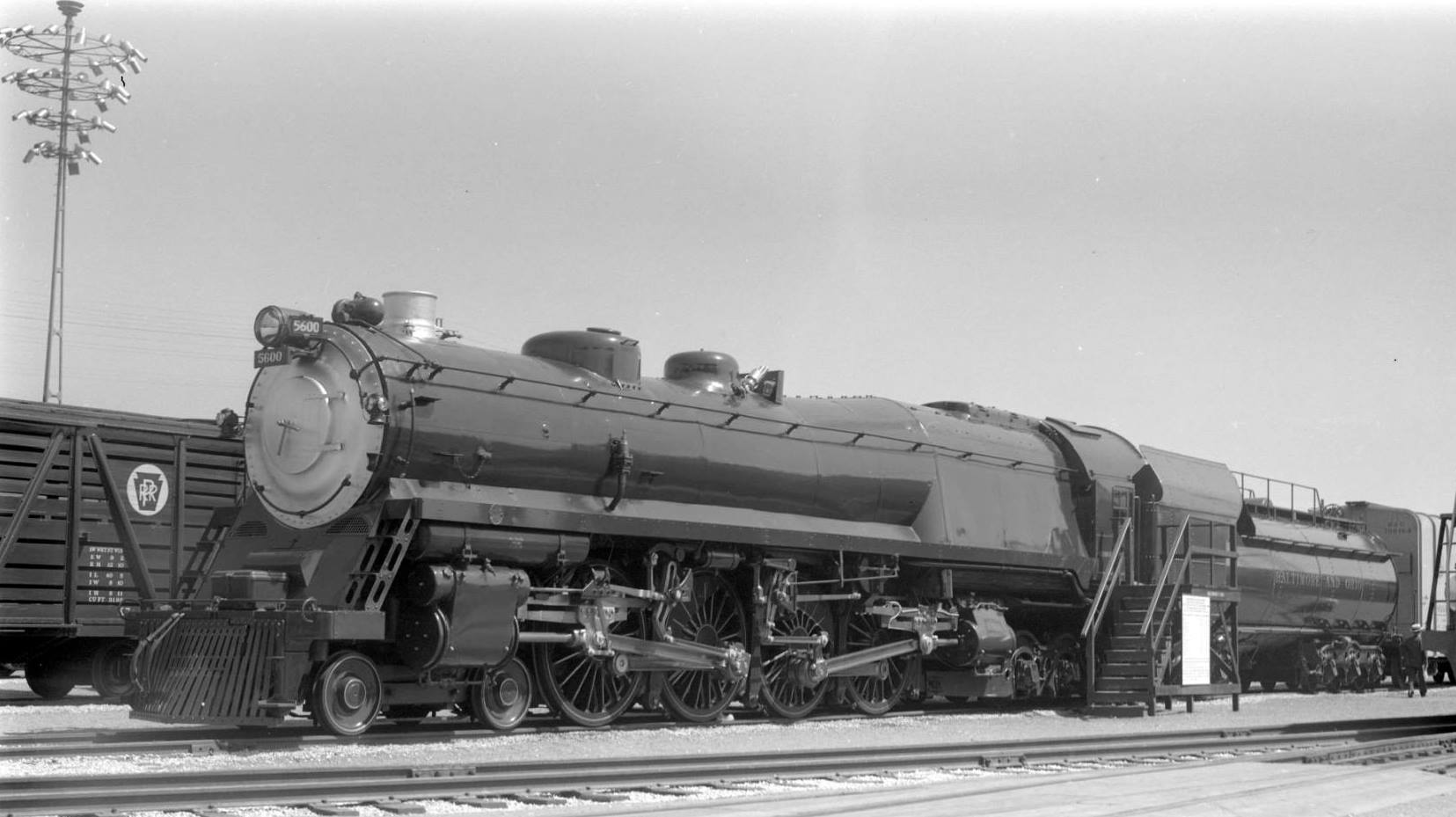 The Baltimore & Ohio pioneered "Duplex Drive" technology, constructing 4-4-4-4 #5600 in 1937-1938. It is seen here on display at the New York World's Fair on August 5, 1939. Otto Perry photo.
The Baltimore & Ohio pioneered "Duplex Drive" technology, constructing 4-4-4-4 #5600 in 1937-1938. It is seen here on display at the New York World's Fair on August 5, 1939. Otto Perry photo.The Baltimore & Ohio was a railroad always either at the forefront of the latest steam technology or constantly improving its locomotives; it put the first articulated Mallet into service in 1904 (0-6-6-0 Class DD-1 #2400 named "Old Maude") and developed the first duplex drive during June of 1937.
The idea behind the concept was to further advance steam technology, perhaps as the next generation to enter service. At this time the diesel was only starting to be accepted by the industry as a reliable form of motive power.
However, it remained limited primarily to switching and secondary roles as road power like the American Locomotive Company's RS1 (the first road-switcher) and Electro-Motive's revolutionary FT cab model were still a few years away.
The B&O constructed the duplex drive at its Mt. Clare Shops in Baltimore, which was well known for its ability to turn not only innovated locomotives but also classic designs like their beautiful Class P 4-6-2 Pacifics and Class T 4-8-2 Mountains.
Conception
The railroad's aforementioned chief of motive power, George Emerson, who is credited with many of the company's successful applications of steam during the 20th century, came up with the design.
The locomotive carried a 4-4-4-4 wheel arrangement (in a standard design using a primary rod and a single set of cylinders it would have been a 4-8-4 "Northern" type), numbered 5600, and was given Class N-1; it was also named the George H. Emerson for his many contributions to the company since the 1920s.
Specifications
Sources:
- Edson, William. "Steam Locomotives Of The Baltimore & Ohio: An All-Time Roster." Potomac, Maryland: McClain, 1992.
As David Mainey notes in his book Baltimore & Ohio Steam In Color, #5600 was clad in semi-streamlining and looked similar to an English-built machine. The basic premise behind the concept was to develop a more powerful, rigid-framed locomotive that used two sets of powered drivers instead of one.
Design
It would also, in theory, reduce maintenance since it used lighter and smaller main rods (four in all). Unlike the Pennsylvania Railroad, which advanced the design further than any other company and is most often associated with the duplex drive, the B&O's approach was a bit different by locating the back set of cylinders (nearest the cab and under the firebox) behind the rear drivers.
This setup turned out to be one of the locomotive's glaring issues, among others. By placing the cylinders under the firebox they had a tendency to overheat as well as collect dirt and dust.
Emerson equipped the #5600 with his self-designed, water-tube firebox, which he had been testing since 1930 on Class T-1 4-8-2 #5510. The idea behind this special firebox was that it held a greater heating surface to the surrounding fire.
According to SteamLocomotive.com regarding #5510 the water-tube firebox offered an 82% increase of the surface area (from 474 square feet to 866 square feet), "...including the 83 square feet of arch tubes."
Other features of the #5600 included its high 350 pounds of boiler pressure, 76-inch main drivers, Walschaerts valve gear, and 18 x 26 1/2-inch cylinders (according to Mainey's book all four were integrally cast, the first of their kind). Additionally, the locomotive weighed 391,550 pounds (nearly 196 tons) and offered 65,000 pounds of tractive effort.
Purpose
The B&O intended its 4-4-4-4 to be used in passenger service where it was employed through the early 1940s (during the 1939 New York World's Fair the George H. Emerson was put on display to the amazement of visitors).
Unfortunately, numerous issues and the advancement of the diesel doomed the locomotive. The Emerson firebox proved problematic with vibration issues and it was not sufficiently insulated; in general it never offered significant advantages over a standard firebox.
Additionally, the locomotive experienced problems related to its bearings that constantly kept it sidelined. Perhaps in time the B&O could have ironed out many of these setbacks but interest in steam was waning as diesels proved they were capable main line power.
Retirement
When she was first conceived, the George H. Emerson held much promise.
Aside from the intended advantages already mentioned its smaller and lighter main rods meant fewer counterbalance weights were needed and a short wheel base would have allowed it to operate all across the B&O's vast system.
In service the #5600 was given mixed reviews by the crews that operated her; in general the locomotive offered a good ride but had a tendency to slip and would not always stop precisely.
As problems mounted with #5600 it mostly sat in storage from the early 1940s until 1950 when it was finally scrapped in October, 1950. Perhaps most unfortunate is that the B&O did not preserve this unique locomotive since it was an experimental and the railroad often sent such interesting creations to its museum in Baltimore.
Class P (4-6-2)
Like many railroads the B&O used the 4-6-2 "Pacific" steam locomotive as primary passenger power from the early 20th century until all were retired in favor of diesels by the mid-1950s.
The B&O owned a myriad of Pacifics built by either the American Locomotive Company (Alco) or the Baldwin Locomotive Works while the railroad itself built a few of its own from scratch.
Additionally, shop forces oversaw numerous modifications of the 4-6-2s over the years resulting in a dizzying array of sub-classes.
In general, the B&O's Pacifics are widely regarded as some of the most handsome ever built, notably its "President" Class P-7's. During their final years of service some were relegated to freight or helper service and of the more than 200 manufactured, today just one survives.
B&O's 4-6-2s could be found in all types of service, not only on top trains like the Capitol Limited. As in the below photo, the locomotives were assigned everywhere, even secondary and branch runs.
The railroad's most famous were a group of four streamlined for the striking Cincinnatian in the 1940s. The B&O largely elected against using power larger than 4-8-2's for passenger service; instead, it began acquiring diesels as soon as production models were available in the late 1930's.
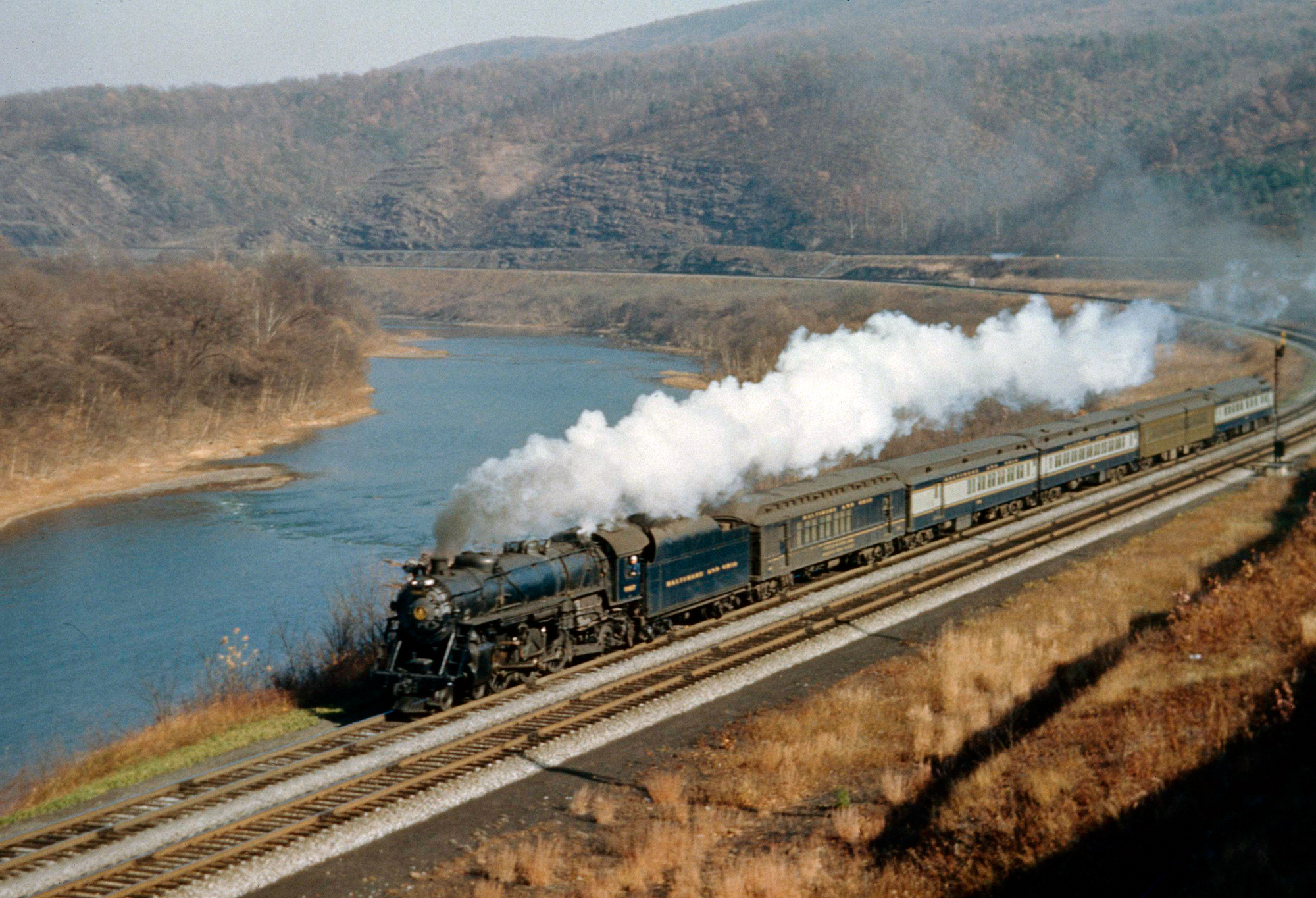 One of the Baltimore & Ohio's handsome P-7's (4-6-2), #5307, steams westbound with train #21 on the East End at rural Hansrote, West Virginia during a late fall afternoon in the 1950's. The railroad followed the Potomac River closely along the Cumberland Division. Bill Price photo. American-Rails.com collection.
One of the Baltimore & Ohio's handsome P-7's (4-6-2), #5307, steams westbound with train #21 on the East End at rural Hansrote, West Virginia during a late fall afternoon in the 1950's. The railroad followed the Potomac River closely along the Cumberland Division. Bill Price photo. American-Rails.com collection.As one of the major eastern trunk lines behind only the Pennsylvania and New York Central the B&O had a very large passenger market (stretching from New York City to Chicago and St. Louis) to cover.
Prior to the development of the first, true Pacific which entered service on the Chesapeake & Ohio in 1902 the B&O relied on a series of smaller wheel arrangements from the all-around 2-8-0 Consolidation and 4-6-0 Ten-wheeler to the fast and agile 4-4-2 Atlantic.
The 4-6-2 combined the speed of the Atlantic and the power of the Ten-wheeler becoming the most successful passenger steam locomotive ever built with more than 6,800 manufactured. The B&O recognized its advantages early and ordered its first batch of 35 from Alco in 1906.
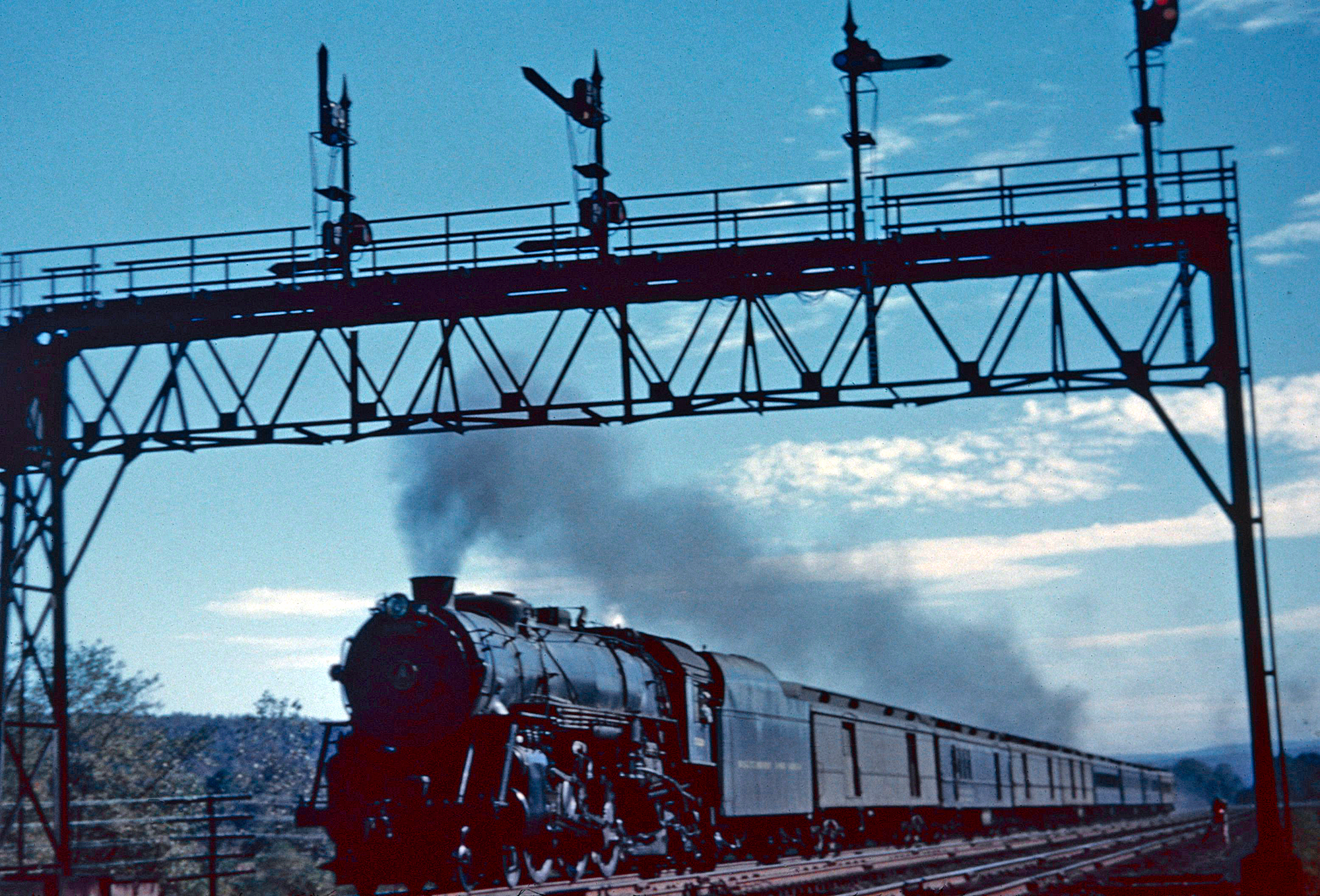 One of the Baltimore & Ohio's handsome 4-6-2's hustles a passenger train, heavy with mail/express on the head-end, under the signal tower just east of Green Spring, West Virginia at Milepost 169 during the 1950s. American-Rails.com collection.
One of the Baltimore & Ohio's handsome 4-6-2's hustles a passenger train, heavy with mail/express on the head-end, under the signal tower just east of Green Spring, West Virginia at Milepost 169 during the 1950s. American-Rails.com collection.These 4-6-2s were given Class P and originally numbered 2100-2134. These first B&O Pacifics were not as large or as powerful as its later examples but they did well at conquering the grades of the West End compared to the earlier wheel arrangements.
A common trend on the railroad over the years, for which it was well noted, was overhauling its steamers. The purpose of this was, not surprisingly, to squeeze out the maximum amount of efficiency and power possible.
For instance, during the 1920s the Class P's were overhauled with superheating and Walschaerts valve gear resulting in new designations as Class P, Pa, Pb, and Pc. These subclasses became a common theme on the B&O which has made it difficult, even today, figuring out the proper designation for a particular locomotive.
In 1911 the B&O received a large order of 40 additional 4-6-2s, this time from Baldwin (often its favored manufacturer); Class P-1 numbers 5050-5059 and Class P-1a numbers 5060-5089.
Regarded as a heavy Pacific with tractive efforts above 43,000 pounds (or more than 8,000 pounds more than the Class P's) the steamers usually worked the stiff grades west of Cumberland along the Pittsburgh and Monongah Divisions.
This shifted the Class P's back east (Washington, D.C./Baltimore to Philadelphia) and brought about the retirement of most remaining 4-6-0s and 4-4-2s still in service there.
In 1924 the B&O embarked on a program of overhauling most Class P-1's and P-1a's which were further sub-classed as P-1aa's and P-1ab's.
At the same time the railroad took some of its 2-8-2 Mikados and rebuilt them as Pacifics (roughly 30); given Class P-1c and P-1d they offered respectable power.
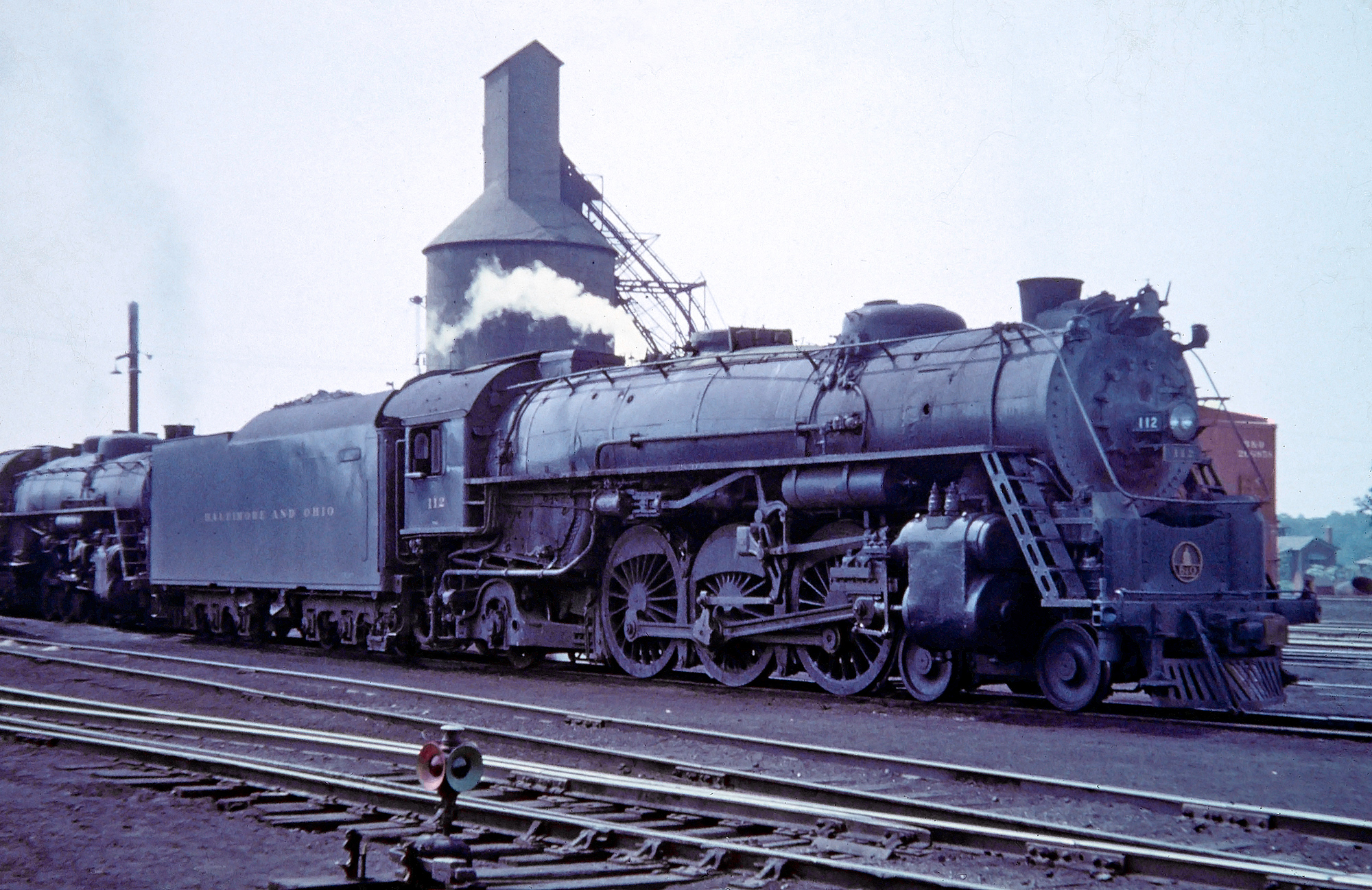 Baltimore & Ohio 4-6-2 #112 (P-7e) is seen here in Garrett, Indiana, circa 1957. This locomotive was formerly #5312, named the "President Pierce," part of the B&O's "President" class of Pacifics. By this date the engine had been renumbered for newly arriving diesels and would be off the roster within the year. Fred Byerly photo. American-Rails.com collection.
Baltimore & Ohio 4-6-2 #112 (P-7e) is seen here in Garrett, Indiana, circa 1957. This locomotive was formerly #5312, named the "President Pierce," part of the B&O's "President" class of Pacifics. By this date the engine had been renumbered for newly arriving diesels and would be off the roster within the year. Fred Byerly photo. American-Rails.com collection.The P-1's were the B&O's most heavily modified class as most future Pacifics more or less carried the same (or similar) designation. In 1913 the railroad went back to Baldwin for more, this time listed as Class P-3 and numbered 5100-5129.
These were also considered heavy Pacifics, working similar territories as the P-1's, as were the P-4's of 1917 (5130-5139). The Class P-5's and P-6's, built between 1919 and 1923, were based from the USRA light Pacific design.
Then, there was the Class P-7's. All of the B&O's 4-6-2s are remembered for their good looks thanks to a clean, semi-streamlined look and symmetrical appearance (notably a result of evenly spaced drivers and a centered headlight, number-board, and "B&O" logo on the smokebox).
This was especially true for the P-7's, which arrived from Baldwin in 1927 numbered 5300-5319.
Presidential Class
The locomotives became known as the President Class since all twenty were named (and lettered) after the first twenty presidents of the United States. They were also presented in a stunning livery of olive green with gold trim.
A year later the B&O added #5921 (built by its own shop forces), listed as Class P-9, and named President Cleveland. As delivered these Pacific's were the most powerful in the fleet offering the highest axle loadings and tractive efforts, among other advantages.
Starting in 1942 the B&O began phasing out the President Class, returning them to standard black and without names.
Streamlined P-7's
A few, however, garnered additional special treatment; #5301-5304 were overhauled and streamlined in 1946 for the new Cincinnatian serving Cincinnati and Washington, D.C./Baltimore.
The streamlining, which featured a two-tone royal blue livery with silver trim and simple shrouding covering the entire locomotive was designed by the B&O's own Olive Dennis, a female engineer.
The locomotives were then designated as Class P-7d and continued to carry their handsome look after the Cincinnatian was transferred to the Detroit - Cincinnati route where they remained until retired in the mid-1950s.
After World War II the Pacific's still in service were a hodgepodge of numbers and class designations as the B&O retired more and more.
A few (all Class P-7's) survived as late as 1958, remaining in service long enough to sport such upgrades as Timken roller bearings and a new 100 numbering series to make room for more diesels.
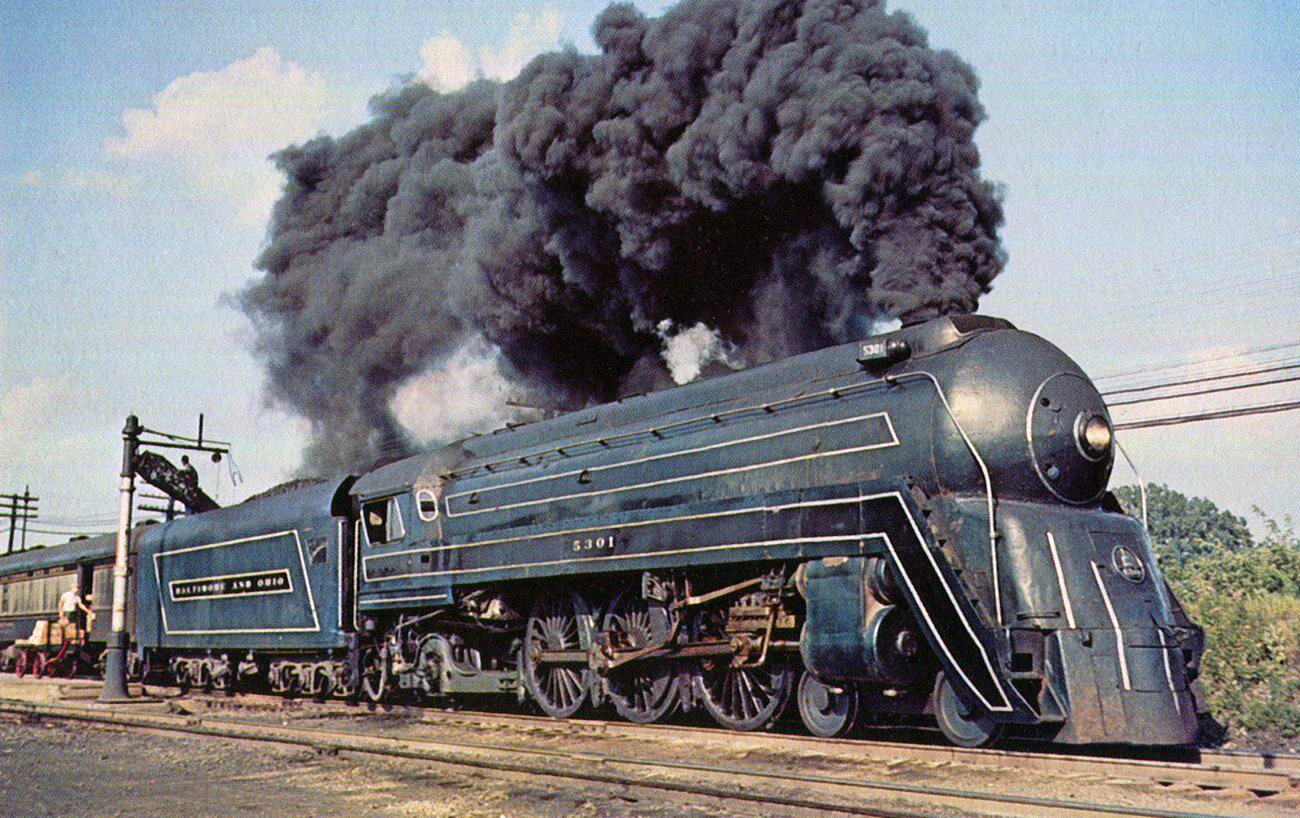 One of the B&O's four handsome Class P-7d's, #5301, makes a station stop at Deshler, Ohio with the westbound/southbound "Cincinnatian," in July, 1956. This was the later version of the train which operated between Cincinnati and Detroit. Steam was in its twilight powering this train. Don Wood photo.
One of the B&O's four handsome Class P-7d's, #5301, makes a station stop at Deshler, Ohio with the westbound/southbound "Cincinnatian," in July, 1956. This was the later version of the train which operated between Cincinnati and Detroit. Steam was in its twilight powering this train. Don Wood photo.Preservation
Given the Baltimore & Ohio's financial state, only one 4-6-2, of more than 200, survives today; #5300 was the first of the Presidents, named George Washington, and given to the B&O Railroad Museum in Baltimore following her retirement where she still resides today.
It should be worth mentioning that the B&O operated a handful of other 4-6-2s; in 1910 it purchased a batch of five (501-505) from Alco for subsidiary Cincinnati, Hamilton & Dayton.
It went back to Alco in 1924 for more, sub-lettered for subsidiary Cincinnati, Indianapolis, & Western numbered 121-124.
Finally, it picked up 22 others with its purchase of the Buffalo, Rochester & Pittsburgh in 1932. The BR&P; listed theirs as Class WW/-2 but after the B&O takeover were merged into the Class P's. They were smaller and not quite as powerful as the B&O's originals and all were retired by 1953.
Class Q (2-8-2)
The 2-8-2 Mikado became the preferred steam locomotive in freight assignments for many railroads starting at the turn of the 20th century. The Baltimore & Ohio employed its first in service after 1910, listing them under the Class Q heading.
In the following years the B&O came to own several hundred 2-8-2s either by purchasing them directly from the Baldwin Locomotive Works or inheriting others through a number of smaller, subsidiary railroads.
Additionally, as per usual B&O custom many were rebuilt and upgraded over the years with several sub-classes (although not quite as confusing as the Pacifics).
The Mikado was the workhorse on the B&O, ranging far and wide across its vast network in whatever assignment it was needed; usually this meant pulling freight trains but it also handled passenger consists as well.
Today, just one survives, Q3 #4500 at the Baltimore & Ohio Railroad Museum. It was the first USRA locomotive manufactured by Baldwin in 1918.
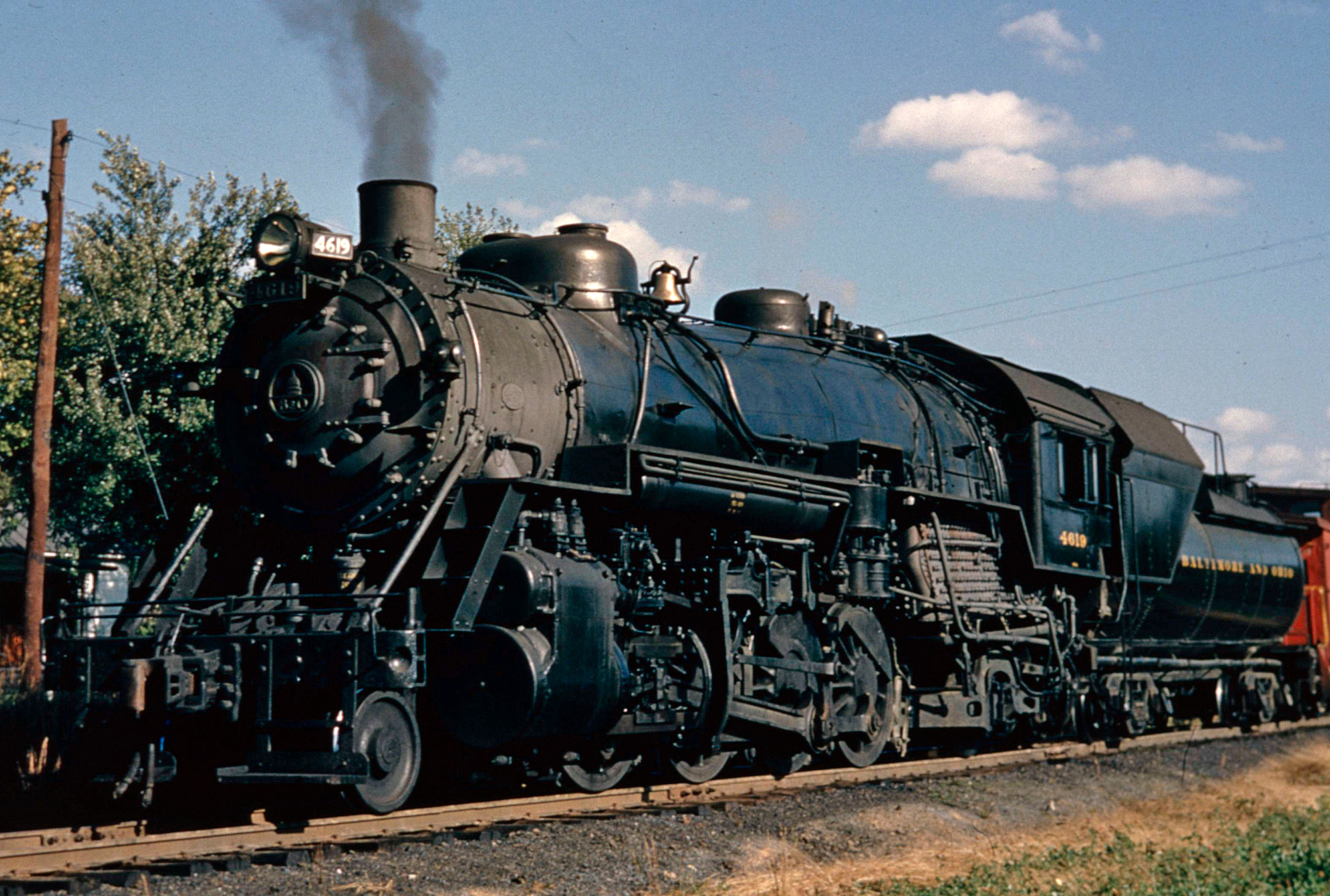 Baltimore & Ohio 2-8-2 #4619 (Q-4b) is seen here in service during the mid-1950s. The location is not listed and these Mikados roamed far and wide across the B&O network. This particular unit was a 1923 product of Baldwin and used in dual service assignments. American-Rails.com collection.
Baltimore & Ohio 2-8-2 #4619 (Q-4b) is seen here in service during the mid-1950s. The location is not listed and these Mikados roamed far and wide across the B&O network. This particular unit was a 1923 product of Baldwin and used in dual service assignments. American-Rails.com collection.The 2-8-2 first saw service in 1887 on Japan's Nippon Railway; its name "Mikado" comes from the Japanese term for emperor.
During the 1890s U.S. railroads first began experimenting with the wheel arrangement although a true, 2-8-2 first went into service on the short line Bismarck, Washburn & Great Falls Railway in 1903 (another Baldwin product).
This was followed soon after by the Northern Pacific in 1905, which is often credited with kicking off the Mikado as a general road service locomotive across the railroad industry.
As for the Baltimore & Ohio, it was regularly experimenting with new wheel arrangements and always looking for a more efficient design to handle the stiff and difficult eastern mountain grades on its main line through Maryland, West Virginia, and western Pennsylvania.
Implementation
During 1911 the railroad put its first Mikados into service; these were home-built at its well-known Mt. Clare Shops in Baltimore.
Using two former 2-8-0 Consolidations shop forces extended the boiler via a larger frame, increased the cylinder diameter and drivers, and added a trailing truck.
Other upgrades included the addition of superheating and a change in the valve gear. The new 2-8-2s were given road numbers 4160-4161 with a rather odd listing as "Class Q odd."
Later that year the B&O also began receiving brand new Mikados; these were listed as Class Q-1 and included a fleet of 160 units numbered 4000-4159.
More were ordered in 1912, sub-classed as Q-1b and numbered 4170-4219. Finally, another 110 arrived a year later, numbered 4220-4329 and given Class Q-1c.
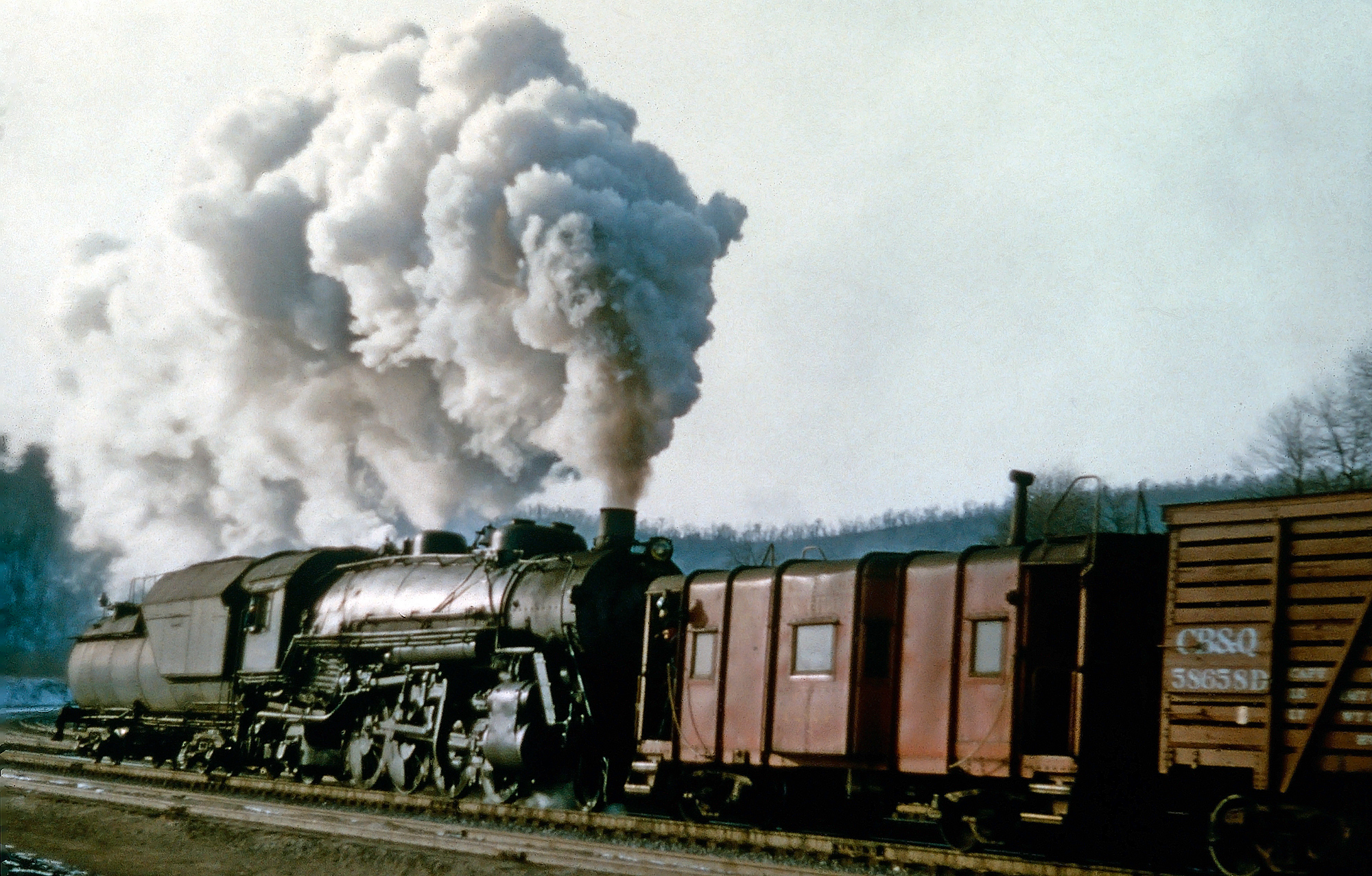 A Baltimore & Ohio 2-8-2 assists a freight over Sand Patch, circa 1955. American-Rails.com collection.
A Baltimore & Ohio 2-8-2 assists a freight over Sand Patch, circa 1955. American-Rails.com collection.Most of these locomotives offered similar levels of power and tractive although the Q-1b's and Q-1c's included a somewhat higher axle loading.
During 1918 and through 1919 the B&O received the standard USRA light Mikados, listed as Class Q-3 and given numbers 4500-4599.
The final, new 2-8-2s designed and built exclusively for the B&O were the Class Q-4's of 1921. These locomotives, numbered 4400-4499 and 4600-4634, were received through 1923 offering the greatest tractive efforts and axle loadings of any 2-8-2s the B&O owned with 64 inch drivers.
Every new Mikado the railroad purchased, even the USRA standard design were all built by Baldwin, the B&O's favored steam manufacturer.
Aside from these the company also got other 2-8-2s through its purchase of smaller roads including the Buffalo, Rochester & Pittsburgh and Cincinnati, Indianapolis & Western.
Classification
| Model | Builder | Road Number(s) | Date Built | Disposition |
|---|---|---|---|---|
| Class Q odd | Baldwin | 4160-4161 | 1911 | Scrapped, 1949 |
| Class Q-1 | Baldwin | 4000-4159 | 1911 | Scrapped, 1955 |
| Class Q-1b | Baldwin | 4170-4219 | 1912 | Scrapped, 1955 |
| Class Q-1c | Baldwin | 4220-4329 | 1913 | Scrapped, 1941 |
| Class Q-3 (USRA Light) | Baldwin | 4500-4599 | 1918-1919 | Scrapped, 1959 |
| Class Q-4 | Baldwin | 4400-4444 | 1920 | Scrapped, 1959 |
| Class Q-4a | Baldwin | 4445-4449 | 1921 | Scrapped, 1959 |
| Class Q-4b | Baldwin | 4450-4499 | 1922 | Scrapped, 1959 |
| Class Q-4d | B&O; | 4635-4637 | 1941-1942 | Scrapped, 1955 |
The Q-4's also were equipped with steam boilers allowing them to be used in passenger service. As with its Pacifics and habit of experimentation the B&O updated a number of its Mikados over the years (which crews often referred to as simply "Qs").
Most of these projects tended to be done on the Q-1's; many were rebuilt with super-heaters, larger fireboxes, cylinders (among other improvements), and given sub-classes as Q-1b's, Q-1c's, Q-1aa's, Q-1ab's, etc.
Additionally, others of this class were rebuilt into either Pacifics or upgraded as Class T 4-8-2 "Mountains." During World War II the B&O, in a stance of patriotism against the empire of Japan renamed its 2-8-2s as "MacArthurs" (the famous World War II general).
Interestingly, though, this designation didn't seem to take well with train crews many of whom continued to refer to them as either "Mikes" or "Qs."
Wherever one went across the B&O system a 2-8-2 was sure to be seen; they operated on rural West Virginia branch lines lugging long strings of coal trains or hustled mixed freights across the flat, bucolic farmland of Indiana.
In other scenes the Class Q's would depart Chicago's Grand Central Station with an important passenger consist or operated in helper service over the fabled grades of the West End (such as at Sand Patch, Pennsylvania).
The Mikes were certainly the B&O's workhorses during steam's late-era fielding any type of secondary service asked of them. As diesels continued to replace steam the 2-8-2s began to see retirement as early as 1941.
Retirement
This continued rapidly following the war as railroads were able to buy new diesels unimpeded, purchasing models like the Electro-Motive's F3 and F7 cab units, and then later the GP7 and GP9 road-switchers.
According to records it seems that most of the B&O's Mikados met their fate between the late 1940s and around 1955.
However, some of the Class Q-4's could still be found in service as late as 1959 along with a few of the former BR&P 2-8-2s (then classed as Q-10's).
Today, only one of the railroad's sturdy and rugged Mikes survived, Class Q-3 #4500 which is now at the B&O Railroad Museum in Baltimore. This unit was one of the standard USRA light designs as unfortunately none of the B&O originals like the Q-1's and Q-4's were preserved.
Class T (4-8-2)
The B&O operated some of the finest steam locomotives of any railroad ranging from its 2-8-8-4 Class EM-1 Yellowstones to their beautifully designed 4-6-2 Pacifics. Another of these included its fleet of Class T 4-8-2 Mountains.
Well crafted and engineered machines many were built at the B&O''s own Mt. Clare Shops in Baltimore after early tests on the wheel arrangement proved successful in the 1920s. The railroad initially intended the 4-8-2s for use in heavy passenger service along the stiff grades of the West End.
However, in later years it designed or purchased others for use in freight assignments, a task for which they were just as capable.
Many Mountains remained in regular service all over the B&O's vast system from Baltimore to Chicago until the mid-1950s and unfortunately, none were preserved.
While relatively inconsequential, the B&O is often recognized for the simple beauty of their common steam designs; most carried clean lines, few interruptions along the boiler, centered-headlight, and symmetrical pilot. They were aesthetically pleasing, which included their 4-8-2's. The locomotives looked good leading a train!
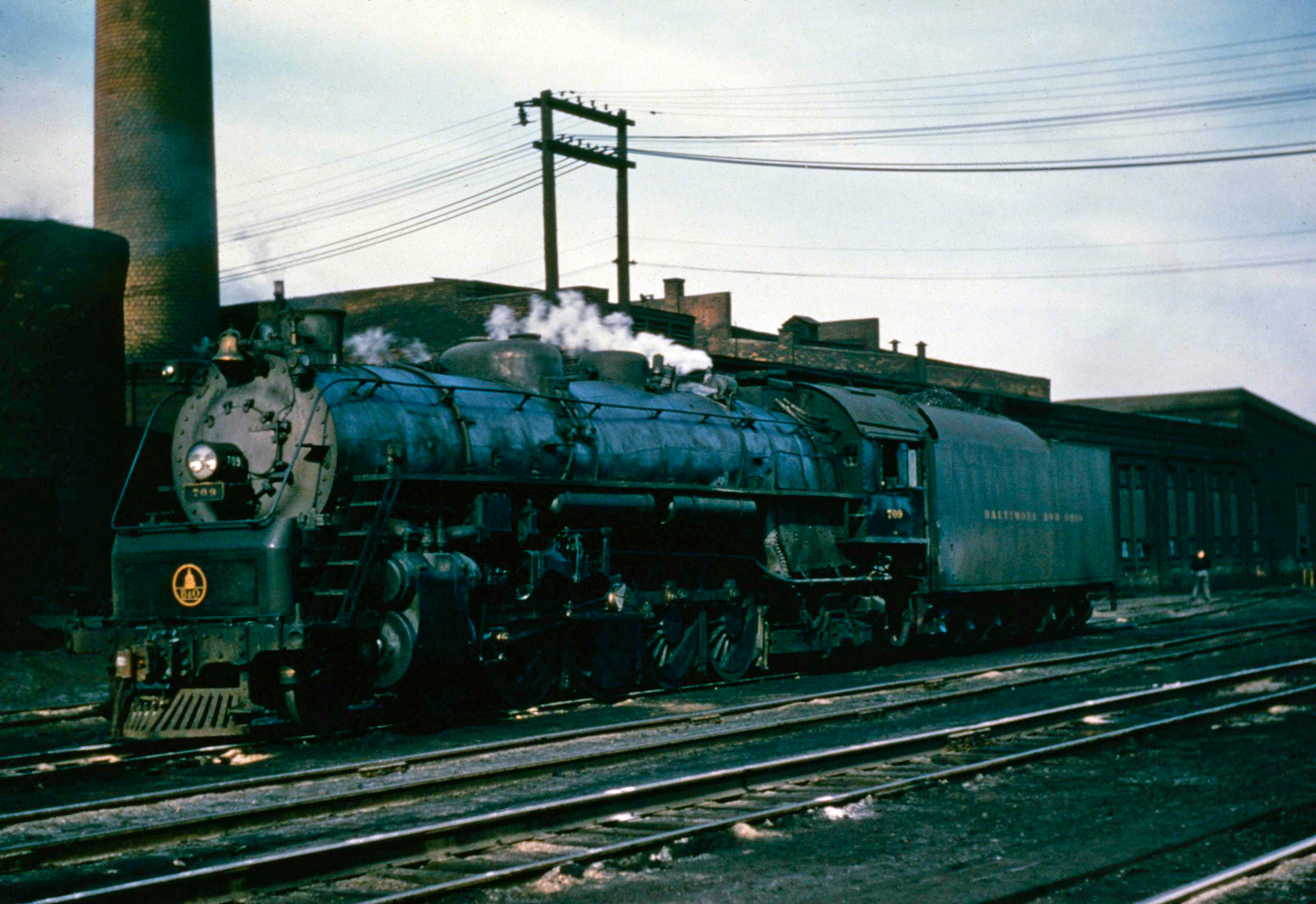 Baltimore & Ohio 4-8-2 #709 (built as #5568) is seen here near the roundhouse in Willard, Ohio on March 31, 1957. That year the B&O renumbered its remaining Mountains to make room for incoming diesels. American-Rails.com collection.
Baltimore & Ohio 4-8-2 #709 (built as #5568) is seen here near the roundhouse in Willard, Ohio on March 31, 1957. That year the B&O renumbered its remaining Mountains to make room for incoming diesels. American-Rails.com collection.Since the early 20th century the Baltimore & Ohio had been relying on its fleet of Class P 4-6-2s to do the job of hustling passenger trains all across the system as they offered a good balance of power and speed.
However, by the early 1920s with the increased use of steel in car construction and a growing demand for rail travel the B&O needed something more powerful. The 4-8-2 Mountain was first put into service on the Chesapeake & Ohio in 1911.
They were designed for the very reason the B&O expressed interest in them, the C&O needed something with more muscle to move passenger trains along its main line through the mountains of western Virginia and southern West Virginia.
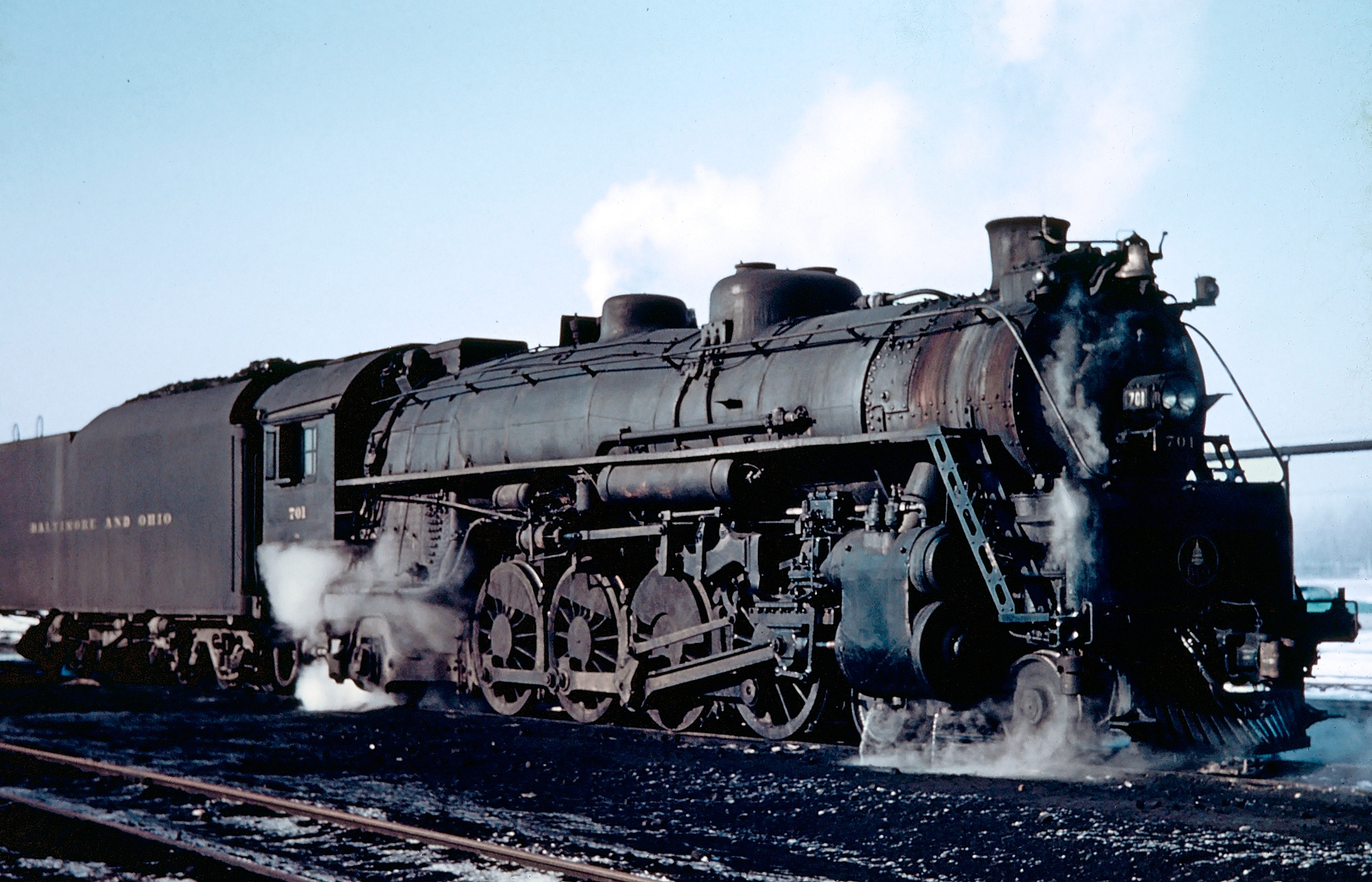 One of the B&O's Class T3 4-8-2s, #701, is seen here in Chicago, circa 1958. This Mountain was originally #5557, manufactured by the Mount Clare Shops in 1942. It was renumbered in 1956 to make room for incoming diesels. Fred Byerly photo. American-Rails.com collection.
One of the B&O's Class T3 4-8-2s, #701, is seen here in Chicago, circa 1958. This Mountain was originally #5557, manufactured by the Mount Clare Shops in 1942. It was renumbered in 1956 to make room for incoming diesels. Fred Byerly photo. American-Rails.com collection.The B&O's first 4-8-2s were built completely from scratch; Mt. Clare shop forces took the boiler from 2-10-2 "Big Six" #6009 and used it to construct Class T 4-8-2 #5500 in 1925.
The locomotive, given the name Lord Baltimore (until 1935), used 74-inch drivers, a tractive effort greater than 65,000 pounds, and was intended for use in passenger service hauling trains along the west end of the Cumberland Division.
A year later in 1926 the railroad built another, #5501 (named Philip E. Thomas after the B&O's first president), which used the boiler of #6030 and saw service over the same territory as its counterpart. While these Mountains performed well enough it wasn't until 1930 that more were added to the fleet.
That year the B&O's General Superintendent of Motive Power & Equipment, George Emerson, wanted to test the practicability of a water-tube firebox.
To do so he ordered two 4-8-2s from the Baldwin Locomotive Works; one, numbered 5510 and listed as Class T-1 used a water-tube firebox while another, carrying #5550 and given the designation as Class T-2 used a standard firebox.
Unfortunately, Emerson was never able to complete his study but these pair of Mountains remained in regular service on the B&O until the 1950s. The next batch of 4-8-2s were built specifically for high-speed freight service to help keep up with war demands according to David Mainey's, "Baltimore & Ohio Steam In Color."
The locomotives were again constructed at Mt. Clare and the first were outshopped in 1942 using boilers from older Class Q-1 Mikados and P-1 Pacifics; listed as Class T-3 they sported 70-inch drivers with about the same tractive effort as the earlier types.
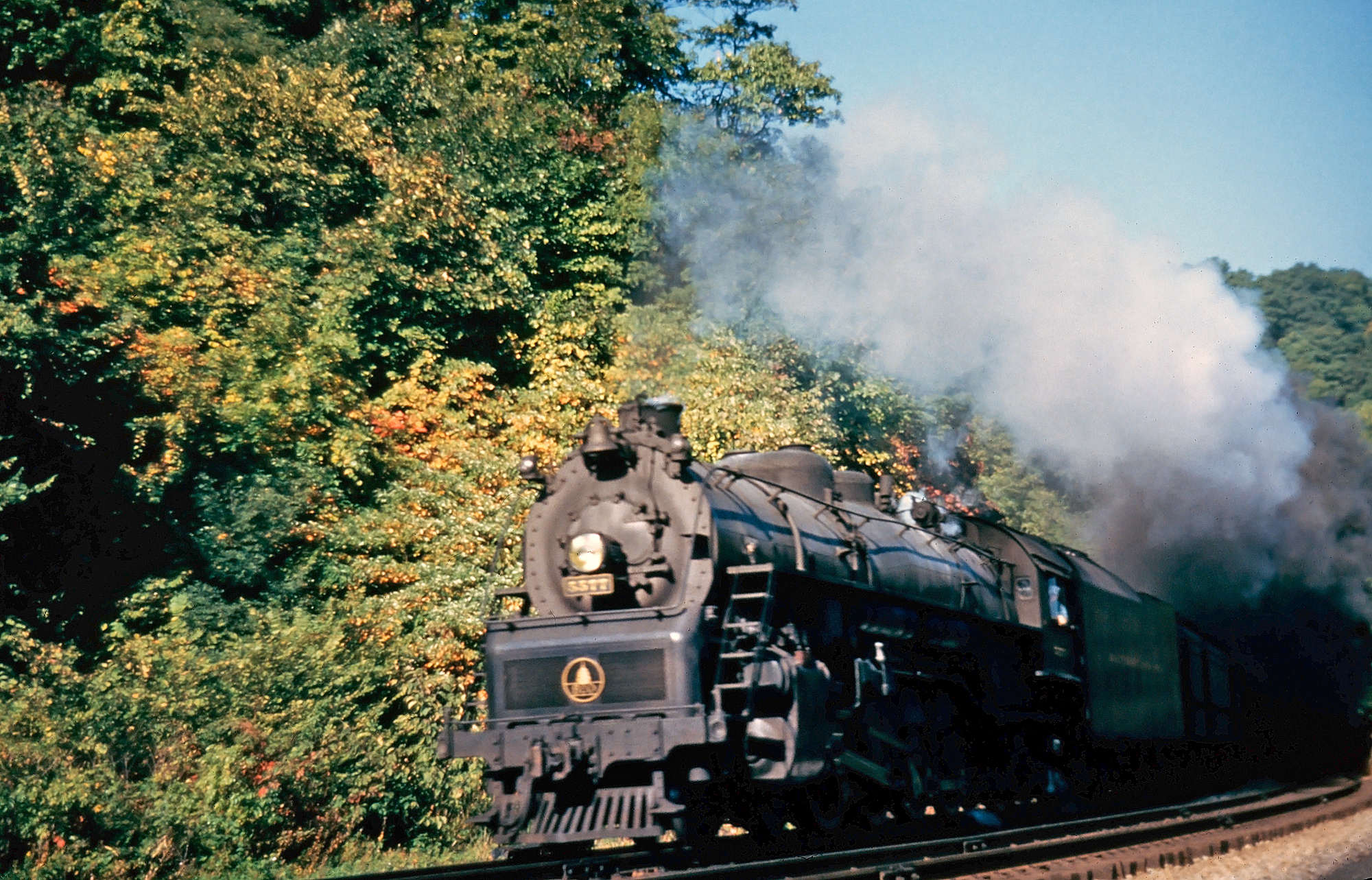 Baltimore & Ohio 4-8-2 #5577 (T-3b) exits Randolph Tunnel along the Magnolia Cutoff with an eastbound passenger consist, circa 1955. American-Rails.com collection.
Baltimore & Ohio 4-8-2 #5577 (T-3b) exits Randolph Tunnel along the Magnolia Cutoff with an eastbound passenger consist, circa 1955. American-Rails.com collection.As Mr. Mainey notes in his book they could have just as easily been used to pull passenger trains given their power and speed. The T-3 class, as was so common on the B&O, was broken down into several subclasses; only one (#5564) had roller bearings on all axles, which was listed as Class T-3a.
By contrast, the T-3b's used standard friction bearings and the group of T-3c's had roller bearings on all axles (including the tender) except the main drivers.
Finally, there was the curious fleet of T-3t's; these Mountains were distinguished only by their use of tenders, which according to Mr. Mainey's book were of a Vanderbilt design.
Most railroads did not subclass their steam locomotives based on the tender used, since they were often swapped and interchanged among one another. Altogether, seven examples from the three subclasses ("a," "b," and "c") were equipped with these larger tenders and labeled as Class T-3t.
Classification
| Model | Builder | Road Number(s) | Date Built | Disposition |
|---|---|---|---|---|
| Class T | B&O | 5500 ("Lord Baltimore"), 5501 ("Philip E. Thomas") | 1925-1926 | Scrapped, 1953 |
| Class T-1 | Baldwin | 5510 | 1930 | Scrapped, 1951 |
| Class T-2 | Baldwin | 5550 | 1930 | Scrapped, 1952 |
| Class T-3 | B&O | 5555-5563 | 1942-1943 | All Retired By 1960 |
| Class T-3a | B&O | 5564 | 1943 | Retired By 1960 |
| Class T-3b | B&O | 5565-5584 | 1943-1946 | All Retired By 1960 |
| Class T-3c | B&O | 5585-5594 | 1947-1948 | All Retired By 1960 |
| Class T-4 | Baldwin | 5650-5662 (Ex-Boston & Maine) | 1935 | All Retired By 1958 |
The entire fleet of T-3's could be found roaming over much of the B&O's system pulling freights on the stiff grades of the Cumberland and Monongah Divisions as well as working further west into the flatter territory of the Akron and Chicago Divisions.
The final class of Mountains were the T-4's. These locomotives were handsome machines purchased second-hand from the Boston & Maine in 1947, thirteen in all.
With their 73-inch drivers they could also just have easily been used in passenger service although the B&O assigned them to the gentle grades of the Chicago and Akron Divisions where the zipped timed freights incredibly fast through the Midwest's farmlands.
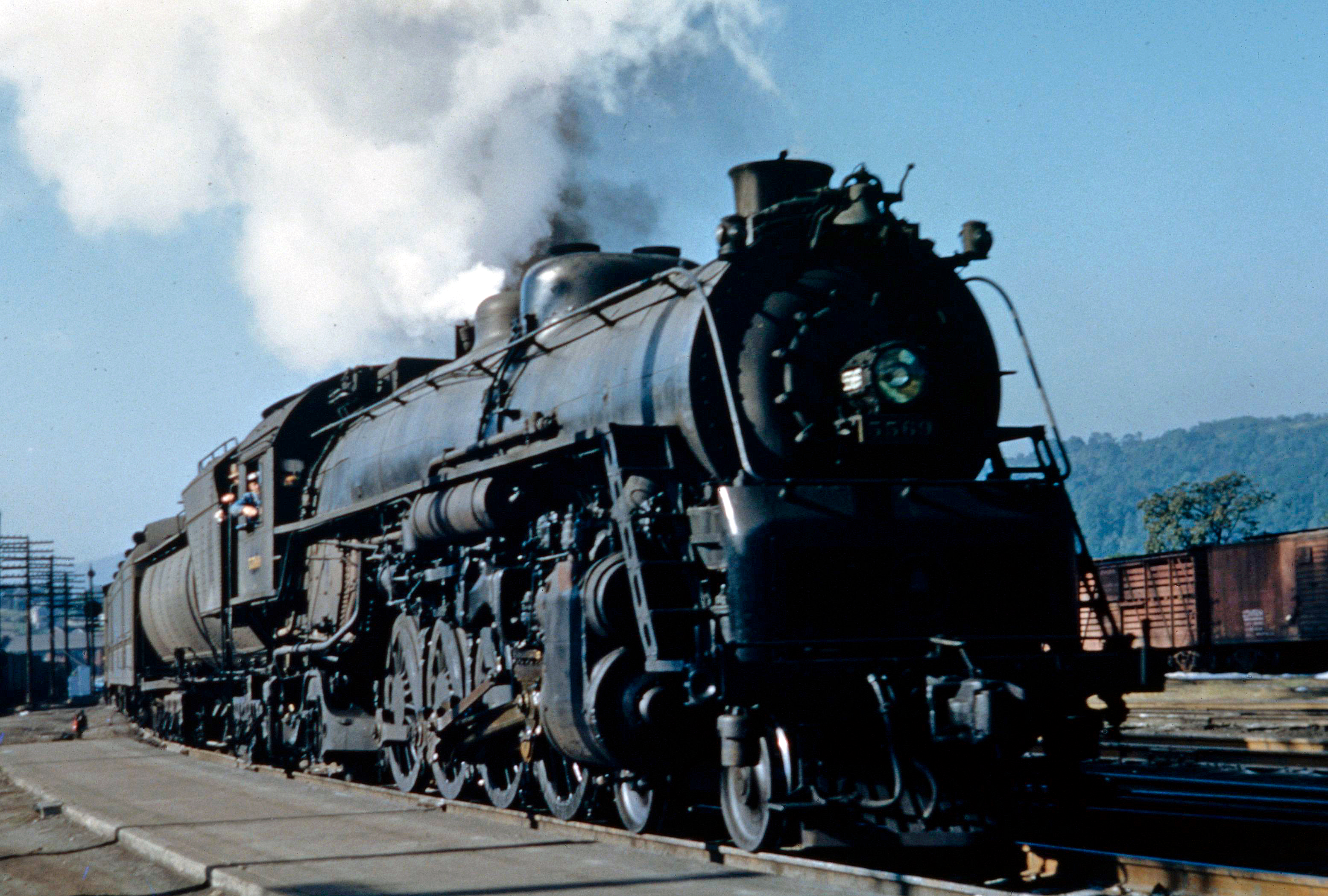 Baltimore & Ohio 4-8-2 #5569, arrives at the Queen City Hotel in Cumberland, Maryland with a westbound train during the early 1950s. Likely a Bill Price photo. American-Rails.com collection.
Baltimore & Ohio 4-8-2 #5569, arrives at the Queen City Hotel in Cumberland, Maryland with a westbound train during the early 1950s. Likely a Bill Price photo. American-Rails.com collection.Interestingly, the T-4's were, according to Mr. Mainey's book "...12% heavier, sported larger drivers and cylinders, and had a higher boiler pressure than the T-3's."
During November of 1956 the B&O embarked on a complete renumbering of its remaining steam fleet to make room for its growing volume of diesels.
The railroad's 4-8-2s were given the 700 series although not all had survived until that time; only eight examples of the T-4's were still in service by then.
In any event, the B&O's Mountains survived longer than most of its other main line steamers; the last T-4 was finally scrapped in 1958 while the T-3's could still be found performing limited duties for another year.
It's a shame none of the B&O's own 4-8-2s were preserved; they were well-built, fast, and great-looking locomotives that performed any task they were assigned.
Class V (4-6-4)
The 4-6-4 wheel arrangement is best known on the New York Central, which designed the locomotive and came to own a sizable fleet of beautifully designed machines.
The Baltimore & Ohio as it turns out, which is never really known for operating Hudsons, did utilize a small fleet for passenger service. They were listed as Class V and constructed by the railroad's own shop forces in Mount Clare during the mid-1930s.
The locomotive's were equipped with a specialized firebox designed by a noted company engineer and were considered successful while in service. They remained on the B&O's roster until 1950 when all were retired and eventually scrapped.
The 4-6-4 was a popular arrangement on many roads, such as the Milwaukee Road, Chicago & North Western, New York Central, and Santa Fe. The B&O, however, had little interest in the design. Instead, it utilized primarily 4-6-2's and 4-8-2's on passenger assignments until the diesel era.
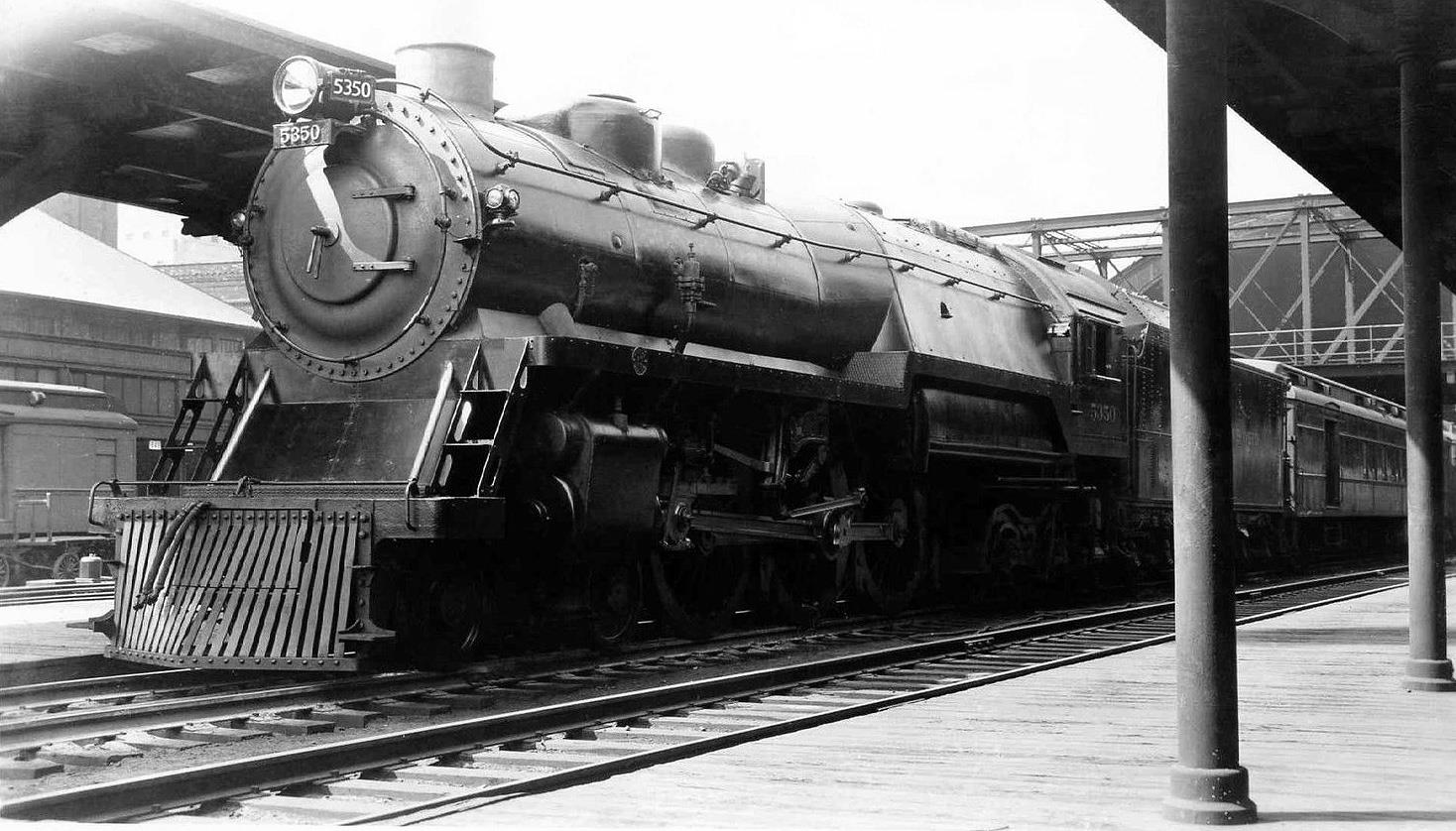 Baltimore & Ohio 4-6-4 #5350 (V-3), which carried a European-like streamlining. The railroad owned a total of four, the second of which (#5340, Class V-2) was named "Lord Baltimore" and assigned to the "Royal Blue" (Baltimore - New York). The B&O's Hudsons used an interesting watertube firebox patented by General Superintendent of Motive Power & Equipment, Colonel George H. Emerson.
Baltimore & Ohio 4-6-4 #5350 (V-3), which carried a European-like streamlining. The railroad owned a total of four, the second of which (#5340, Class V-2) was named "Lord Baltimore" and assigned to the "Royal Blue" (Baltimore - New York). The B&O's Hudsons used an interesting watertube firebox patented by General Superintendent of Motive Power & Equipment, Colonel George H. Emerson.It's tough to argue that the New York Central fielded some of the most gorgeous Hudsons ever put into service. Who can ever forget those iconic Class J3a's styled by Henry Dreyfuss to pull the initial version a streamlined 20th Century Limited.
Some other roads to field fleets of classic 4-6-4s included the Canadian Pacific's Royal Hudsons, Chicago & North Western's Class E-4's, the Milwaukee Road's lightening fast Class F-7's which headed the streamlined Hiawathas, and the Wabash's small fleet of Class P1's.
Colonel George H. Emerson
The Baltimore & Ohio's use of the Hudson was much more subtle, and some reading this may not even be aware the railroad ever owned any. As was typical, and in many ways expected on the B&O, the locomotive's carried an elegance and grace albeit were perhaps not the most beautiful designs it ever owned.
However, interestingly their use came about in part due to a newly patented firebox by the railroad's General Superintendent of Motive Power & Equipment, Colonel George H. Emerson.
He had joined the B&O during March of 1920 and before he left the company became revered for his work with steam power. During 1927 Emerson employed the first use of a watertube firebox in a locomotive when the B&O's Mount Clare Shops in Baltimore rebuilt a Consolidation into a Mikado.
A year later it did the same with a Class P-7 Pacific named the President Cleveland (part of the fabled President's Class). The watertube design was inspired by similar devices used in marine ships and stationary power plants.
According to Kirk Reynold's and Dave Oroszi's book, "Baltimore & Ohio Railroad," they differed from a "...conventional locomotive firebox in that boiler water circulated through a series of tubes that were arranged vertically at the sides of the firebox, thus eliminating staybolts and crown sheets."
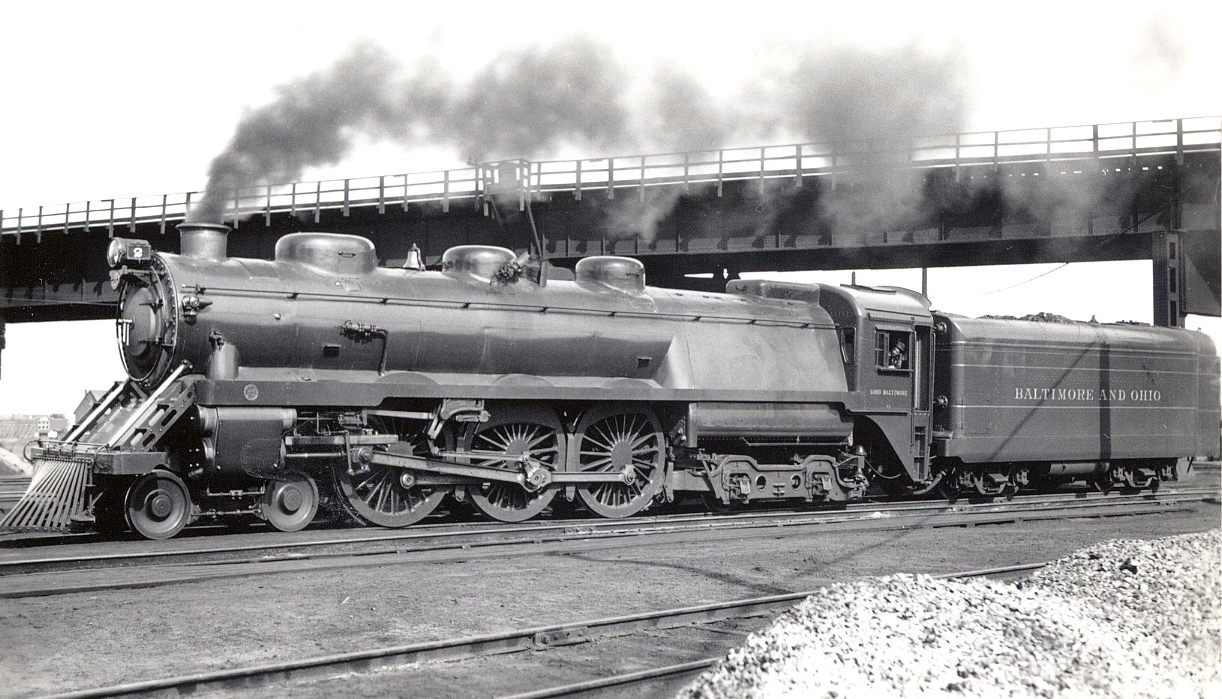 The B&O's "Lord Baltimore" is seen here soon after entering service. The locomotive carried the largest drivers of any Hudson the B&O operated (84 inches).
The B&O's "Lord Baltimore" is seen here soon after entering service. The locomotive carried the largest drivers of any Hudson the B&O operated (84 inches).Unfortunately, it proved problematic for railroad applications since a locomotive's steam requirements were constantly changing while in service an issue normally absent from ships and plants.
As for Emerson's design it was a hybrid between a standard firebox and a true, watertube version. He officially received a patent for it during January of 1928.
The Baltimore & Ohio would ultimately employ the firebox in three different wheel arrangements, one of which was the 4-6-4 Hudson.
The first was outshopped in 1933 using a rebuilt Class P-1c 4-6-2. It was listed as Class V-1 and given number 5047. Through 1936 three others were added to the fleet although they were constructed new by shop forces, Class V-2 through V-4.
Classification
| Model | Builder | Road Number(s) | Date Built | Tractive Effort | Drivers | Disposition |
|---|---|---|---|---|---|---|
| Class V-1 | B&O | 5047 | 1933 | 52,000 Pounds | 74 Inches | Scrapped, 1950 |
| Class V-2 | B&O | 5340 | 1935 | 34,000 Pounds | 84 Inches | Scrapped, 1949 |
| Class V-3 | B&O | 5350 | 1935 | 52,000 Pounds | 80 Inches | Scrapped, 1950 |
| Class V-4 | B&O | 5360 | 1936 | 52,000 Pounds | 80 Inches | Scrapped, 1950 |
The second Hudson, numbered 5340, was semi-streamlined and named Lord Baltimore where it found work pulling the B&O's elegant and newly lightweight Royal Blue between Baltimore and New York.
The third and fourth in the series were put into service between 1935-36 and could often be found hustling passenger trains anywhere along the Cumberland, Pittsburgh and Akron Divisions.
All of the Hudsons carried large main drivers (between 74 and 84 inches) allowing them to cruise at high speeds.
Retirement
The B&O's 4-6-4s were considered successful locomotives although Emerson was never able to fully complete his watertube firebox tests. The locomotives continued to pull passenger trains until 1949-1950 when all four were retired and eventually scrapped.
It could be reasonably argued that the B&O's Hudsons were not the most aesthetically pleasing steam locomotives it ever produced, a result of the big watertube fireboxes they employed.
While the steamers did carry semi-streamlining their appearance was more closely associated with English-built designs that carried a no-frills, utilitarian look.
The railroad constructed a few other locomotives this way, its one and only example of a 4-4-4-4 Duplex Drive (#5600), as well as the 4-4-4 "Lady Baltimore." In any event, this is purely rhetorical.
Sadly, no examples of Emerson's watertube designs were ever preserved (others included the previously mentioned Duplex and Pacific, a Mikado, a pair of 4-8-2s, and a pair of 2-6-6-2 Mallets) and he left the company during January of 1942.
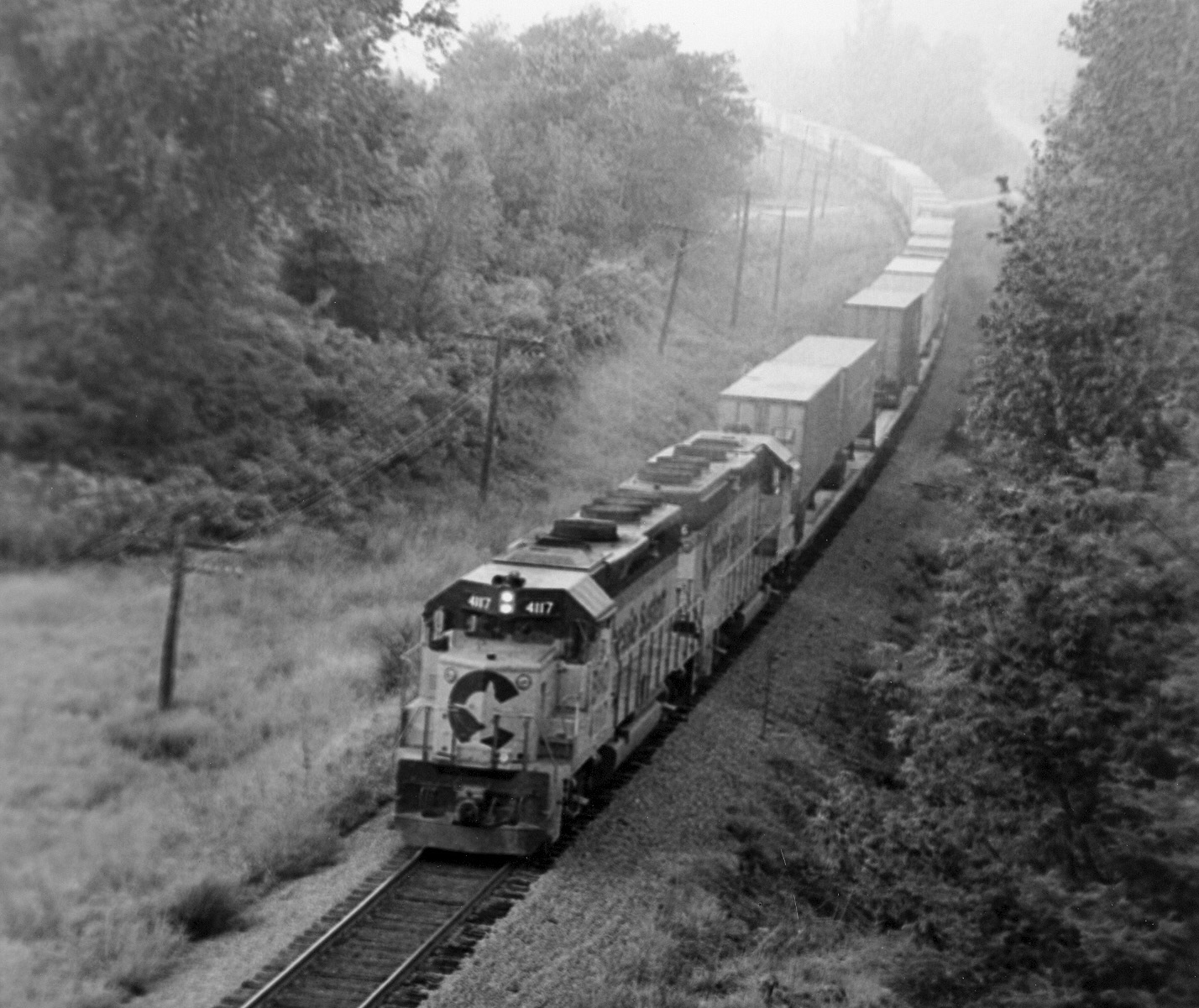 A pair of Chessie System/B&O GP40-2's lead an eastbound hotshot "Philadelphia Trailerjet" along the St. Louis main line near Porterfield, Ohio in June of 1981. Today, this right-of-way lies empty. Author's collection.
A pair of Chessie System/B&O GP40-2's lead an eastbound hotshot "Philadelphia Trailerjet" along the St. Louis main line near Porterfield, Ohio in June of 1981. Today, this right-of-way lies empty. Author's collection.While the building of the Baltimore Belt Railroad and its electrified lines helped significantly improve operations in and around Baltimore the project was extremely expensive and forced costly debt on the railroad that helped drive it into bankruptcy in 1896.
Even though the B&O updated its electric fleet from 1909 through 1912, and again between 1923-1927, with diesel-electric locomotives efficient and affordable by the mid-20th century the railroad shut down its electrification in the early 1950's.
Interestingly, today the original Baltimore Belt Railroad remains an important artery under the CSX Transportation banner.
Perhaps Mike Schafer said it best in his book, "Classic American Railroads": although the B&O was never a healthy and extremely profitable railroad it will forever be remembered for:
"...its pioneer spirit, determination in the face of adversity, innovative technology, superior service, courteous employees, and aesthetic equipment," which made it beloved by so many throughout the years.
Heritage Unit, CSX #1827
In May, 2023, CSX Transportation release a heritage locomotive in a Baltimore & Ohio-inspired blue and grey livery, ES44AH #1827.
Timetables (1952)
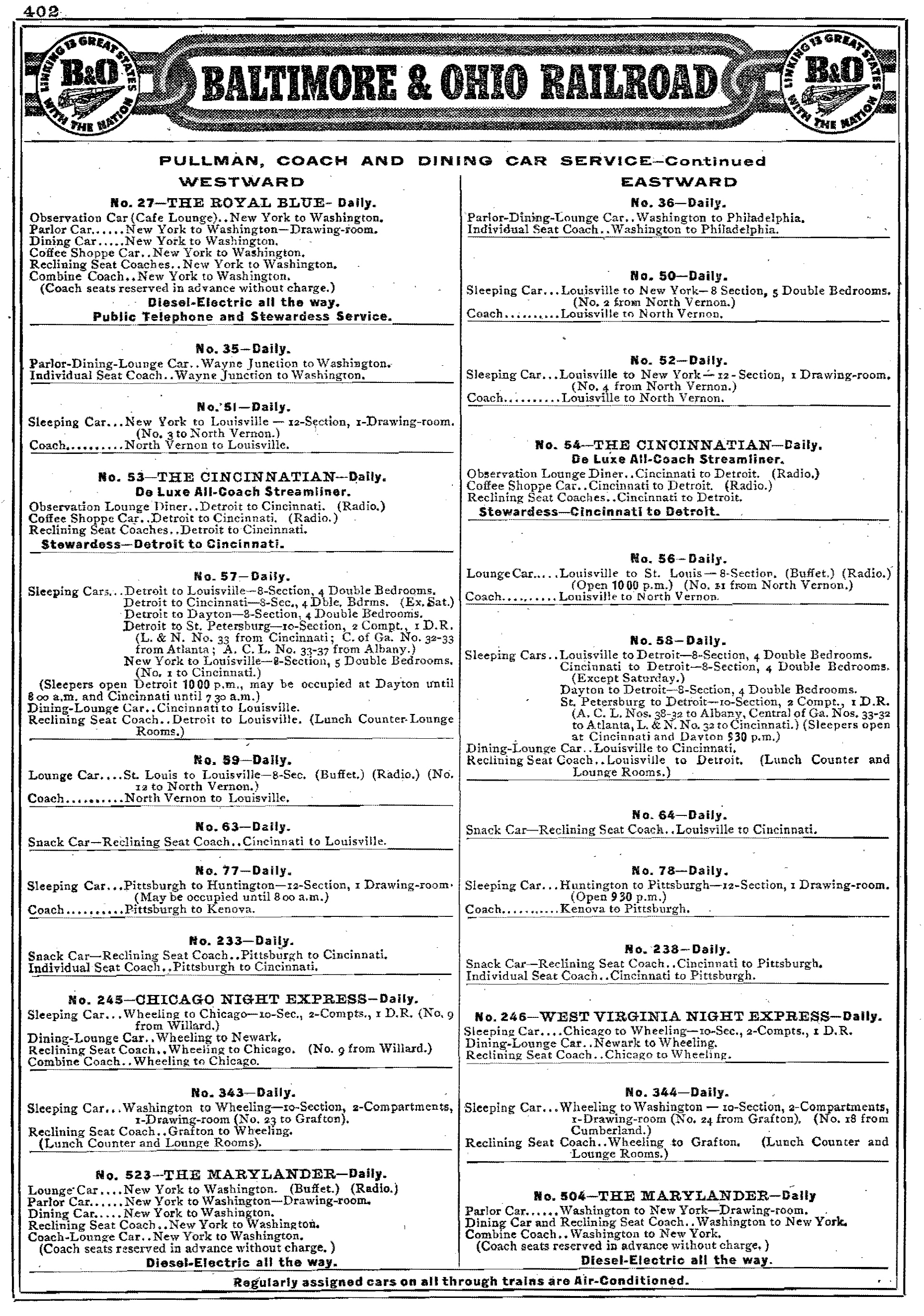
Sources
- Kirkland, John F. Diesel Builders, The: Volume One, Fairbanks-Morse And Lima-Hamilton. Glendale: Interurban Press, 1985.
- Kirkland, John F. Diesel Builders, The: Volume Two, American Locomotive Company And Montreal Locomotive Works. Glendale: Interurban Press, 1989.
- Kirkland, John F. Diesel Builders, The: Volume Three, Baldwin Locomotive Works. Pasadena: Interurban Press, 1994.
- Liljestrand, Robert A. and Sweetland, David R. Baltimore & Ohio Diesel Locomotives: Volume 1, Switchers & Road Switchers.
- Mainey, David. Baltimore & Ohio Steam In Color. Scotch Plains: Morning Sun Books, 2001.
- Reynolds, Kirk and Oroszi, David. Baltimore & Ohio Railroad. Osceola: MBI Publishing, 2000.
- Schafer, Mike. Classic American Railroads. Osceola: MBI Publishing, 1996.
- Solomon, Brian. Electro-Motive E-Units and F-Units: The Illustrated History of North America's Favorite Locomotives. Minneapolis: Voyageur Press, 2011.
Contents
- Baltimore & Ohio Chicago Terminal
- Baltimore, Pittsburgh & Chicago
- Buffalo, Rochester & Pittsburgh
- Marietta & Cincinnati Railroad
- Northwestern Virginia Railroad
- Pittsburgh & Connellsville Railroad
- Ohio & Mississippi Railway
- Ohio River Rail Road
- Virginia Extension
Recent Articles
-
Gulf & Mississippi Railroad: The First Regional
Nov 23, 24 02:46 PM
The Gulf & Mississippi Railroad was the first regional railroad formed in the U.S. when Illinois Central Gulf spunoff 713 miles in 1985. It was acquired by MidSouth Rail in 1988. -
MidSouth Rail Corporation: An ICG Spinoff
Nov 22, 24 08:32 AM
MidSouth Rail was one of Illinois Central Gulf's many large spinoffs in the 1980s as the company attempted to streamline operations. It was acquired by Kansas City Southern in 1994. -
The Wrecking Derrick: Railroading's Unsung Hero
Nov 20, 24 12:35 PM
The wrecking derrick was once a vital piece of maintenance-of-way equipment, ensuring rail lines were quickly reopened following an accident or derailment.
